This is an article from the March-April 2020 issue: Movements: God’s Way of Reaching Entire Peoples
March 03, 2020 by Steve Addison
Rapid Mobilization: How the West Was Won
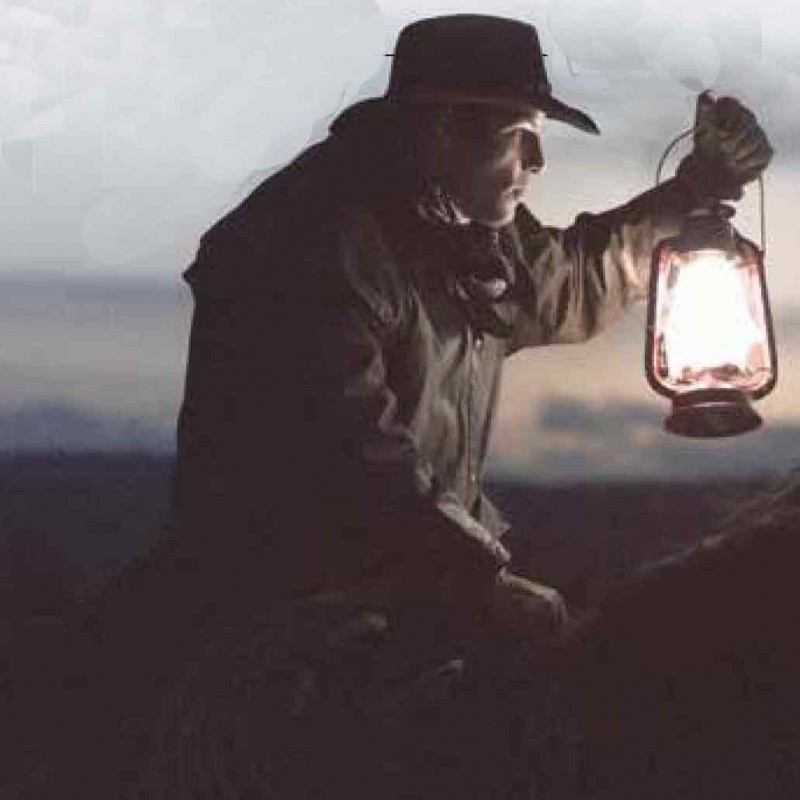
Editor’s Note: On page 15 of this issue we highlight the power of the Methodist Movement in Britain. That nation was transformed by John Wesley and the Methodists as people became members of mandatory small group “class meetings.” They came to know Christ, learned to read by studying the Scriptures and singing hymns, confessed their sins one to another and became frugal, hard working and sober. Through obedience to the Word, they became circuit riders and non-professional pastors to spread the gospel even further. They employed many of the characteristics of the Church Planting Movement methodology of our day to very remarkable effect. The following story tells of the similar impact the Methodist movement had in the United States as the country moved westward. Like the movement in Britain, the movement in the U.S. also began to decline when “class meetings” were no longer required and the Methodists began to require seminary education instead of allowing pastors to rise up from the class meetings. See the sidebar on page 17 for more on this.
When the 26 year-old Methodist pioneer, Francis Asbury, arrived in the American colonies in 1771, he believed he was called to fulfill a great destiny. He was right—although that destiny was far greater than he ever imagined. In 1771 there were only 300 American Methodists, led by four ministers. By the time of Asbury’s death in 1816, Methodism had 2,000 ministers and over 200,000 members in a well-coordinated movement. By 1830 official membership was almost half a million, and the number of actual attenders was six million. Most of these people had no previous church connection before they became Methodists.
Asbury, like his mentor John Wesley, modeled the commitment required to achieve such success. Throughout his ministry Asbury delivered more than 16,000 sermons. He traveled nearly 300,000 miles on horseback. He remained unmarried so that he could devote himself fully to his mission. He was often ill and had no permanent home. He was paid the salary of an ordinary traveling preacher and was still traveling when he died at 70 years of age.
Asbury’s leadership and example inspired an army of circuit riders, many of whom followed his example and remained unmarried. There were no formal vows, but in the early days of the movement the majority of the riders lived by the three rules of the monastic orders: poverty, chastity and obedience. Methodism was a kind of Protestant missionary order under one leader, adapted to reaching isolated communities in harsh conditions across an entire nation.
Jacob Young, a typical circuit rider, was 26 years old in 1802 when he took up the challenge of pioneering a Methodist circuit along the Green River in Kentucky. Young developed his own strategy to evangelize the region. He would travel five miles, find a settlement and look for a family who would let him preach in their log cabin to interested friends and neighbors. Sometimes he found groups already gathered, waiting for a preacher to arrive; in one location he discovered a society run by an illiterate African American slave with impressive preaching and leadership skills. Young established class meetings wherever he went to be run by local leaders in his absence.
Circuit riders like Jacob Young began with limited formal education, but they followed the example of Wesley and Asbury and used their time on horseback for study. They spoke the simple language of the frontier.
They faced ridicule and even violence, with courage and endurance. Above all else they sought conversions. Within a year of his call, Young had gathered 301 new members; for his efforts he received just $30—a cost of ten cents per new member.
In 1776 only 17 percent of the American population was affiliated with any church. By 1850 that number had doubled to 34 percent. Most of the growth was as a result of the gains by the Methodists and Baptists on the frontier. Francis Asbury could never have reached a nation as vast as the United States, no matter how many miles he rode and no matter how many sermons he preached, without rapidly mobilizing young circuit riders like Jacob Young.
The Protestant mainline denominations (Episcopalians, Presbyterians and Congregationalists) failed dismally to keep pace with these Baptist and Methodist upstarts. Having succumbed to a more settled version of the faith and having lost the zeal for evangelism, the message of the mainline denominations became too vague and too accommodating to have an impact.
The clergy of the mainline churches were well educated and refined, drawn from the social elites. At least 95 percent of Congregational, Episcopalian and Presbyterian ministers were college graduates, compared to only 10 percent of the Baptists. As a combined group the mainline denominations had trained 6,000 ministers before the first Methodist minister graduated from a seminary.
Higher education lifted the mainline clergy above the social status of their congregations and turned them into religious professionals. Secularized theological education and social background influenced both the content of their message and how it was delivered.
The clergy preferred to educate their hearers rather than convert them. The clergy’s carefully drafted scholarly sermons did little to stir hearts; they were out of touch with the common people. There also weren’t enough of them; it was not possible to mobilize enough well-educated, well-paid clergy to respond to the challenge of the rapidly expanding frontier. If expansion had been left to the older denominations, American Christianity may have ended up today looking more like the church of Europe—theologically refined, but declining.
So the mainline clergy watched from the safety of the larger towns and cities along the Atlantic seaboard while the Baptists and Methodists moved west. On the frontier it was hard to tell Methodist and Baptist preachers apart. They were ordinary folk with limited education. They spoke the language of the people and preached from the heart about the need for salvation from sin. As they preached, the power of God was not only spoken about, it was experienced. Methodist pioneer Peter Cartwright recalled that, “while I was preaching, the power of God fell on the assembly and there was an awful shaking among the dry bones. Several fell on the floor and cried for mercy.”
The Baptists and the Methodists developed strategies that made it easy for gifted and committed laypeople to take up leadership and go where the people and the opportunities were. Deployment was rapid because very little upfront investment of resources and education was required. Methodist preachers, many of whom were teenagers, were trained on the job as “apprentices” by more experienced workers. They were expected to be continually studying as they traveled. They practiced lifelong learning and graduated the day they died.
The Methodists were centrally governed, whereas the Baptists believed in local autonomy. But in actuality, both movements planted self-governing congregations. The Methodist circuit riders did not have the time to settle down in one place and take control. Their role was to pioneer new works and mobilize local workers to continue the ministry in depth. These self-governing congregations were well suited to rapid multiplication in the frontier culture.
Methodism gave unprecedented freedom to both women and African Americans to engage in ministry. Methodist preachers called the converted to join a growing movement and offered them the opportunity to make a significant contribution—as class leaders, lay preachers or even circuit riders. Some women served as preachers, and many more served as class leaders, unofficial counselors to the circuit riders, network builders and financial patrons.
Large numbers of African American Methodist preachers emerged following the Revolutionary War. Some were well-known public figures. Harry Hosier, probably born a slave, traveled with Asbury and other Methodist leaders and preached to large crowds, both white and black. Methodists and Baptists, unlike the established churches, preached in a way uneducated slaves could understand and affirmed the place of spiritual experiences and emotion. African American preachers played a significant role in shaping the Methodist movement.
The Baptists and Methodists flourished because they mobilized common people to preach the gospel and plant churches wherever there was a need. The Presbyterians, Episcopalians and Congregationalists languished because they were controlled by well-paid clergy who were recruited from the social and financial elite. Early growth was dramatic for the Methodists—from 2.5 percent of the church-going population in 1776 to 34 percent in 1850, with 4,000 itinerant preachers, almost 8,000 local preachers and over one million members. This made them by far the largest religious body in the nation. There was only one national institution that was more extensive: the U.S. government. This achievement would have been impossible without the mobilization of ordinary people—white and black, young and old, men and women—and the removal of artificial barriers to their engagement in significant leadership such as class leaders, local workers and itinerant preachers. Unfortunately, the Methodist rise was short-lived. Whereas before 1840 the Methodists had virtually no college educated clergy among their circuit riders and local preachers, their amateur clergy was gradually replaced by seminary educated professionals who claimed the authority of the church hierarchy over their congregations. Their relative slump began at the same time; by the end of the 19th century the Baptists had overtaken them in numbers.

This is an article from the November-December 2016 issue: 40 Years of the USCWM/Frontier Ventures and the Unreached Peoples Movement
October 31, 2016 by Steve Smith
Vision for a Refugee Kingdom Movement

God is moving in unprecedented ways in our generation in the Muslim world. Too often Western believers are filled with fear at the pictures of refugees crossing the borders of Western nations. Such a view fails to look at this migration from an eternal perspective.
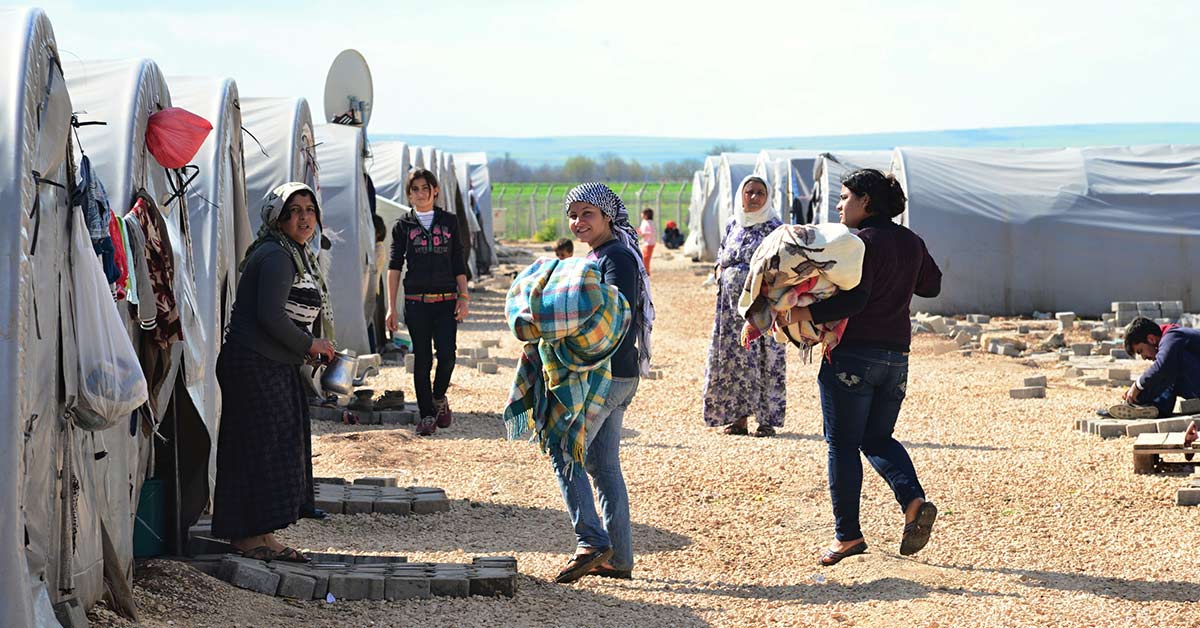
The current migrations are consistent with the ways God has moved throughout history to bring people groups to the knowledge of Christ.
And he made from one man every nation of mankind to live on all the face of the earth, having determined allotted periods and the boundaries of their dwelling place, that they should seek God, and perhaps feel their way toward him and find him. (Acts 17:26-27, ESV, emphasis added)
God has consistently changed the allotted periods and boundaries to bring people to know Him. We should praise the God of heaven in giving a myriad of Muslim people groups open hearts and greater access to the gospel, while at the same time weeping with them at the suffering they endure.
God’s heart is for a kingdom movement to flow through hundreds of refugee locations and then back into the home countries from which they have been thrust—some places difficult or impossible for missionaries to access.
Thousands of evangelists have descended upon Europe the last two years to purposefully bring the gospel to refugees resulting in many salvations. In the excitement of good evangelism, however, what emerges as the dust settles will determine if this becomes a lasting kingdom movement. God’s desire is for disciples and churches, not simply decisions, to multiply throughout the refugee populations, to the surrounding majority populations (e.g. Germans and Greeks) and back into home countries. Will we settle for good evangelism or press into enduring Church-Planting Movements (CPMs)? The latter is God’s heart.
A Case Study
My interactions with the refugee outreach have been to promote the latter (CPM) rather than the former (abundant evangelism). In one country, the Great Commission partners are doing an amazing job of reaching out to refugees with the gospel. They have hosted hundreds of short-term volunteers and the gospel has been shared thousands of times. They have been so busy hosting each team to do evangelism efforts that they have had little time to catalyze the next stages of a CPM—on-going discipleship training, church formation and leadership development. Their effectiveness in doing a good thing (evangelism) threatens the needed shift into the next stage (making disciples who can make disciples, resulting in multiplying churches.)
For three days we worked together on how to translate evangelistic fruit into a kingdom movement. Two weeks later, one Muslim-background believer immediately baptized 18 people and formed two groups into churches. He is making the shift to give enough time to the new disciples, churches and leaders.
What changed in him and others was a sense of the larger vision of what God is doing. Refugee believers have been particularly envisioned by the Joseph account (Gen. 37-50) and find almost exact parallels between Joseph’s journey and theirs. These new disciples stand on the edge of the refugee outreach becoming a Joseph movement.
The Joseph Movement
We may fail to recognize how much of the Genesis account the Joseph narrative takes up. Genesis is painted as follows in broad strokes:
Creation 2 chapters
Fall/Cain 2 chapters
Genealogies 4 chapters
Noah 4 chapters
Abraham 12 chapters
Isaac 2 chapters
Jacob 9-10 chapters
Joseph 14 chapters
In sheer proportion the Joseph story occupies the largest amount of text—14 out of 50 chapters. We rightly accord huge emphasis to the critical stories of Creation/Fall, Noah and Abraham (the father of all who live by faith). But how often do we contemplate the message of the Joseph movement?
Refugee believers are drawn to Joseph because his story gives meaning to their story. It helps to explain what God is doing according to Acts 17:26-27.
The Joseph Movement Parallels
Joseph appears as a prophet in the Quran; Muslims are familiar with his name. But as Muslim-background believers learn the true story from the Old Testament, they find a number of parallels with their situation:
The salvation of many: The theme verse of the Joseph account is Genesis 50:20:
As for you, you meant evil against me, but God meant it for good, to bring it about that many people should be kept alive, as they are today. (Gen. 50:20, ESV, emphasis added)
From the comforts of Western Christianity, we quote “what was meant for evil, God meant for good.” But can we quote the verse’s purpose statement? The operative word is “to”. God has a purpose in turning evil to good—to save many people. In Western Christianity, we fear the invasion of our way of life in the refugee situation. Refugee believers see the overarching vision—God’s purpose is to save multitudes of people for eternity. The grand purpose of God is sovereignly moving people groups to bring His kingdom fully to them. God is answering the Lord’s prayer we pray regularly.
Embracing the uncontrollables: Joseph chose to embrace the goodness of God despite having no control over his situation and being moved against his will. Rather than bemoan his situation, Joseph embraced the uncontrollable as signs of God’s goodness and sovereign orchestration. Refugee believers are learning to celebrate the uncontrollables as God’s sovereign goodness to bring about the salvation of many.
Suffering: The uncontrollables included intense suffering for Joseph, even being blamed for things he didn’t do. Often refugees are lumped into the same category as terrorists. Often they are mistreated simply because they belong to a disdained group. Refugee believers see in Joseph an example about how to bear up under suffering and mistreatment in the midst of knowing God has a grander plan.
Dreams: The Joseph story is filled with dreams about God’s purposes. God gave Joseph the discernment to believe and interpret these dreams. When God moves in unprecedented ways, He often initiates them through dreams (even in the New Testament). Within the Muslim world, God is appearing to and speaking to people in dreams and visions. Refugee believers recognize that God is speaking clearly, tearing down defences and giving vision for the future to them.
Salvation of a new land: Joseph was adopted into a new land (Egypt) and eventually became a source of blessing for that land in the midst of famine. He was the source of salvation to the majority population though he came from a despised minority—Hebrews (Gen. 43:32). In the hard soil of European evangelism, God is going to use Muslim-background believers to bring salvation to Christian-background lost people (Germans, Italians, etc). Refugee believers are learning that this is part of their calling.
The salvation of the old land: The purpose of the Joseph story, however, was the salvation of the old land/people. Joseph was not preserved alone by God but seventy others from the old land were saved that they might become a people of God. A vision is growing among refugee believers that God wants to both 1) save many refugees along the refugee road and 2) bring this movement back to the home countries. We must help believers in the diaspora to become movements that bring salvation to home countries from which they emerged.
Seasons of darkness: Doubtless at times Joseph felt forgotten by God, his family and friends. Yet in the darkness he did not despair but continued to trust God. The situation had to get very dark before it got better. Refugee believers take encouragement from Joseph’s faith while in dark places. They know that in time God will bring about His purposes.
A new hope: The Joseph story is one in which a new hope emerges, one Joseph could never have imagined despite the foreshadowing of his initial dreams in Genesis 37. From the darkness, a much greater purpose came to light. How shocked Joseph must have been years later when his brothers showed up to buy grain. In that moment, the greater purpose became clear:
5 And now do not be distressed or angry with yourselves because you sold me here, for God sent me before you to preserve life. 6 For the famine has been in the land these two years, and there are yet five years in which there will be neither plowing nor harvest. 7 And God sent me before you to preserve for you a remnant on earth, and to keep alive for you many survivors. 8 So it was not you who sent me here, but God. He has made me a father to Pharaoh, and lord of all his house and ruler over all the land of Egypt. (Gen. 45:5-8, ESV, emphasis added)
Three times Joseph stated: “It was God who sent me here!” The purpose became clear—a new hope emerging from darkness. For the refugee evangelism efforts to become a kingdom movement, refugee leaders must embrace this new hope—they have been sent ahead by God for the salvation of many. If we fail to call them to a bigger vision or if we shrink back from calling them to suffer for a greater purpose, then we will likely reap a few hundred or thousand new disciples but lose a potential movement to rock the Islamic world.
Don’t compromise: During the dark times and light times, Joseph refused to compromise. As Potiphar’s steward, he refused to sin with Potiphar’s wife. As a prisoner in darkness, he refused to use underhanded ways to escape prison. As the second-in-command of Egypt, he refused to abuse the rank and privilege accorded him. Refugee believers identify with the need to remain true to God’s Word no matter their circumstances—to refuse to compromise or use underhanded ways to better their situation or seek retribution.
Expect helpers along the way: Joseph’s destiny was ultimately in God’s hands, but in the earthly realm was in the hands of others. He trusted God to guide the hands and hearts of the rulers toward God’s ultimate purposes. Along the way, God provided helpers in this journey—Judah to sell Joseph rather than let him be killed, Potiphar purchasing Joseph, the keeper of the prison giving Joseph privileges, the cupbearer bringing Joseph to Pharaoh, Pharaoh raising Joseph to his right hand. Refugee believers have to trust that God will provide advocates along the way to move them toward the destiny God has created for them.
Create relational networks along the way: The challenge of the refugee road becoming a movement is that relational networks change from week to week. Families are torn apart and new living situations present themselves each week or month. Joseph was torn from his family and moved from place to place. Rather than see only his blood family as his relational network, Joseph created new relational networks along the way—Potiphar’s household, the prisoner network and eventually the palace network of Egypt. Refugee leaders with a vision for a movement realize they must help new believers create and embrace new relational networks face-to-face, by phone, and online. As they embrace these new networks and disciple each other in these various forms, the movement is growing and finding stability.
God’s favor will be upon you: God’s hand of favor was continually upon Joseph. The seed of saving his family planted in the dreams of Genesis 37 was watered all along the way. God’s promise was one of favor and purpose he could hold onto in dark times. Refugee believers frequently ask: “Why did God save me first rather than my brother or my cousin (or someone else)?” They find a growing sense that God’s favor is upon them to be the channel of salvation and this favor fills their hearts with gratitude.
God’s school of suffering: Years ago a greatly persecuted Chinese underground leader shared with me: “Prison is God’s seminary for me. It is when He lets me stop long enough to study my Bible more deeply, write and hear His voice more clearly.” God’s school of suffering. Suffering was Joseph’s seminary. It was the crucible of shaping Joseph into the man who could be the channel of salvation. The Joseph of Genesis 37 was not ready for the throne of Egypt; the Joseph of Genesis 40 was. Refugee believers must embrace periods of suffering as God’s seminary to prepare them for the greater works Jesus promised (John 14:12).
The Joseph Movement: A Vision
The story of Joseph is one of uncanny precedent that refugee believers can learn from. It is a biblical case study for a movement that can be repeated again today. The key will be refugee believers taking on the identity and vision of a true Joseph movement. Such a vision will be as costly to them as it was to Joseph. But if believers can identify this moment as a Joseph opportunity, then it may well become multiple kingdom movements intertwining their fingers both in the diaspora and back home in the sending countries. Will Muslim background believers take on this identity? Will they embrace the cost that comes with the promise?
And for Christian leaders around the world working with these precious brothers and sisters, will we embrace the same vision and communicate it with faith to them? Will we communicate it to our own churches? Will we reinterpret the unfolding events to demonstrate God’s amazing purposes?
If we do, then we are casting a vision of what is on our Father’s Heart.
And, in case you wondered how to cast vision in general, this article has been an example—bringing an encouraging and inspiring word to growing disciples based on Father’s heart.
This is an article from the May-June 2016 issue: Getting to No Place Left
April 30, 2016 by Steve Smith
Our Role in Hastening “No Place Left”
Excerpted from Hastening
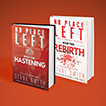
Used by permission of 2414 Ventures.
A few years ago Mission Frontiers featured David Platt’s Radical, a strategic book for mobilizing the church. We are delighted now to feature Steve Smith’s thriller “No Place Left” saga, designed to carry the Church further in the same direction. This excerpt is from Hastening (Book One).

“Congratulations, my imperturbable accomplice,” John said. “We made the Washington Post.”
Christopher sighed as he scanned the headline: L.A. Pastor Speeds Up the Return of Jesus. “Really, bro, you shouldn’t pay attention to these things.”
“They’re saying we think we can dictate when Jesus returns. They’re saying we’re taking Matthew 24:14 and 2 Peter 3:12 too far, as if the moment the last unreached people group is reached, Jesus has to return,” John said.
Christopher studied his longtime friend. “There’s more to it, though, isn’t there, bro?”
“Well,” John admitted, “I’ve had similar questions, lingering questions. We’re gaining a lot of momentum, so I haven’t wanted to rock the boat—especially since I often appear critical.”
“I’m not! I support you and this mission unreservedly! But, Christopher, what if they’re right? Are we trying to dictate when Jesus will return? How can we actually hasten Jesus’ return? This is the question that plagues me. Isn’t God sovereign? Hasn’t He set the date for Jesus’ return? How can we speed up the coming of that day?”
“Bro, I wish you had said something sooner,” Christopher commented. “Actually, I wish that I had said something. We’re getting a lot of kickback on this, so I’ve been studying it more deeply—making sure we’re not off base. And here’s the thing. Of course God is sovereign. And at the same time, we play a role in bringing about His sovereign plans. Think about it this way. Remember when you came to faith?”
“I was quite the rabid dog, wasn’t I?” John said, smiling. “Couldn’t shut up about my new life.”
“Well, not exactly. You were also really, really nervous about talking to your dad about it, remember?”
“Well, who wouldn’t be?” John said. “He was a Rhodes scholar. Tenured faculty. Twice the intellectual—and cynic—I am. And always finding fault with born-again Christians.”
Christopher nodded. “You kept praying, ‘Lord, send someone to witness to my dad, someone with the intellectual faculties to back him into a corner.’ Remember?”
John winced. “Yes, until that fateful day when I realized my dad was my responsibility. It was up to me to share the gospel with him.”
Christopher leaned back in his chair. “Now, think about it, bro. How long did you wait to open your mouth? Six months?”
“Yeah, but I finally got convicted to do something about it. Otherwise I probably would have waited six years, or perhaps even sixteen.”
John paused. “One of the hardest things I’ve ever done was buying that plane ticket to Boston. But you know, after we had spent a little time together and I shared my story, he just melted. I was speechless.”
“Bro, the testimony of your changed life and your love for him was more powerful than any apologetics someone else might have debated with him,” Christopher said, smiling.
“I—I guess so. I’m still amazed my dad’s a Jesus-follower. The cynic now an evangelist!”
Christopher leaned forward. “Now think about this, bro. You were the instrument God used to lead your dad to faith. You wanted to wait years and very well might have if God hadn’t convicted you to speed up the process.
“You and I know the date of your dad’s salvation was set in heaven before the earth was formed. But, in a way, you hastened that day by buying that plane ticket and witnessing to your dad. Perhaps if you had waited six years, he would have believed later, but you didn’t wait. You hastened the day, though from heaven’s viewpoint that had been God’s plan all along. Your motivation fit within God’s plans.”
“God destined my father’s day of salvation, but I became His instrument,” John repeated to himself. “From my vantage point, I speeded up that day by acting in faith sooner rather than later. Someone was going to win him. Why not me, and why not then? How was I to know it wasn’t to be his day of salvation?”
“It was the same when Church in the City sent our first short-term team to China,” Christopher said. “Remember the medical clinics we did in the villages? There were people there who might not have heard the gospel for many more years if we had not come. God knew when He created them when they would believe, but from our perspective, we hastened the day of their salvation.
“Look, bro. Fatalism drove those who opposed William Carey. They told him, ‘Sit down, young man. … When God pleases to convert the heathen, He’ll do it without your help or ours.’”
John chuckled. “Uh, yeah, I could have been one of them.”
Christopher continued, “All I know is that someday God will raise up a generation with the motivation, the wherewithal, and the perseverance to finish the task—the last generation. From earth’s vantage point—whether or not we become that generation—we are hastening that day by focusing on finishing the task. From God’s vantage point, He has chosen someone to finish the task and appointed the times and seasons of their final work. If we are the ones He has chosen, we’re not speeding God up; God is speeding us up to usher in the day He prepared long ago.
“Bro, we’re on solid biblical ground. Solid not just according to me but also respected theologians. Listen to Marvin Vincent’s hundred-year-old comments on 2 Peter 3:12.”
Christopher picked up an ancient tome, gently leafed to the appropriate page, and read:
I am inclined to adopt, with Alford, Huther, Salmond, and Trench, the transitive meaning, hastening on; i.e., “causing the day of the Lord to come more quickly by helping to fulfil those conditions without which it cannot come; that day being no day inexorably fixed, but one the arrival of which it is free to the church to hasten on by faith and by prayer.”
John contemplated these words.
“Will Jesus come back the moment the last UPG is reached?” Christopher asked. He glanced once more at the headline as he grabbed the paper again. “I don’t know. I just know that this is the mission He left us with, and that He said we would finish before His return. I want to finish the task He has given us.
He tossed it back down again and said, “He’s not waiting for permission from us to come back. Rather He is patiently waiting for us to do what He commanded, and He’ll come back when the time is right. …
“There will be a last generation. Why not us? Carey suggested his generation speed up the Great Commission by going. I ask why we can’t hasten finishing this task. By God’s grace I will lay down my life to see it completed. Perhaps God’s plan all along has been to raise up this generation as His vehicle for finishing the task before He sends Jesus on the day appointed from the foundation of this world.”
This is an article from the September-October 2024 issue: People Group Theory
September 01, 2024 by ELLIOT CLARK
Should We Prioritize Work among UPGs?

For multiple decades, evangelical missiologists have emphasized the need to focus the church’s missionary efforts on unreached people groups (UPGs). Ever since Lausanne ’74 when Ralph Winter exposed the “hidden peoples” of the world and redefined the nations (panta ta ethne) along ethnolinguistic lines, missionaries and mission agencies have increasingly prioritized work among UPGs. This tectonic shift in global missiology, now 50 years on, has subsequently reshaped the landscape of evangelical missions.
For many, defining panta ta ethne as discrete people groups and designing strategies to reach them is simply presumed. However, in recent years, some have begun to question this approach. Alongside those offering a minority report, this article will argue the prevailing definition of panta ta ethne is exegetically and sociologically untenable, and thus missiological strategies based on that definition are inherently prone to error.
In what follows, I will begin by making some exegetical observations that call into question the practice of defining panta ta ethne along sociocultural lines. This groundwork is crucial, not least because all methodology is built on theology. I will then transition to mention some historical and sociological realities that further undermine the prevailing definition of UPGs. After those considerations, I’ll conclude with some practical suggestions for contemporary missions. My aim is not merely to critique but to offer constructive proposals for a faithful way forward.
Exegetical Observations
I believe that understanding the ethne as ethnolinguistic or sociocultural groups is biblically unsustainable. Furthermore, recent calls to “finish the task” by identifying and prioritizing work among each and every one of those discreet groups misread Jesus’ promise (Matt 24:14) and commission (Matt 28:18–20) to his first followers. Here are five reasons we should reconsider the prevailing sociocultural definition of panta ta ethne.
1. Throughout the Bible, the term ethne (nations) typically refers to gentiles or non-Jews. This is true in both the Greek translation of the Old Testament (Exod 15:14; Num 14:14–16) as well as in the New Testament. In Matthew’s Gospel specifically, the ethne are consistently gentiles, those outside the covenant people of Israel. Williams and Moss make this point and then suggest panta ta ethne in Matthew 28:19 is likely meant to include both Jews and gentiles, thus referring to “all of humanity.”1
2. Defining the ethne as sociocultural people groups prefers a modern anthropological definition over a biblical-theological one. When Jesus and the apostles spoke of the ethne, their primary reference point would have been the Old Testament, specifically the table of nations in Genesis 10 and the promise to Abraham in Genesis 12 (see Gal 3:8, 14), as well as Isaiah’s prophecies about the servant of the Lord.2 They weren’t operating within the sociological categories of today when using the term. Thus, the prevailing definition of ethne is anachronistic.
3. The term pas/panta (all) does not always mean “each and every” in the New Testament. Even if we grant that ethne implies people groups, it doesn’t follow that we should understand Jesus’ promise in Matthew 24:14 to mean the gospel will be preached to each and every UPG. As Schreiner explains, “the word ‘all’ is not invariably used in a comprehensive sense.” For example, Matthew says that “Jerusalem and all Judea and all the region about the Jordan” were going out to John (Matt 3:5, ESV). Thus, he cautions against reading panta ta ethne in a literalistic way or as a kind of “mathematical formula.”3
4. Jesus and the apostles, though speaking truthfully, weren’t necessarily speaking with modern, scientific precision. When we come to the account of Pentecost, Luke says that panta ta ethne were present to hear the gospel (Acts 2:5). This leaves us with a couple of interpretive options. Luke could have been speaking hyperbolically or colloquially. Or he could have been stating that all nations (perhaps according to a common Jewish understanding) were in fact represented in Jerusalem that day. But he certainly wasn’t writing with the same scientific precision presumed by a UPG definition.
5. The apostles’ statements about the gospel’s advance suggest they believed “all nations” heard the gospel in their lifetimes. In addition to Luke’s record of all the nations present at Pentecost, Paul says the gospel was bearing fruit “in the whole world” (Col 1:5); it had been preached “in all creation” (Col 1:23). God enabled him to proclaim the gospel so “all the gentiles” (panta ta ethne) might hear it (2 Tim 4:17). These and similarly expansive statements from Paul (Rom 1:8; 10:18) suggest he understood the promise of Matthew 24:14 had been fulfilled, at least in some way, in his lifetime.
If these observations are correct—in fact, if any one of them is correct—then it calls into question the definition of UPGs that drives much of missions strategy today. But it’s not just that the accepted understanding of UPGs is biblically questionable; it’s also historically and sociologically problematic.
Sociological Considerations
Prioritizing work among UPGs has some basic real-world problems. As Darren Carlson and I have suggested elsewhere (scan the QR code), even if we tried to preach the gospel to each and every ethnolinguistic group, it would be practically impossible. Some groups, as defined by UPG proponents, have gone extinct, many before the gospel reached them. The same could be said for various languages.
Furthermore, defining UPGs as discreet entities employs an outdated anthropological model. Instead of an essentialist understanding of culture, we should recognize that so-called “people groups” are rarely fixed, clear, and distinct from one another due to a variety of historical and cultural factors.
Lee and Park argue that the common understanding of UPGs is at odds with contemporary sociology. More specifically, they criticize “essentialized conceptualizations” that don’t account for the “fluid and porous nature of social boundaries as well as the reality of globalization and hybridization of contexts.”4 In short, defining UPGs as discrete and self-contained entities is based on obsolete, simplistic, and often errant understandings of societies and cultures.
Practical Suggestions
What does this mean for our missiology? If identifying, isolating, and prioritizing work among UPGs according to the dominant missiological definition is both biblically untenable and sociologically unworkable, what should we do? My simple proposal is to emulate Paul’s example. What follows are four basic principles from his ministry that are pertinent to this discussion.
1. Aim for widespread and indiscriminate evangelism. As many have noted, Paul was motivated by his ambition to “preach the gospel where Christ was not known” (Rom 15:20). In line with that Pauline aim, I would say Ralph Winter was basically right to expose the problem of hidden peoples and forgotten places largely untouched by the gospel. I wholeheartedly affirm the value of strategically directing missions efforts to such areas of recognized need. However, in my experience, when missionaries prioritize narrow UPG strategies, that can sometimes constrain the broader Pauline goal of widespread evangelism and winning “as many as possible” (1 Cor 9:19).
Let me give an example. Years ago, our family served with a team focused on reaching a specific UPG. Initially, however, we saw the most fruit from those within the majority language. In response, our leadership instructed us to avoid those new believers and seekers. In effect, they wanted us to prefer one group over another. More than just strategically imprudent, I found it biblically indefensible. And as an expression of partiality, I believe it was potentially sinful. Contrary to such a practice, I would encourage missionaries to spread the gospel indiscriminately among all groups.
2. Strive for maturity and faithfulness. Paul the missionary was concerned about far more than just the pioneer advance of the gospel.5 He discipled believers to maturity (Col 1:28). He taught the whole counsel of God (Acts 20:27). He was constantly anxious for the churches in his care (2 Cor 11:28), and he vigorously defended them from false teachers. Paul then entrusted his gospel, and that same pattern of ministry, to faithful local leaders (2 Tim 2:2).
When such maturity and faithfulness are the goal, it challenges the metrics behind UPGs, including the arbitrary 2% threshold. Perhaps that number could indicate a movement’s viability and reproducibility, but it says nothing of its biblical acuity and gospel fidelity. In other words, it tells us little about the quality of our work. Over the past few decades, an emphasis on UPGs has led missionaries and mission agencies to abandon “reached” fields prematurely, with devastating results. However, if we measure success by the holiness of our disciples and the health of our churches—and ultimately by our faithful stewardship of the gospel—we may avoid such errors.
3. Promote unity in Christ’s body. Among the most striking missiological approaches of Paul was his dogged commitment to unity in the church among those from different social classes and various ethnic backgrounds. Sadly, focusing on UPGs can sometimes engender the exact opposite. Missionaries, following the Homogeneous Unit Principle, will often seek to stimulate the gospel’s spread through existing cultural groups. Such a practice promotes uniformity more than unity and can unintentionally accommodate sinful tendencies toward exclusion and discrimination.
Of course, there are peoples and places where linguistic or geographic barriers will require distinct congregations. But many times, missionaries foster divisions in the church where they don’t exist in society. Functionally, there’s no reason why groups that live together, school together, and work together cannot also worship together. Theologically, they must! Granted, building unity among diverse and even hostile groups can be extremely difficult. But this is worthy gospel work. Rather than advocating for segregation, missionaries should promote counter-cultural unity in the body.
4. Value shared-language ministry. When we look at Paul—and the rest of the New Testament—we find a surprising willingness to operate in the shared language of Greek throughout the Roman Empire. Today, we have similar opportunities around the world. That’s not to minimize the necessity for many missionaries to engage in rigorous language study, nor is it meant to diminish “heart language” ministry. We need workers focused on reaching language groups that won’t be reached through shared majority languages. However, as we engage in those essential efforts, we shouldn’t overlook the amazing value of trade languages, including the ascendancy of English globally.
Shared languages can, in some contexts, foster unity and provide opportunities for gospel partnership. Where present, they can also give more immediate opportunities for evangelism and discipleship. Also, many trade languages, such as Russian or French, already have established theological vocabulary and published Christian resources. For these reasons and more, missionaries should consider the value of gospel ministry in the lingua franca.
Clearly, this is just a simple sketch of possible priorities for our gospel work as we seek to obey our Lord’s commission. Yet, that simplicity is part of my point. At the end of the day, I’m not convinced we need to spend more of our limited time, energy, and resources for a vision of people group ministry that the Bible never envisioned nor prescribed.
Does that mean we no longer conduct ethnographic studies, evaluate minority languages, record religious percentages, or adopt people groups? Not necessarily. But we should be careful when emphasizing UPGs that we don’t neglect the “weightier matters” of missions. Wherever we go, we should prioritize broad evangelism and deep discipleship, gospel unity and ministry partnerships, healthy churches and qualified leaders. Without these, our task remains unfinished.
Endnotes
Jarvis J. Williams and Trey Moss, “Focus on ‘All Nations’ as Integral Component of World Mission Strategy,” in World Mission: Theology, Strategy, & Current Issues, ed. Scott N. Callaham and Will Brooks (Bellingham, WA: Lexham, 2019), 132.
T. Desmond Alexander and Brian S. Rosner, eds., New Dictionary of Biblical Theology (Downers Grove: InterVarsity Press, 2000), 677.
Thomas R. Schreiner, New Testament Theology: Magnifying God in Christ (Grand Rapids: Baker Academic, 2008), 811.
Peter T. Lee and James Sung-Hwan Park, “Beyond People Group Thinking: A Critical Reevaluation of Unreached People Groups,”
Missiology 46, no. 3 (2018): 214.
See Elliot Clark, Mission Affirmed: Recovering the Missionary Motivation of Paul (Wheaton: Crossway, 2022).
This is an article from the September-October 2024 issue: People Group Theory
September 01, 2024 by PETER T. LEE
Crossing New Boundaries: Questions for Unreached People Groups Strategy
All Scripture references are from the NIV.

When I first heard someone explain UPG, I was awakened to the reality that billions of people for many generations had not only been excluded from gospel witness but billions more could continue to be excluded if no one went across the cultural boundaries to enter their communities and share the gospel with them. The incredible need for cross-cultural evangelism globally was shocking but also inspiring to me. I quickly signed up for this training.
The training was long, intense, and intriguing. I learned the basic concept of cross-cultural evangelism and the reason it should be our highest priority, which Ralph Winter famously explained at the first Lausanne Congress in 1974.1 At that time, I was a 20-something engineer who sensed a calling to serve as a cross-cultural missionary in the Middle East or North Africa but had no prior training in theology or missiology. As I went through this UPG training program, I learned about a Berber group in North Africa and began to put my focus on it. I was convinced that reaching unreached people groups was crucial in global mission. In the decades that followed, I served in North Africa and engaged in missiological research. As I learned more about realities of the mission fields, I began to have some questions about the entire UPG strategy and some of the ways it was practiced.
A glimpse of recent discussions on UPGs shows that most supporters of UPG thinking would see a static view of socioculturally defined people groups as problematic. Many seem to agree that the socio-cultural understanding of UPG needs to be updated in light of changing cultures and group boundaries under globalization, urbanization, and migration.2 It is suggested that People Group Theory is an imperfect but effective tool to help mobilize the church in the way a map would help people get to a certain place without depicting the real streets and buildings accurately.3 The UPG concept was founded upon the Homogeneous Unit Principle (HUP).4 While UPG missiology may not entirely align with the HUP concept, the link between them is undeniable and questions remain with parts of UPG missiology based on HUP.
In an article James Park and I co-authored, we raised some questions about the UPG paradigm, particularly three related issues—biblical interpretation of panta ta ethne in Matthew 28, sociocultural analysis of people groups, and the theological issue of planting homogeneous unit churches among the unreached.5 Among these three, I want to focus on a biblical theological issue with the UPG paradigm here.
What Did the Great Commission Mean to Jesus’ Disciples?
Many who support UPG missiology take for granted that in Matthew 28:19–20 Jesus commands us to go and make disciples of all nations, (including all unreached peoples.) We should remember that the Great Commission in Matthew 28 is given to a group of Jewish disciples gathered on a mountain in the region of Galilee. It is notable that Jesus does not tell them to go and make disciples of all Galileans or Jews, but panta ta ethne or all the nations, all people including Jews and gentiles. How preposterous this command must have felt to a group of Jews gathered in Galilee!
It is an outrageous idea—not just because of its huge scope but the difficult social boundaries that Jesus was calling them to cross—that Jews needed to go across the boundary line to make disciples not only of fellow Jews but also the gentiles. For Jews to make disciples of gentiles would entail meeting, eating, and associating with gentiles. It would mean entering the homes of gentiles and having gentiles enter their homes. It would have been unsettling for them to think about becoming sisters and brothers, even a family in Christ with gentiles. And yet, throughout the history of Christianity, members of the Body of Christ went across various social boundaries and made disciples of all the people that they encountered, even traditional enemies.
Missional Reading of the Great Commission
Although it is not entirely conclusive, most New Testament scholars suggest that the first audience of Matthew’s Gospel might have been a Jewish-majority Christian community in a cosmopolitan city in the Roman Empire, perhaps in the region of Palestine, Syria, or Antioch. The message of the Great Commission and the Gospel of Matthew would not have been lost on these disciples who lived in proximity to the Greeks and the gentiles.
The Great Commission is comprehensive. It shows no human boundaries should keep anyone out from the kingdom of God; all are welcome. Now, Jesus’ disciples are to make this invitation to the kingdom to all people, even those with whom they did not want to associate. This is a core message of the Great Commission in Matthew we may have overlooked in our zeal for global missions. This command would certainly include our missionary practice of going to faraway places to reach “least reached” people who make up certain ethno-linguistic or social groups, but it does not mean that our churches could omit or neglect those nearby or even those in more reached groups. The primary focus of the Great Commission should be understood as the comprehensive inclusion of all kinds of people in God’s kingdom, especially the ones we do not want to include. After all, we don’t baptize people groups but individuals who make up panta ta ethne. This is not an individualistic reading of the passage that UPG thinkers have tried to counter; it is a holistic, missional reading in light of the reality of the local church in which not only those from my own people group but also those outside my group must be welcomed.
It is true that language and culture, not the desire to exclude people, are often the primary reason for local churches not embracing those from other cultural backgrounds. Korean immigrant churches in the Chicago area are good examples. It is interesting, however, that Jesus’ disciples were commanded to make disciples of panta ta ethne even though they were Jews gathered up in Galilee. Was it just overseas, another country, or another ethnolinguistic group that they needed to evangelize and disciple? Or were they to incorporate panta ta ethne in everything they did locally, globally, and everywhere in between?
This understanding of the Great Commission brings new implications for us today. The gospel proclamation as outlined in the Great Commission starts “here,” not just “over there.” Certainly, as we go and make disciples, some of us will go to Samaria (Acts 8) and Antioch (Acts 11) and cross those traditional cultural and social boundaries. New communities of faith in varying shapes will form. As we obey Jesus’ command, the Spirit may set apart certain persons for a specific mission, like Barnabas and Saul of Tarsus (Acts 13). This is the organic way the Holy Spirit has led the Church in mission for 2,000 years. For some reason, we seem to have lost much of this organic, communal focus in our global missionary practice in favor of a greater emphasis on efficiency, results, and achievements, the kind of values worshiped by the modern world. Of course, these are not necessarily evil; biblical stewardship requires us to manage God-given resources well. However, we need to be careful that the motives behind our missionary strategies remain faithful to biblical principles and not swayed by worldly values.
Will Frontier Missions Identify and Cross New Boundaries?
The late Latin American evangelical scholar and leader, C. René Padilla, wrote the following words in 1982:
The missiology that the church needs today is not one that conceives the People of God as a quotation taken from the surrounding society, but one that conceives it as ‘an embodied question-mark’ that challenges the values of the world.6
He calls out the proponents of the Homogeneous Unit Principle (HUP) for not challenging people’s mono- cultural comfort in order to grow churches. To him, this type of church planting strategy was not in line with biblical teaching. He argues that our New Testament vision for the Church should be in line with the gospel that challenges, not just employs, social and cultural tendencies. His warning is still relevant today. We need more churches that are “embodied question marks,” not simply “quotation marks” of the worldly values we must counter. Those of us who are involved in frontier missions need to continue to reflect biblically and discern if our mission strategy might have unintended consequences on Christian mission and the Church.
It is true that the UPG paradigm has motivated and encouraged the global Church to send numerous workers to serve among many millions of people who have not had an opportunity to hear the gospel. It awakened generations of Christians, including me, to the reality of those without access to the gospel witness, and inspired many to dedicate their lives to reaching them. However, it has also provided a somewhat narrow and limited interpretation of the biblical view of panta ta ethnē and Matthew 28. It could inadvertently create and perpetuate ethno-cultural stereotypes. Rather than challenging the prejudice of group boundaries, some might utilize them, thereby potentially leading to disciples who are blind to those human boundaries that Scripture challenges.
A remaining question for those of us involved in frontier missions is whether we will continue to identify those human boundaries in the world that we did not see before. Will we continue to recognize and go across new cultural and social boundaries that prevent people from hearing the gospel in a culturally sensitive way? In some situations, we may be faced with questions of whether only to cross the boundary with the gospel or actually to challenge the boundary itself with the gospel. Things will not look so black–and–white in a complex world; we often need to discern shades of grey when it comes to working with these boundaries, whether ethnic, cultural, social, class, language, gender, etc. What gives me hope is that there is subversive power in the gospel that not only propels us to go across boundaries; it often challenges these very boundaries, especially in situations of conflict and tension. In some contexts, especially increasingly urbanizing societies, if we do not challenge the human boundaries that separate certain people from a new group of disciples, we might not get a second chance to challenge them later. Even if a frontier missions strategy helps get churches started and growing more rapidly within a certain social group, what kind of churches will they become if they do not question the values of the world that could corrupt their biblical vision for the church? This may be an important question that we need to consider in the years to come.
Endnotes
Ralph D. Winter, “The Highest Priority: Cross-Cultural Evangelism,” in Let the Earth Hear His Voice: Official Reference Volume, Papers and Responses (Minneapolis, MN: World Wide Publications, 1975), 213–41.
The October-December 2020 issue of EMQ (Vol. 56, Issue 4) provides recent discussions on UPG. This EMQ issue has very helpful and well written featured articles on the people group missiology.
Brad Gill, “A Church for Every People: A Retrospect on Mapping People,” Evangelical Missions Quarterly 56, no. 4 (December 2020): 43–45.
For discussions on the link between HUP and UPG, see David E. Datema and Leonard N. Bartlotti, “The People Group Approach: A Historical Perspective,” Evangelical Missions Quarterly 56, no. 4 (December 2020): 8–11.
Peter T. Lee and James Sung-Hwan Park, “Beyond People Group Thinking: A Critical Reevaluation of Unreached People Groups,”
Missiology 46, no. 3 (July 2018): 212–25, doi.org/10.1177/0091829618774332.
C. René Padilla, “The Unity of the Church and the Homogeneous Unit Principle,” International Bulletin of Missionary Research 6, no. 1 (January 1982): 30.
This is an article from the September-October 2024 issue: People Group Theory
September 01, 2024 by TED ESLER, PhD
The Center of Global Missions Need

The Shifting Center of Global Christianity
A 2004 paper by Todd Johnson and Sun Young Chung details an approach to understanding the changing nature of the global church. They write,
Christians, at any given time in history, have definable geographic locations and a demographic or statistical centre. A single geographic point is here identified as the statistical “centre of gravity” of Christianity.1
They plotted the growth of Christianity starting in AD 33 and projected where it is heading out to 2100.2

This map has had a profound and helpful impact on how we understand the growth of Christianity in what is called “the Global South” and a concurrent decline in “the Global North.” First reported by David Barrett in 1970, this shift is expected to continue for the foreseeable future.3 Popularized by Philip Jenkins in The Next Christendom, it has helped many people understand this important religious trend that is ongoing. 4
The phrase “The Center of Gravity for Global Christianity” has also had a profound impact on missiology. It highlights the need for the increased sending of missionaries from the Global South. It forces us to consider the ramifications of a diminishing missionary force from the Global North. It influences our foundational understanding of missions, developed mostly from Western Christianity. It has informed our understanding of Jesus’ command to take the gospel to the nations.
Where the Church Is Not Is the Primary Concern for Missionaries
The shifting center of global Christianity focuses our attention on where the church is. It tells us where Christians currently live. It highlights the “supply side” of missionary work (i.e., the sources of people, money, prayer, and other resources to carry out the missionary task). Missionaries ask the opposite question. They ask, “Where are there no Christians?” They are more concerned about the “demand side” of the Great Commission task. These are the cultures in the world with the fewest Christians and the least access to the gospel.
 The Geographic Center of Unreached People Groups Weighted by Population
The Geographic Center of Unreached People Groups Weighted by Population
A more significant question for missionaries to consider (and, in fact, all Christians, since all are charged with the task of taking the gospel to the nations) is: “Where is the center of global missions need?”
The Center of Global Missions Need
By mapping the point on the earth where the most people live in unreached people groups (UPGs),5 we get a much better understanding of the remaining missionary task. Using a similar approach that Barrett employed, it is possible to create a “centroid map,” which highlights that point on the earth that represents the greatest number of UPGs, weighted by population.
The map above, from Joshua Project, highlights the status of all UPGs at present.6 Each dot represents the approximate location of a UPG.7
Using this same data, the following centroid map reveals the geographic location of global missions need.
The spot on the earth with the greatest missionary need is located in Gujarat Province, India, in the city of Kharaghoda.8

Winter Coordinates
The data used for this map is readily available on the Joshua Project website. The downloadable database includes additional information, such as the status of Bible translation, primary religion, and many other attributes. Because there is more than just unreached people group data, this same concept can be applied to other attributes as well. For example, one might be interested in a centroid map that shows the coordinates of unreached people groups weighted by population filtered to show only Islamic cultures. We will call this set of geographic coordinates the “Winter Coordinates.” This recognizes Ralph Winter’s emphasis on UPGs and the need to highlight them to the global church. The following, for example, is a map showing the Winter Coordinates for all unreached Muslim people groups:
Here we find the centroid on the edges of Muksat, Oman.

This same concept of a weighted centroid map works for all religious blocs, as noted in the map below.
Summary
The center of global missions need highlights for the global Church where we must spend our efforts in reaching the nations for Christ. There are limitations in this representation. Unlike Barrett’s original map, a lack of historical data does not allow us to map the Winter Coordinates over time. The data set used here is among the best available, taken from the Joshua Project. The map will only be as accurate as this data allows. The map does not show the nuances of progress that might be happening among these groups (e.g., it does not differentiate between engaged and unengaged people groups).9

Winter Coordinates of Various Religious Blocs
(Source Data: Joshua Project, 2023)
Despite these limitations, the center of global missions need gives us a fairly accurate picture of where missionaries should focus a significant part of their efforts. It provides an alternative paradigm to the center of the global Church concept which has been influential for decades. Winter Coordinates might be applied to a host of missiological challenges, including mapping by religious bloc, types of ministries (e.g., Bible translation or training on church planting), frontiers peoples, and similar missiological concepts.
I suggest that whenever missiologists discuss the shifting center of the global church, they also highlight the center of global missions need. It puts the focus on the command of Christ to take the gospel to the nations. While the former concept is about us, the Church, the latter is about others and the need for the gospel to enter these cultures. 
Endnotes
Todd M. Johnson and Sun Young Chung, “Tracking Global Christianity’s Statistical Centre of Gravity, AD 33-AD 2100,” International Review of Mission 93, no. 369 (2004): 166–81.
Johnson and Chung, “Tracking Global Christianity’s Statistical Centre of Gravity.”
David B. Barrett, “AD 2000: 350 Million Christians in Africa,” International Review of Mission 59, no. 233 (1970): 39–54.
Philip Jenkins, The Next Christendom: The Coming of Global Christianity (New York: Oxford University Press, 2011).
Ralph Winter, “The Highest Priority: Cross-Cultural Evangelism,” lausanne.org/wp-content/uploads/2007/06/0213.pdf; lausanne.org/ content/the-highest-priority-cross-cultural-evangelism.
Joshua Project, Datasets found under Resources, accessed 12/11/2023, joshuaproject.net/resources/datasets.
Joshua Project, accessed 2/1/2024, joshuaproject.net/assets/media/maps/progress-scale-map-plain.pdf.
The mapping services were provided by Joshua Project.
Unengaged UPGs have no indigenous or foreign Christians among them proclaiming Christ with intent to birth and nurture multiple communities of Jesus-followers.
This is an article from the September-October 2024 issue: People Group Theory
September 01, 2024 by Sue Patt
Clarity

Clarity is a beautiful thing. Humans love order, some more than others. We like to identify one thing as something specific and another thing as something else. Black and white is simple, clean, and easy to read. I notice my appreciation for sight when looking at the footage on my outdoor trail camera. At night I can’t see colors, but in the absence of light, it’s remarkable just how much activity I am able to see. Shades of grey are enough at night to see an amazing array of animals in my suburban yard, even though I can’t see very far.
Contrast seeing at night with seeing in the daytime. Colors explode all around us. There is seemingly infinite gradation of green right outside my window contrasted against blue sky and puffy white clouds. Even with the familiarity of this expansive vista, I am awestruck.
I think People Group Theory is like this. There is beauty and grace in the simplicity of description of humans arranged by language, culture, and affinity. It’s like seeing at night. This clarity allows us to observe how one people group is similar or different from another. In its simplicity, it gives us keen exposure to realities of strategic thinking about global evangelization, but seeing at night only goes so far.
Look at People Group Theory in real life and vibrant colors emerge, shaping and contrasting conversations in new and exciting directions. Can we live with polarities of night and day? Can a theory be useful and not enough? Might we in the Western expression of Christianity be unknowingly offensive in how we talk about “the task” or “the unreached,” as if people are a problem to be managed? It’s time for respectful dialogue.
How do we talk about the beauty of people arranged in groups who either have access to the good news of Jesus or don’t, when the very landscape of migration, internet access, globalization, and urbanization are changing the fabric of how people relate to each other? The sand is shifting underneath our feet. God does not change, but the way good news travels or might travel is changing very quickly. We don’t need to be threatened by change. Change is the constant, even as God never changes.
Polarity is like that. Things that seem like black and white opposites are more like shades of vibrant colors when observed through different light. Both are true at the same time, almost as an extension of thought.
So, continue the dialogue with brothers and sisters in your context through the thoughts collected in this issue of Mission Frontiers. What are the voices not represented in this issue? Surely, they are even more than the voices represented. Let’s listen with curiosity instead of demanding to be heard.
This is an article from the September-October 2024 issue: People Group Theory
September 01, 2024 by DAVE EARL DATEMA
Response to Urbanization and Measuring the Remaining Task
Last published in Mission Frontiers, Sept/Oct 2021

Justin Long, in his article, “Urbanization and Measuring the Remaining Task” (Mission Frontiers, Sept/Oct 2021) has put his finger on what I believe is the number one problem related to current people group thinking. For decades, numerous voices have cast doubt on whether the people group paradigm can adequately describe human grouping in urban contexts. As centers of amalgamation, assimilation, and integration of ethnicities, languages, and cultures, cities create hybrid or hyphenated identities over time.
“Fusion cuisine” is one product of such blending, yet such fusion goes far beyond food. It takes place within people as distinct communities living side-by-side in densely populated areas interact with others daily. The traditional framework of people groups, in which peoples are seen as clearly distinct groups with clear lines of demarcation, does not work in cities in a similar way. So does urban reality doom the people group paradigm to irrelevance?
It depends on how you define people groups. Historically, there have been two primary ways of defining them, one narrow and simple, the other broad and complex. The simple definition is best known as the ethnolinguistic definition, meaning that the peoples of the world are categorized according to shared ethnicity and language. The advantage of the ethnolinguistic definition is that it is quantifiable. This is the standard way peoples have been categorized, not only by missionaries, but also by the United Nations, national governments, etc.1
By contrast, the “official” definitions for people groups, hammered out by American evangelical mission leaders, have been much more complex. These definitions of people groups did not neglect ethnolinguistic realities but also recognized other factors. As early as 1978, Ralph Winter was defining “hidden peoples” more broadly: “Any linguistic, cultural, or sociological group defined in terms of its primary affinity (not secondary or trivial affinities), which cannot be won by E-1 methods and drawn into an existing fellowship.”2 Here the word “sociological” broadens the types of grouping possible far beyond ethnicity and language. The emphasis is on “primary affinity” and is not necessarily ethnolinguistic.
Then, in 1982, leaders gathered to agree on a standard definition of a people group:
A people group is a significantly large grouping of individuals who perceive themselves to have a common affinity for one another because of their shared language, religion, ethnicity, residence, occupation, class or caste, situation, etc. or combinations of these. For evangelistic purposes, it is the largest group within which the gospel can spread as a Church Planting Movement without encountering barriers of understanding or acceptance.3
Notice that the first sentence includes much more than ethnicity and language as acceptable affinities. The second sentence, added at Winter’s impetus, puts the emphasis simply on “group” and emphasizes “barriers of understanding or acceptance.” In other words, a group is identified not only because it represents a new language (barrier of understanding) but also because it may represent other barriers created due to religion, class, caste, etc. (barrier of acceptance), perhaps even within one ethnolinguistic group. By this definition, people groups cannot be reduced to ethnicity and language.
Even after the establishment of the 1982 definition as an industry standard (which saw the demise of the phrase “hidden peoples”), and even though Winter helped create that newer definition, he felt that people groups were still being interpreted ethnolinguistically. So once again he attempted to change the focus with his description of “unimax peoples.” “A unimax people is the maximum sized group sufficiently unified to be the target of a single people movement to Christ, where ‘unified’ refers to the fact that there are no significant barriers of either understanding or acceptance to stop the spread of the gospel.”4 Again, there is no reference to the type of affinity. Winter was less concerned about how groups held together and more concerned with why the gospel wasn’t getting to them, less concerned about affinity and more concerned about access, less concerned about bonding and more concerned about barriers.
The differences in these views of what constitutes a people group are important. Winter and Koch rightly asked, “What if an ethnolinguistic people is actually a cluster of unimax peoples, and while one of them is experiencing a church-planting explosion, other groups in the cluster have little or nothing happening within them?”5 Not satisfied with identification of ethnolinguistic affinity, they have pushed us to discover where and why the spread of the gospel may be hindered within a given ethnolinguistic group.
With that history in view, let’s return to the question: Does urban reality doom the people group paradigm to irrelevance?
If people groups are seen exclusively as ethnolinguistic groupings, then I believe they have indeed become somewhat irrelevant for urban contexts. I say “somewhat” because we need to remember that even with all the realities mentioned above, people in urban contexts can also remain very devoted to their home cultures. Not all people in urban environments mix in equal measure. Traditional norms often remain very strong, as illustrated by mother- tongue transfer to younger generations and marriage within existing groups. It is not accurate to portray cities as bastions of indiscriminate and wholesale mixture.
However, given that caveat, it remains obvious that if we equate people groups with ethnolinguistic peoples, cities create problems too difficult to overcome. Rather than defending ethnolinguistic people groups in this way, I think we need to remind ourselves that the actual definitions hammered out decades ago allow for a more elastic, non- ethnolinguistic definition.
I believe that these classic people group definitions remain valid in urban settings. Under this paradigm, we are looking for groups (whatever their affinity) that appear to exist outside gospel witness. In most cases, this will be due to barriers of acceptance. Regardless of the fusion of peoples in urban settings, they are still forming into groups. That is what matters, not the particular and varied affinities they are grouped around. We don’t have to abandon people group thinking to understand urban life. But we do have to return to the earlier definitions to be reminded of the breadth of possibility human grouping takes.
Finally, this line of thinking can be taken too far. One of the weaknesses of the 1982 definition is that it allows for literally millions of human groupings encapsulated in “a common affinity for one another because of their shared language, religion, ethnicity, residence, occupation, class or caste, situation, etc. or combinations of these.” While a purely ethnolinguistic focus is too limiting, a focus on every conceivable human grouping in the world is far too broad. I believe the ethnolinguistic focus has served us well, but when an issue like urban contexts limits its effect, we need to delve deeper, but not too deep.
Our goal is not to describe every human grouping on this planet. It is to notice when the gospel is not getting somewhere, and then to prayerfully and humbly seek God for the wisdom needed to discern the barriers as well as the bridges to that group. The complex realities of human grouping will always frustrate simple definition and people group databases. They can be discerned only by workers embedded in urban centers over many years. Today’s urban missionary needs to become expert in new forms of research, like social network analysis and become reacquainted with old forms of research, like prayer. It is hard to imagine a more exciting vocation!
Endnotes
http://www.cia.gov/the-world-factbook/countries/
2 Ralph D. Winter, Penetrating the Last Frontiers (Pasadena, CA: William Carey Library, 1978) 42.
Ralph D. Winter and Bruce Koch, "Finishing the Task: The Unreached Peoples Challenge," in Perspectives on the World Christian Movement, ed. Ralph D. Winter and Steven C. Hawthorne, 4th ed. (Pasadena, CA: William Carey Library, 2009), 536.
Winter and Koch, 534–535.
5 Winter and Koch, 539.
This is an article from the September-October 2024 issue: People Group Theory
September 01, 2024 by ROGER CHARLES
Many Small Victories What’s Really Happening in Movements
24:14 Goal: Movement engagements in every unreached people and place by 2025 (16 months)

A long, dark line runs up the corner of my house; from a distance, it looks like a power cable going up the wall. But a closer look reveals that the black line is a thick trail of ants, carrying food from the field up into a corner of my attic! Many Christians who have heard of church planting movements or disciple making movements misunderstand at a deep level what those movements really consist of. They read descriptive summaries, perhaps including large numbers of disciples and churches, and they envision something large, something powerful. When we hear of a church of 5,000 members, we think of a big auditorium on a big campus. But movements generally consist of clusters of house churches, with some lay elders overseeing a dozen or so home groups. They are much more like the trail of ants than a 220-volt power main. Although small, they are alive. And they are getting a job done.
In most movements to Christ around the world today, nothing really large ever happens in one place at one time. Movements involve ordinary people talking with other ordinary people—caring about what they care about, connecting with their group, and then connecting their group to God’s Word. Movements employ a handful of ministry patterns so simple that other regular people can easily imitate them and persist in doing them even while suffering persecution.
When we read Joshua 10 and 11, describing Joshua’s many victories in the land of Canaan, we can easily get the impression of one total victory following directly on the heels of another. But Joshua 11:18 gives a quick peek behind the scenes to glimpse many years of a more complex reality: “Joshua waged war against all these kings for a long time.” This wasn’t a quick string of one-day battles; the Lord has briefly summarized a long process. And while most of the narrative describes Joshua as the prime actor leading Israel’s battles, five verses specify the more diverse reality: “Joshua and all Israel with him” (Josh 10:29a, 31a, 34a, 36a, 38a NIV). The text does present a series of big wins, but a closer look reveals that those big wins consisted of many small victories, by all the families of all the tribes.
A disciple making movement doesn’t become a movement because a famous preacher comes into town to speak to 500 people or 2,000 people. A movement grows when a couple of neighbors, who often hang out together anyway, gather to discuss a Bible passage together. And then another, and another. When friends make a habit of sharing their problems with one another and discussing them in the light of God’s Holy Books, they gain some momentum in the right direction. They might meet for six months or a year before somebody outside the group gets interested enough to start a similar group. But what if a few of those little groups multiply in a year, and that happens in five, then 10, then 100 places? If in 100 places one group becomes two groups, which become four groups, that suddenly equals 400 groups. If each gathering averages just five attendees, 400 groups of five people equals 2,000 people: a significant total.
Movements consist of Jesus doing family-sized things with groups of friends in many places at once. And those family members care enough about a neighbor or another family member to do the same simple thing again. Not many people can lead a group of 100 or even a group of 50. But if a process is very simple, anybody can do it. Everyone can talk to two or three friends. Simple things multiply easily. A person doesn’t have to be a great leader to talk to a few relatives, or to start a couple of new groups among neighbors. Anybody could do that.
Anybody is doing that. Every week we hear about another neighborhood where somebody went in and said, “Do you want to have a group like ours?”
People say, “Sure. Can I join your group?”
“No, sorry, our group is already full. But I can help you start your own group if you can pull some friends together.” In that way, they might start two or three new groups in a month, with no one pressuring anyone. People like to join something local and interesting.
How movements grow
We need to understand how movements grow, both wider and deeper. The everyday growth just described takes a movement deeper within a particular group. As Donald McGavran observed, the gospel tends to spread best within a homogeneous group. People normally communicate with and trust people like themselves. But we have seen many modern movements grow beyond this communication barrier. While they spread most rapidly within specific segments of society, the message also jumps to spread widely among other distinct groups. We call that jump-over fruit, which happens most commonly in one of four ways: Gifted Men/Women, Miracles, Marriage, and Migration.
The Lord gives gifts to his people, as described in Ephesians 4:11–13. The first gift listed is that of an apostle: a special gift for sharing the gospel in new areas and among different groups. Those with such gifts bridge the gap between the way their own group thinks and the way another group thinks. They overcome barriers of language, culture, ethnicity, and/or geography to get something started and lay a foundation for others to continue the harvest.
Sometimes a miraculous event happens, and many people suddenly come to faith. A crippled woman gets healed, a boy gets delivered from a demon, or an old man has a dream, and many lives are touched. Those stories easily get gossiped across neighborhoods and can stir up sudden interest in Jesus. Sometimes gifted people or special acts of God help a movement start in a new spot, then once the first fruit has taken root, it spreads like a vine, and generation after generation of new fruit can grow.
However, jump-over fruit also happens in two ordinary ways, through marriage and migration. When someone marries across the boundaries between “us” and “them,” God may open a door for the gospel to slip through a cultural barrier. At other times, the gospel spreads through migration. A believer may find a new job in a new place. Or a sharp student from a backwoods region goes off to college, where Jesus awaits. Then he or she takes the news back home, and the first fruits start growing in a new ethnic group.
All four of these common kinds of jump-over fruit are relatively small: one miracle, one woman’s marriage, one worker’s job change, and one gifted person sharing one more time. But they model something others can copy. They replicate an easy meeting pattern, nudged along by the Holy Spirit through a small booklet of Bible verses or an app on a phone. The new circle of relationships presents an opportunity for the gospel to spread from “us” to “them.” When a more mature disciple maintains a strong relationship with the person who has entered a new sphere of influence, they can pray for that small circle and mentor them to multiply new circles in the new context. Even new believers can pass on the treasure from God’s Word: God’s good answers to life’s hard questions. Each small victory has the potential to become a bigger victory.
In everyday life, most people in a huge movement don’t think they’re part of something huge. They just know they’ve entered a new way of life and have the privilege of sharing that life with a few others. They certainly don’t see themselves as part of a big giant machine. They just share good stuff with a few friends: “Hey, can I tell you this great story I heard about one of the prophets?” Inside the movement, these small victories continue to happen. As long as the daily bread of biblical truth and life-on-life maturing continues, the battles with sin and Satan can be won, and the good news keeps spreading. The victories consist of growing new life in Christ even more than the number of new disciples.
A different picture
In some church models, success means hundreds or thousands of people gathering. People say, “That guy’s such a great preacher, I’d drive all the way across town to hear him preach every week.” By contrast, a small victory involves asking a friend, “What did you learn last week about Jesus?” or “Is there anything I can do for you this week?” A little love, a little truth, and a little faith grow day after day. These small victories consist of people studying God’s Word, considering its application for their lives, putting it into practice, and talking with others about it. Small victories like these happen every day throughout a movement.
People want to join other families that keep getting healthier, to become part of a team that keeps encouraging their neighbors. The kingdom of heaven means people follow the patterns of the King, living by the King’s rules with the King’s people and power. New disciples learn kingdom patterns by studying Scripture and watching “older brothers and sisters” in the kingdom.
These patterns in day-to-day life help ensure that God’s Word stays at the center. Disciples listen to God’s Spirit and concretely display real love for hurting people around them. When Jesus’s disciples do these things again and again, they win small victories—in dozens, hundreds, and eventually thousands of neighborhoods. My neighbor walked into my home yesterday and shared about a movement he monitors where substantial societal change is happening. Transformed lives have always been the cutting edge of the church’s witness. Outsiders notice the small victories and some of them want to join. This displays the priesthood of all believers in action: Every member of God’s kingdom can welcome new people to come and see the King.
Jesus offers a positive, healthy, abundant life, amid a dark world. A movement doesn’t happen because of good advertising, good branding, or big media campaigns. It happens because of the everyday life “advertisement” of believers’ openness to interact with a few people and let them see the King at work in their lives. It happens through the work of God’s Spirit—in both the joys and the sorrows of the disciples’ lives.
A fresh perspective
I’ve trained teams of experienced field workers, who have served for years hoping something big would happen, but most see very little. When I showed them how a group of simple housewives were starting groups, that started groups, that started more groups, it inspired hope. They realized “If we only need little victories like that to start a movement, maybe we could do this.” Once they aimed to start something that other people could do on their own, things began to change. After about a year of slow but steady growth, six or eight groups of five became more fruitful than in any previous year. And the year after that brought even more growth!
A paradigm shift occurs when college-trained pastors realize: “We can release housewives to do this. We can release carpenters and bricklayers to do this. We can have teenagers do this.” As long as they stay centered on God’s Word and are looking outward to share with the lost, the movement grows. Many organizations in our country have now realized this and are experiencing slow but steady multiplication.
Conclusion
Some chapters of Joshua describe great victories, actually summarizing many years’ worth of small victories. We can only imagine the thousands of regular guys who got up every morning to go do hand-to-hand combat once more. They faced countless small fights which, added all together, turned into something big.
We may find it convenient and exciting to share summaries of many new disciples coming to faith and many churches being planted in a movement. But those descriptions can mislead if we don’t clarify that the actual progress consists of many small and often hard-earned victories. Real progress happens through any number of ordinary disciples applying simple kingdom patterns that easily multiply. Jesus calls us to do small kingdom things, with mustard-seed-sized faith.
That kind of description can convey a more accurate, more believable, and more doable, narrative of God’s work in movements. The big picture is true and worth knowing, but we need to join and live out the adventure of many small victories.
This is an article from the September-October 2024 issue: People Group Theory
September 01, 2024 by GREG PARSONS
Greetings Short-Termers
Written to two college students going on a short-term mission from my local church.

I thought I’d take a moment to write out a few thoughts before you leave for Africa. I know you will have some orientation, so much of this will likely be covered before you land. I remember well my first time traveling outside the U.S. way back in 1980. I was headed the opposite direction to Southeast Asia, and it was a very instructive and shaping time for me.
This leads to my first point: This ministry trip will involve ministry, but the greatest impact will likely be on you. It will help to broaden and deepen your walk with the Lord and your view of the world. You will probably experience some shock when you land. As you interact with the average person from the local culture, you will see that they are concerned about different issues than we are back home. It is similar to what two African brothers, now in the U.K., noted about prayer, “Our being located in the West [now] means that an overwhelming majority of the things we prayed for back home in Africa are taken care of: food, shelter, education….” I never thought about it that way.
The countries you are each going to are each about 50% “Christian.” But anywhere we go in the world (including here), we need to remember that being a “Christian” does not necessarily mean what we think. For many, it is a cultural idea—they grew up going to church. You will meet many “serious” believers and will learn a lot from all kinds of people.
This speaks to the way we look at the world and what is our priority, which is a great thing to reflect on during your whole summer. I strongly encourage you to keep a journal. (OK, it can be electronic, and you can dictate it if you want.) You will look back on this time as something very formative for your life, walk, ministry, and future choices. I’ve found that reading my old journals helps me see how God has been working in my life.
That points to another reality: You are rich. In the eyes of virtually every non-Westerner you meet, you are rich. Naturally, that colors almost all the interaction you will have with local people. You will need to grapple with this as you serve and minister with people in the church or project or hospital. You will worship with fellow believers, eat in their homes, and see the disparity. This will also shape your perspective for the rest of your lives—at least I hope it does!
During my first trip to Indonesia, a cross-cultural worker said that when he went to the local post office, it might take over an hour to get stamps or mail a package. So, he’d buy a bunch of stamps like most of us do here in the U.S. But, he noted, for the local people, they would go, stand in the same lines and buy one—just what they needed for that day.
But it also means that you need to be careful. You will have the desire to give more than ever before. I remember giving in a church that summer in Asia, and I was probably the only one who put a paper bill in the offering! It was likely just a few dollars at most, but everyone else put in coins. The cross-cultural workers who guide you can give you input on this. My advice is to be very careful, reflect and pray, rather than being impulsive. Ask the Lord for wisdom about this and the many other things you will face.
In fact, you will likely learn to depend on the Holy Spirit more than you ever have, and that will be a good thing, even in the difficulties. A friend of mine, who has served in very difficult and (in his case) very dangerous situations, has a pattern of praying, sometimes quickly in the moment, “What do you want me to know?” and “What do you want me to do?” What he was asking was,
“Lord, should I know something about this situation, person, and is there something you want me to do or say or not do?” That can be hard, especially if you, like most of us, are still learning to listen to the Lord. But press into him to hear him clearly. Pray boldly for people and situations, even if quietly or silently. Expect him to speak and act through you. He will speak through his Word too, as you know, and from others around you. So listen well. Please keep our fellowship here updated on your time. We want to lift you up in prayer, and as I noted in our commissioning service for you both, we are your community. We have sent you out, we want (and need) to be part of that. Tell us how we can be part of what is happening there as we pray.
God’s Grace to you,
Elder (Uncle) Greg
This is an article from the September-October 2024 issue: People Group Theory
September 01, 2024 by CYNTHIA ANDERSON
Relationship Building Is Not the Goal
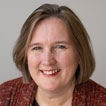
“This missionary is amazing!” My friend’s words piqued my interest. The woman he referred to had worked for several years in a devoutly Muslim community. I leaned in closer, wanting to hear exactly what was happening. “She has built such good relationships here. Everyone knows her!”
I listened further, curious to know how many had come to Christ through this amazing field worker. “She has hosted events on Christmas, Easter, and other times in the year. The people here love to come.” This was all good. I was encouraged to know that this unreached community had such an active and committed field worker.
As I continued to listen and ask questions, I was saddened, however, to discover a common reality playing itself out yet again in this unreached community. Only a few women had come to know Jesus. I dug a bit deeper, probing with further questions. Soon, I understood that although there were many great relationships, few spiritual conversations took place. ESL programs, events, and many positive things were happening, yet the gospel message was not proclaimed. The community was still unreached and likely to remain so unless changes took place.
Jesus Never Focused Only on Relationship Building
I admit it. My natural preference is to build strong relationships before bringing up the gospel. It’s far more comfortable to avoid the risk of rejection that comes when we begin to share about Jesus with those who don’t yet know him. I hold a firm commitment, however, to follow Jesus’ pattern of ministry. This is true, even when it’s not comfortable. I deeply desire, like most reading this, to be like him. I want to do what he did.
As I search the Gospels, I find times when Jesus had longer conversations with people like the woman at the well or the rich young ruler. At one point or another, those conversations always turned to the kingdom. I see no evidence, though, that Jesus first built a relationship for a few weeks, months, or years before he engaged in kingdom conversations. Though he was often indirect, asking questions and telling stories for those who had ears to hear, he never only built relationships.
Moving from Good Contacts to Good Conversations
Coaching my friend who worked with the above-mentioned missionary, I encouraged him to write out a list of the people with whom they had good relationships. I asked him to make a “relational chart.” Who do they know, and who are the others connected to that person? As he drew that out on paper and we discussed it, I saw they had many excellent opportunities. It was a great beginning to making disciples there, if they now took the next steps.
“What you need to do now is find out which of these people are spiritually open,” I told him. There is a difference between being relationally open and being spiritually open. Some of these people are relationally open to you but haven’t shown signs of being spiritually open. The only way to discover if someone is spiritually open is to have a spiritual conversation.
The fear of engaging in God conversations with those you’ve built relationships with is a major hindrance to the release of a disciple making movement. We must overcome our fear and be willing to lose relationships when we proclaim the gospel message.
The goal is not to have good relationships in a community. The goal is to make and multiply disciples of Jesus. Let’s not become confused about our purpose or delay too long in pursuing our true goal.
Some Relationships Need to End
Dr. Henry Cloud, author of the well-known Boundaries book, wrote another powerful book called Necessary Endings. It is not directly written to address disciple making and church planting but includes principles that have impacted many aspects of my life. The basic premise is that we must make tough and courageous decisions, allowing some things to end so that new and more fruitful things can emerge.
While there is indeed a risk to the relationship when you enter into a spiritual conversation with someone, there is also the possibility that they may be open and receptive. You don’t know what will happen until you have the conversation. If it causes distance in the relationship or a rejection, at least you have gained valuable information. It will inform your prayers and can tell you whether you need to move on to look for others who are more open.
You have limited time and resources to invest in kingdom work. Even if you are a full-time worker, you have only 24 hours a day and many other demands on your time. You cannot afford to invest years of your life in building relationships with those who are not spiritually open when thousands of other unreached people wait to hear the good news.
This may sound a bit harsh and not very relational, especially to those with more pastoral giftings. Our time, however, is something we must steward carefully. It’s one of our most valuable commodities. Please don’t misunderstand. I’m not saying we shouldn’t invest in relationships or love people simply because they are our neighbors. I’m not saying that the only reason we build relationships is to convert people. We must be extravagant with our love and build genuine relationships with those who don’t know Christ. We don’t talk to people only so we can make them Christians. They will sense that from a mile away!
But if we truly love someone, we will share the good news of Jesus with them. If we are true friends, we will talk to them about the most important person in our lives, the one who transforms us into new people.
Delaying a spiritual conversation with someone is evidence of both a lack of love and a lack of faith. Start by praying daily for your list of unsaved contacts. Pray with consistency and faith that God is at work in them. Then, step into an opening that comes to speak to them about Jesus. You might initiate a conversation with a question like, “What’s the most wonderful thing that’s ever happened to you?” Or perhaps, “If God could do a miracle for you, what would it be?
If you have noticed resistance to spiritual matters or Christianity, ask questions that express your curiosity. You could say something like, “I noticed when I bring up issues of faith, you seem a bit uncomfortable. I’d love to understand more about why that is. What’s your story? Did you have a bad experience with a Christian before?” Be a good listener and pray fervently that their hearts will become open and soft to the message of Jesus’ love.
Share Stories Freely as Jesus Did
Someone recently told me, “You are a good storyteller!” I was grateful for her compliment but responded, “I haven’t always been. It’s a skill you can learn.” Jesus was a masterful storyteller. Wherever he went, he told stories and asked questions. Our goal should be to become like him, sharing stories that people can relate to, and communicating spiritual truth that piques their interest to hear more.
One of the best stories we can share is our own story of transformation. It’s an important skill to learn and become comfortable using. In the training we run, we equip everyone to share their transformation story in three minutes or less. You begin by sharing what your life was like before Christ. I usually ask people to choose three main characteristics. Then you learn to share how you came to know Jesus, using non-religious and relatable language people can understand. Lastly, you share what is now different in your life. At the end, ask a question. “Do you have a story like this?” Or “Would you be interested to hear more about this sometime?”
When sharing this kind of story with someone, you find out if they are spiritually open. If they show interest, take the next step to invite them to read the Bible together. Make these conversations natural and conversational, not preachy. Don’t get in a rush to get them to pray a prayer of salvation. Take your time, but begin to talk of spiritual things.
God may also highlight a story in your mind to share with someone. A few weeks ago, I was in California staying in a hotel and met a man named Oscar. He was waiting tables at the breakfast buffet. I had spoken to him several times before, affirming him, and thanking him for his service. One morning, I went on a prayer walk. I prayed for him. God put it on my heart to share with him the story of Joseph. Returning to the hotel, I walked up to him and another man he was talking to.
“Hi Oscar! How’s it going?” I said. “This may sound a little weird, but I was praying for you just now and felt like I was supposed to share a story with you from the Bible. Would that be okay?”
He said, “Sure.” I then asked if he had ever heard the story of Joseph. Neither he nor the other elderly man standing beside him had heard it before. I shared the story briefly. They both were interested in it, showing surprise at the story’s twists and turns. At the end, I said, “I think you are a bit like Joseph, Oscar. God sees your hard work. If you will obey and follow him, he will lift you from these jobs and promote you into other positions.” I don’t often get prophetic words for others, but I deeply sensed I should give him that word of encouragement. Since I was leaving the next day, I gave him a card for the church I was training at.
A story. A word of encouragement, calling forth into his destiny in God. I found out that Oscar was spiritually open, not closed. He was someone who had ears to hear.
Overcome Fear and Step Out in Faith
The woman I mentioned at the beginning of this article is indeed an amazing missionary. She is working hard and building great relationships. I hope she will also take bold and courageous steps to begin to share the gospel with others. Some people might reject her, even becoming enemies, but some will receive Jesus. No one will receive him if she and her team aren’t willing to lose some relationships in the process of bolder proclamation.
In recent months, several in that community have moved to other parts of the country without getting to hear about Jesus. They met Christians who were friendly and who built relationships but never shared the hope that was within them. Perhaps that will have some effect, perhaps not. With 42% of the world living among unreached peoples, we can’t afford to build friendships with lost people yet never share the message of Jesus.
We should heed Paul’s admonition,
In the presence of God and of Christ Jesus, who will judge the living and the dead, and in view of his appearing and his kingdom, I give you this charge: Preach the word; be prepared in season and out of season; correct, rebuke and encourage—with great patience and careful instruction. For the time will come when people will not put up with sound doctrine. Instead, to suit their own desires, they will gather around them a great number of teachers to say what their itching ears want to hear. They will turn their ears away from the truth and turn aside to myths. But you, keep your head in all situations, endure hardship, do the work of an evangelist, discharge all the duties of your ministry (2 Tim 4:1–5, NIV).
Our goal is not to make many contacts for contacts' sake; it’s to make disciples of Jesus. Let’s overcome our fear of loss or rejection and be willing to initiate gospel conversations with those who desperately need to hear of his great love.
This is an article from the September-October 2024 issue: People Group Theory
September 01, 2024 by ANDREW RICHEY
Ancient Monastic Advice for Modern Cross- Cultural Workers

The monastic impulse first expressed itself within Christianity around the third century, as intrepid characters such as Paul of Thebes and Antony the Great shifted to the Egyptian desert in pursuit of the ascetic life. These “desert fathers” inspired thousands, both men and women, to follow suit, leading to the establishment of numerous spiritual communities that became the model and inspiration for virtually all forms of Christian monasticism that were to come.
I was first introduced to the desert dwellers by means of their teachings and wisdom collected in The Sayings of the Desert Fathers.1 Truthfully, it was a rough introduction. I found most of their “words of wisdom” to be quite befuddling and their way of life rather unappealing. But as I slowly worked my way through the Sayings, I was finally able to pinpoint why this was the case, that is, why their adopted lifestyle and its resultant viewpoints seemed so very foreign to me as a modern-day cross-cultural worker. The bottom line was that our lives were oriented around differing chief priorities.
Since as early as I can remember, I was confronted with and motivated by the following call: “The message of Christ hasn’t gone out enough. Something radical must be done!” And so I’ve spent the majority of my adult life in the “unreached, unengaged” world, attempting to get the gospel out. My chief priority: Gospel out.
The ancient monastics, on the other hand, seemed to be responding to a different call: “The message of Christ hasn’t gone in enough. Something radical must be done!” And so they spent their lives in the desert, attempting to get the gospel in. Their chief priority: Gospel in.
For the desert dwellers, it was all about genuine transformation. It was “Christ in me” or bust!—whereas most of my life has been focused on “Get Christ out there” or bust, with my own character formation hopefully taking place as a happy byproduct. One can easily predict how that has worked out: lots of frustration at a hoped-for byproduct never making its appearance.
What advice, then, might the ancient monastics have for cross-cultural workers like me? I have a feeling they might say something like, “Good on you for wanting to get the gospel out, but let’s not forget that your first task is to get the gospel in. Nurture your inner life. Focus on your own transformation. Then, with Christ formed in you, yes, go to the nations. Yes, offer the gift of your transformed/transforming self. And, yes, offer the gift of companionship to others on their journeys of transformation. And though this may sound harsh, we desert dwellers are called to point out that you have precious little to offer the nations if the only version of faith you know is one that leaves you basically unchanged. For faith without transformation isn’t much of a gospel at all.”
Perhaps a fitting conclusion would be to quote Father Ammonas directly on this score:
Do not suppose that because the righteous were in the midst of men it was among men they had achieved their righteousness. Rather, having first practiced much quiet, they then received the power of God dwelling in them, and then God sent them into the midst of men, having acquired every virtue, so that they might act as God’s provisioners and cure men of their infirmities.2
This article was originally posted here: 2hc.life/blog/ancient-monastic-advice-for-modern-cross-cultural-workers and is used with permission. Photo by Dylan Shaw on Unsplash
Endnotes
See Benedicta Ward, trans., The Sayings of the Desert Fathers: The Alphabetical Collection (Collegeville, MN: Liturgical Press, 1984).
Ammonas, Epistle 12, quoted in Christopher A. Hall, Worshiping with the Church Fathers (Downers Grove, IL: IVP Academic, 2009), 228–229 (emphasis added).
This is an article from the September-October 2024 issue: People Group Theory
September 01, 2024 by WERNER MISCHKE AND BUD HOUSTON
Recognized, Relativized, Reconciled Nuancing the People Groups Conversation

Scripture speaks to three interrelated dynamics concerning people groups. People groups are (1) recognized in God’s global purpose, (2) relativized by sin and by the glory of Christ, and (3) reconciled in Christ to other hostile peoples.1 Building on field-based stories, we propose ways to propel mission engagement in light of these dynamics.
People groups recognized in God’s global purpose
In Genesis 12:3, God promises Abram an astounding honor: “In you all the families of the earth will be blessed” (ESV). God’s promise is particular and global. Through Abram’s family, God will bless all kinship groups of the earth.
Two millennia later, the risen Christ instructs his followers, “Make disciples of all nations” (panta ta ethne) (Matt 28:19). Does ethne refer to gentiles in general or people groups in particular, hearkening back to Genesis 12:3? Dave Datema asserts:
Panta ta ethne in Matthew 28:19, whether translated as “all the Gentiles” or “all the nations,” was understood by both Matthew and his readers as a reference to both universality (everyone everywhere) and particularity (in all their diversity). … Panta ta ethne is both/and, not either/or.2
We further see the diversity of people groups in Revelation.3 The vision is clear: no people group is excluded or marginalized; none are hegemonic; all are honored. These texts are hope-filled. We refer to them as affirming texts.4
ï “By your blood you ransomed people for God from every tribe and language and people and nation” (Rev 5:9).
ï “A great multitude… from every nation, from all tribes and peoples and languages… before the Lamb” (Rev 7:9).
ï “By its light will the nations walk, and the kings of the earth will bring their glory into it… the glory and the honor of the nations” (Rev 21:24–26).
Zaza Kurds recognized. The Zaza are an ethnolinguistic community within the larger Kurdish peoples of Turkey. They were mostly unrecognized for decades due to Turkey’s assimilationist policies. Their Zazaki language and culture were suppressed.
However, as the Zaza have asserted their unique identity in recent years, the global Church has taken notice. Missionaries were assigned. Scripture translation efforts began. Prayer movements were launched. By God’s grace, Zaza communities have responded to the gospel with new believers baptized and churches formed. The once-overlooked Zaza are now recognized as a distinct people for whom Christ died and to whom he called into his kingdom.
Why is every–people–recognized an aim of missions? As Steve Hawthorne says, “It matters that mission and church leaders recognize and respect every kind of group identity. … People groups are important in mission primarily because of the value of each people group to the living God.”5
People groups relativized
The Bible not only gives witness to the recognition of people groups; it also relativizes all people groups. People groups are relativized by sin—and by the glory of Christ.
Fig. 1: Range of human groupings critiqued or judged by God
People groups are relativized by sin
Every form of humanity is under God’s judgment. The Bible speaks much about the sins of individuals. The Bible also identifies sin in familial, civic, tribal, national, imperial, and cosmic contexts (shown in Figure 1).6
Sin exists among all types of persons and groups. The diagram begins with individuals, then moves to family and tribe, churches, cities, people groups, or nations, then empires, and lastly, all humanity.7
Of special interest to this article are Revelation 11:9, 14:6, 17:15, and 19:15. Let’s call them “critiquing” texts because they contain judgments of people groups. Other texts also critique peoples being deceived (Rev 18:23; 20:3,8).
It’s because of sin that people groups are under God’s judgment. Isn’t it also because of sin that massive numbers of peoples often migrate to distant lands? Natural and manmade disasters compel people to flee destitution, war, violence, and oppression in their homelands. Fleeing destitution in Moab, Ruth the Moabite follows Naomi to join God’s people in another land (Ruth 1–4). Fleeing persecution, the Church comprised of Jewish believers is scattered to other lands; some interact with gentile peoples of whom many turn to the Lord (Acts 11:18–21).
Consider a contemporary example. Dag, a new Kurdish believer from an Iraqi village, gathered with believers in Nashville, his eyes bright with hope for true equality between all peoples. His journey has been fraught. He was expelled from religious instruction for questioning teachings that divided humanity into classes. Later, he was rejected for baptism by ancient Christian groups wary of Muslim converts.
But Dag was driven by a revelation he found in the Bible: God shows no partiality between people. “Love your enemies and pray for those who persecute you, so that you may be children of your Father in heaven,” one verse reads. Dag ached for this reality in his homeland, where deep divisions run along ethnic and religious lines.
Undeterred, Dag traveled far to find a church to baptize and welcome him as an equal brother in Christ. On that journey, he had a dream warning of tragedy, which he heeded to save his friends’ lives. This sign convinced him that God was blessing his path. That day, Dag was baptized into the family of believers bound not by ethnicity but by faith in Jesus.
We are persons and peoples who move. We live in a world of globalization, urbanization, and migration.8 We adapt to other cultures, historical events, and technology. And God intervenes. We see this in ourselves. We can see this in the Bible, early Christianity, and around the world. Virtually all people group identities are on a spectrum between “fixed and fluid.”9
To whom do we belong? Multitudes grapple with this question, negotiating hybrid identities in new lands and digital spaces with permeable borders. Relativizing one’s own people group? It’s mostly not a question of if. The question is when and to what degree.

Fig. 2: Loyalty to an in-group relative to an out-group vs. loyalty to Christ relative to an out-group
People groups are relativized by the glory of Christ
In Philippians 3, Paul relativizes his own people group. How so? First, Paul lists his sources of honor, including his tribal/ national (i.e., people group) honor (vv. 5–6). Then come shocking words:
But whatever gain I had… I count everything as loss because of the surpassing worth of knowing Christ Jesus my Lord. For his sake I have suffered the loss of all things and count them as rubbish, in order that I may gain Christ (Phil 3:7–8).
I count them as rubbish. The excellence of knowing Christ is such that— by comparison—family, tribe, people group, education, or other identity factors are “as rubbish.”10
Are Paul’s words about knowing Christ relevant to the discussion about people group theory? We propose a four-part answer to this question.
1. Paul considers himself an example. “Brothers, join in imitating me” and follow “the example you have in us” (Phil 3:17). Paul says, “Be like me.” This is for all believers: Knowing Christ relativizes all forms of traditional honor, including people group honor.
2. Paul’s previous loyalty to his in-group fueled hostility to the out-group. Saul’s loyalty to his people mutated into violence against an out-group (believers). Saul condones the stoning of Stephen, drags believers to prison, and threatens murder.11
To his peers, Saul’s in-group loyalty is considered ethical and good. They also approve of hostility toward the out-group (although unethical). This “ethical paradox of group loyalty”12 may be described in pattern (A) of Fig. 2 on p. 31. As loyalty to an in-group increases, the likelihood of unethical behavior to an out-group increases.
Things change dramatically when Jesus appears to Saul (Acts 9:3–5). Saul becomes Paul the Christ-follower. Saul sees allegiance to the God of Abraham as allegiance to Christ. Jesus calls Paul to be an apostle to the very out-group (gentiles) he had previously shunned. Paul’s transformation may be described in pattern (B). As loyalty to Christ increases, the likelihood of ethical behavior toward an out-group increases.
3. Paul’s loyalty to his own people group was relativized by his loyalty to God’s all-peoples promise. This did not mean Paul was disloyal to God’s ancient people—quite the contrary. Paul wants to be accursed for their sake (Rom 9:2). Paul plainly affirms his Jewishness (Rom 11:1).
Paul’spassionfor“knowingChristJesusmyLord”relativizedhispeoplegrouphonor.However,hispeoplegrouphonorandloyalty were relativized in another way: by his loyalty to God’s all-peoples promise—serving the out-group (gentiles). Paul embodies God’s promise to bless all the families of the earth.13 To Paul’s previous peer group of Jewish religious leaders—those who didn’t regard Christasamessiahforallpeoples—Paulwasviewedasdisloyal, alawbreaker, andanoutsider(thus, atargetforviolence).14 In this additional way, Paul’s loyalty to his own people group was relativized by his loyalty to Christ.
4. Paul’s passion for reaching all peoples hinges on his own people group being relativized. We propose a dual truth: The surpassing worth of knowing Christ relativizes Paul’s relationship with his own people group, and this is exemplary for all believers. Simultaneously, Paul’s passion for Christ being worshiped among all people groups is also exemplary (Rom 15:18– 21). This continues to inspire believers globally toward reaching all the peoples. Christ is all in all.
We also observe the people groups relativized in Revelation 5 and 7, where, although they are recognized, their recognition is far eclipsed by Christ’s glory. People groups are recognized and relativized in the beatific worship of the Lamb. Worthy… worthy… worthy is the Lamb!
Arab peoples relativized toward unity
Within Arab diaspora communities of Dallas-Fort Worth, believers are learning how Christ relativizes their ethnic identities. These Jesus-followers hail from numerous Arab countries and peoples—Jordanians, Algerians, Syrians, Egyptians, and more. “Before knowing Christ, our differences deeply divided us,” shares one believer.
Though still appreciating their rich Arab cultural heritages, an eagerness to exalt Christ above all creates an unexpected unity. Barriers break down as Jesus becomes their primary identity and loyalty. In the diaspora melting pot of the DFW metroplex, the worth of knowing Christ is relativizing traditional ethnic divisions and forging a reconciled Arabic-speaking body of believers.
For diaspora populations, ethnic identity shifts from the rigid boundaries of the homeland context to a more malleable self- perception. In their country of origin, identities revolved tightly around tribe, family, or locality, but in the diaspora, these narrow self-definitions widen.
Broad associations like nation, language, and religion become flexible markers contingent on the social setting. At the cricket club, they are simply South Asians. At the mosque, they have their linguistic-religious identity, Urdu-speaking Muslims. At the workplace among Christian Americans, they are Pakistani-Americans. Adherents reconfigure their diaspora identities, being both fixed and fluid, to leverage diverse self-conceptions in new social environments.
People groups reconciled
The Bible gives witness to all people groups recognized, relativized, and reconciled. The Bible’s storyline has Jesus reconciling all peoples, all nations, all things, indeed, the whole cosmos.15
Christ inaugurates a new reconciled way of being human.16 According to N. T. Wright, “[In Ephesians], after the opening statement of 1.10 … (‘the fullness of times’), we find a crescendo of ‘now’ moments: now, in the Messiah Jesus, the gentiles have been brought near to the God of Israel; now the mystery of full gentile inclusion has been revealed; now the age-old mystery can be made known to the rulers and authorities in the heavenly places” (2:13; 3:6, 10).17
Persons and peoples “brought near by the blood” are reconciled to God. Jews and gentiles, once hostile, are now also reconciled to each other. Reconciliation is vertical and horizontal “through the cross… killing the hostility” (Eph 2:13–16). Jew and gentile reconciliation through Christ is the prototype for all people groups being reconciled.18 Christ is our peace. Christ makes peace. Christ preaches peace (Eph 2:14, 15, 17).19
Peacemaker as church planter
Yeva is an Armenian believer. She has devoted her life to seeing Christ reconcile the divided peoples of the Caucasus. Despite her family’s past suffering at the hands of Turks and Kurds, an encounter with the Prince of Peace transformed Yeva’s heart. “Christ has torn down the dividing walls of hostility.”
Now, Yeva plants churches among Turks, Kurds from Turkey, and Armenians. She trusts that in Christ’s gospel of peace, their united fellowship will overcome ethnic barriers. As fractured groups gather in one spiritual family, Christ’s reconciliation is melting centuries-long hostilities. Yeva believes these new churches, whether integrated or parallel, will end age-old hatreds.
Jesus relativizes other human loyalties, putting them into balance for human flourishing. Christ has created a new social way of being united in our humanity (Eph 2:15). All believers are “fellow citizens,” part of God’s “household” (Eph 2:19).
Conclusion
Scripture presents three interrelated dynamics about people groups: they are
recognized, relativized, and
reconciled. People groups in the Bible are “fixed and fluid,” not unlike our world. We observe “fixity and fluidity” among people groups, in our own family histories and local contexts, major historical events, global trends, as well as in the task remaining.
Endnotes
This article is based on the forthcoming book One New Humanity: Glory, Violence, and the Gospel of Peace by Kristin Caynor and Werner Mischke (William Carey Publishing, 2025).
D.E. Datema, “The Universal Particularism of Panta ta Ethne: A Biblical Case for the Continued Viability of the People Group Concept in Mission,” Missiology 50, no. 2 (2022), 138–51.
See Steve Hawthorne, “A Biblical Understanding of People Groups,” EMQ 56, no. 4 (October–December 2000), 4–7.
See also Pss 67:3–4; 86:9; Isa 56:7; 66:18–23.
Hawthorne, “Biblical Understanding of People Groups,” 6.
Angels sin (2 Pet 2:4); the devil sins (1 John 3:8); Babylon sins (Rev 18:4–5).
Much discussion about people groups overlooks the Bible’s critique of groups. God’s judgment does not diminish God’s valuing of every people; rather, it amplifies the moral responsibility and dignity of every people in God’s purpose as well as their potential for transformation in Christ. Regarding God’s judgment of the peoples as a blessing, see Pss 67:4; 96:13.
See Minh Ha Nguyen, “Globalization, Urbanization, Migration, and Rethinking the People Group Concept,” EMQ 56, no. 4 (October–December 2000), 32–35.
See Denise Kimber Buell, Why This New Race: Ethnic Reasoning in Early Christianity (New York: Columbia University Press, 2005).
Regarding honor-shame dynamics in Phil 3:5–8, see Werner Mischke, “Six Ways the Bible Undermines Racism: (#3) “the surpassing worth of knowing Christ Jesus my Lord.” CultureLearner, July 2, 2020.
Acts 7:54–8:3; 9:1.
Michael Emerson and Christian Smith, Divided by Faith: Evangelical Religion and the Problem of Race in America (New York: Oxford University Press, 2000), 158. See also Reinhold Niebuhr: “The whole history of mankind bears testimony to the fact that the power which prevents anarchy in intra-group relations encourages anarchy in intergroup relations.” Niebuhr introduced the paradox of group loyalty in 1932 in Moral Man and Immoral Society (Louisville: Westminster John Knox, 2021), 16.
Rom 4:16–17; Gal 3:7–9; Eph 2:11–3:5.
Acts 22:30–23:15.
Rom 8:19–21; Eph 1:10; 2:13–16; Col 1:19–20; Rev 22:1–3.
Eph 2:15; 4:24; 2 Cor 5:17.
N. T. Wright, Paul and the Faithfulness of God (Minneapolis: Fortress, 2013), 556–57, Kindle.
See Tet-Lim N. Yee, Jews, Gentiles, and Ethnic Reconciliation: Paul’s Jewish Identity and Ephesians (Cambridge: Cambridge University Press, 2008).
See Willard M. Swartley, Covenant of Peace: The Missing Peace in New Testament Theology and Ethics (Grand Rapids: Eerdmans, 2006), 197–201.
This is an article from the September-October 2024 issue: People Group Theory
September 01, 2024 by JOSHUA PROJECT
Unreached of the Day Prayer Guide
September-October 2024

Please open the PDF to view and read the two-month prayer guide.
This is an article from the September-October 2024 issue: People Group Theory
September 01, 2024 by BRAD VAUGHN
The End Has Come: Why an Ethnolinguistic Reading of Matthew 24:14 is Extrabiblical

Matthew 24:14 states, “And this gospel of the kingdom will be preached in the whole world as a testimony to all nations, and then the end will come” (NRSV). This verse is often read as a directive for modern Christian missions to evangelize all ethnolinguistic groups with the purpose of hastening Christ’s second coming. (This view is integrally linked with popular understandings of “people group theory.”) However, an exegetical and contextual analysis of Matthew 24 within the framework of first-century events offers a different perspective, indicating that this prophecy was fulfilled within the lifetime of the early church.
The Context of Matthew 24
The chapter’s opening sets the context for interpreting Jesus’ meaning. Matthew 24:1–2 says,
As Jesus came out of the temple and was going away, his disciples came to point out to him the buildings of the temple. Then he asked them, “You see all these, do you not? Truly I tell you, not one stone will be left here upon another; all will be thrown down.”
The discourse begins with Jesus prophesying the destruction of the temple. His statement that “not one stone will be left here upon another; all will be thrown down” is a direct prediction of what occurred in AD 70 when the Romans, led by Titus, dismantled the temple during the siege of Jerusalem.
Then, in verse 3, we read:
When he was sitting on the Mount of Olives, the disciples came to him privately, saying, “Tell us, when will this be, and what will be the sign of your coming and of the end of the age?”
The disciples’ question in Matthew 24:3 links the destruction of the temple with signs of Jesus’ coming and the end of the age. This suggests an intertwining of the temple’s fall with broader eschatological events, as understood by the early Christians.
Indicators of First-Century Fulfillment
What about the rest of the chapter? The burden of proof falls on those who interpret Matthew 24 as primarily (if at all) referring to some final fulfillment in our future. Especially in light of 24:1–3, we have ample evidence to suggest that the chapter describes events that occurred in the first century.
1. False Christs and Prophets
Matthew 24:4–5, 11–24 warn of false messiahs and prophets who will deceive many. The first century saw numerous messianic figures, such as Theudas and the Egyptian prophet (described in Acts and by Josephus), who led people astray, fitting into the deception theme outlined by Jesus.
2. Wars and Rumors of Wars
Verses 6–7 speak of wars and rumors of wars, nation against nation, and kingdom against kingdom. The period leading up to AD 70 was marked by significant regional conflicts within the Roman Empire, including Jewish revolts and the broader geopolitical unrest in areas like Gaul and Britain.
3. Famines and Earthquakes
Verse 7 mentions famines and earthquakes. Acts and other historical sources like Tacitus and Suetonius record famines and natural disasters during this era, particularly under the reigns of Claudius and Nero.
4. Persecutions
Verses 9–10 predict persecutions against Jesus’ followers, a reality well documented in the New Testament and historical accounts regarding the early Church’s suffering under Rome.
5. The Abomination of Desolation
Verse 15 references the “abomination of desolation,” a term drawn from Daniel used here to likely signify the profane acts and sacrileges associated with the Roman siege of Jerusalem, including possibly the placement of idolatrous ensigns on the temple grounds.
6. Great Tribulation
Verses 21–22 describe a period of unparalleled tribulation, which can be correlated with the documented horrors and extensive destruction during the Jewish War, particularly in AD 70 when Jerusalem was sacked.
The Language of Matthew 24
How do we interpret the specific language found in Matthew 24, especially verse 14? First, what do the disciples mean by “your coming” and “the end of the age” (24:3)? As others have seen, these terms do not concern world-ending catastrophes, but rather major military upheavals that profoundly impacted the life of God’s people.1 Simply go read the prophets to see this standard way of speaking. The disciples’ language echoes the prophetic language in Isaiah, where God’s judgment against Egypt is depicted not as a literal descent on clouds but as a sovereign intervention into political and social affairs as punishment for idolatry (Isa 19:1).
In Matthew 24, the destruction of the temple and the “end of the age” are concurrent events, suggesting a monumental shift in God’s earthly dealings. The obliteration of the temple concerns more than a physical space; it also is a pivotal moment in the kingdom’s expansion and the divine mission. God is closing an age in which he dealt primarily with the nation of Israel; now the new covenant hastens in the gentiles. The church, consisting of believing Jews and gentiles, constitutes God’s temple.
In addition, the phrase “in the whole world” deserves attention. Elsewhere in ancient literature, the Greek word (οἰκουμένη) here routinely refers to the Roman Empire.2 In the New Testament, one such example is Acts 11:28, which says, “One of them named Agabus stood up and predicted by the Spirit that there would be a severe famine over all the world; and this took place during the reign of Claudius.” Similarly, Paul’s accusers assert, “For we have found this man a plague, one who stirs up riots among all the Jews throughout the world and is a ringleader of the sect of the Nazarenes” (Acts 24:5; cf. Acts 17:6; 19:27; Rev 3:10).
What about the phrase “as a testimony to all nations”? Paul Penley’s response is clear and concise. He explains,
Acts 2:5 claims that Jews “from every nation under heaven” gathered in Jerusalem and heard the disciples proclaim the Gospel in their native languages. That’s quite a universal claim if we read it with our globalized perspective. Jews from every nation under heaven heard the Gospel! If we read that claim without regard for the historical context, we would think Jews had come from China or from the Aztec nation or from the aboriginal peoples of what would become Australia. But such transportation wasn’t possible in the first century, and no Jews lived among all the distinct ethno-linguistic tribes on planet Earth at the time.
Claiming that Jews “from every nation under heaven” gathered in Jerusalem is simply a figure of speech. It meant that Jews had come from all over the known world.3
Not only this, but biblical scholars have long noted that “nations” (ἔθνος) in Scripture consistently refers to gentiles (i.e., non-Jews).4 Certainly, ἔθνος (particularly the singular) can signify “a people group in an ethnographic sense denoting a group of people with common affinity and way of life” (to include Israel).5 Still, in Matthew’s Gospel, we don’t see unambiguous examples where the plural ἔθνος refers to distinct sociolinguistic entities as opposed to gentiles more generally.
Whatever the case, even if we presuppose that ἔθνος in Matthew 24:14 speaks of sociolinguistic groups, we have no scriptural basis for demarcating one ethnic group from another (effectively making much “people group” strategy arbitrary or disconnected from any biblical foundation).6
Conclusion
If we want to understand the word “nations” in sociolinguistic terms, we are free to do so. However, we cannot appeal to the Bible to support that claim. To be clear, this article does not argue against some pragmatic uses of people group theory. My goal is more precise and biblically oriented. I’ve suggested that mission advocates ought not to use Matthew 24:14 to propagate people group theory. We certainly cannot claim Jesus’ words as a divine mandate for strategies and interpretations that depend on sociolinguistic definitions.
To accept the biblical evidence above does not necessarily mean we should throw out all efforts to reach “unreached people groups.” When we discern the meaning of Matthew 24:14, we see people group strategies for what they are—pragmatic efforts to make the task of spreading the gospel more manageable and equitable so that all people might have a chance to accept Jesus as Lord. There’s nothing wrong with that. The problem comes with ad hoc scriptural justifications and/or eisegesis by which we insert foreign ideas into the biblical text.
Scripture beckons us to break through sociolinguistic boundaries. This is why Revelation looks forward to the worship of Christ among “every tribe and people and language and nation” (Rev 5:9; 13:7). God will fulfill his promise to Abraham, “in your offspring shall all the families of the earth be blessed” (Acts 3:25; cf. Gen 22:18). These passages acknowledge God’s comprehensive plan to save people across social groups; they do not however give us license to commit eisegesis by using contemporary social science to define biblical terms.
Endnotes
For instance, Paul Penley, “Have We Misunderstood the Great Commission? ‘The End’ Jesus Predicted in Matthew 24:14 Started a Whole New Era,” Reenacting the Way (blog), 14 May 2017, http://www.reenactingtheway.com/blog/great-commission-is-complete-as-jesus-predicted- in-matthew-24-14.
Walter Bauer, BDAG. s.v. “οἰκουμένη.” rev. and ed. Frederick W. Danker, 3rd ed. (Chicago: University of Chicago, 2000).
Paul Penley, “Have We Misunderstood the Great Commission?;” and BDAG, s.v. “οἰκουμένη.”
For example, see Jarvis J. Williams and Trey Moss, “Focus on ‘All Nations’ as Integral Component of World Mission Strategy,” in World Mission: Theology, Strategy, and Current Issues ed. Scott Callaham and Will Brooks (Bellingham, WA: Lexham, 2019), 131–48.
Hans M. Weerstra, “Mission to the Nations: A Biblical Word Study of Ethnos,” IJFM 9, no. 3 (July 1992): 99.
Compare Darren Carlson and Elliot Clark, “The 3 Words That Changed Missions Strategy—and Why We Might Be Wrong,” The Gospel Coalition, 11 September 2019, http://www.thegospelcoalition.org/article/misleading-words-missions-strategy-unreached-people- groups.
This is an article from the September-October 2024 issue: People Group Theory
September 01, 2024 by CHRIS CLAYMAN
Complex Homogeneity among Urbanized UPGs: A Challenge and an Opportunity
From a paper presented at the 2022 Ralph Winter Lectureship.

From birth, Kadijata breached cultural norms in her country. Her mother, a Fulbe Futa, a subset of the larger Fulani people cluster, married one of the “forest peoples” of Guinea, West Africa. The Fulbe Futa people looked down on the forest people, and her mother’s family begrudged her divergence from endogamy. Shortly after Kadijata was born in Guinea’s forest region, her family moved to Conakry, the country’s capital.
In the city, Kadijata’s Fulbe Futa side quickly predominated. Kadijata’s mother spoke to her in Pular, the Fulbe Futa language, and Fulani family members from across the country frequented her home. In contrast, to “set Kadijata up for success,” her father spoke to her only in French. Month-long summer vacations were spent in the Futa Jalon (the Fulani region) instead of the forest. At the age of eight, Kadijata’s father moved to Eastern Europe for work. From that point on, she saw her father only when he returned on vacations. The residential and linguistic choices of Kadijata’s family meant her father’s ethnic identity effectively had no influence on his daughter. As far back as Kadijata can remember, she was always a Fulbe Futa.
While Kadijata spoke Pular and French at home and school, she also learned the lingua franca of Conakry, called Susu after the dominant ethnic group in the city, as well as Maninka to converse with her friends from that ethnic group. Because her family were devout Muslims, she also attended an Islamic school on weekends to learn and memorize the Qur’an in Arabic.
Shortly after her dad moved to Eastern Europe, Kadijata’s mom spent years with her husband in Europe or her brother in East Africa, leaving various aunts and cousins to take care of Kadijata and her siblings in Conakry. The international work and travel of her extended family piqued Kadijata’s global interests. As a teenager, Kadijata became the second-best junior table tennis player in her country, and she traveled to China as a Junior Olympian. There, she befriended competitors from Sri Lanka and Ethiopia, and continued corresponding with them for years.
At the age of 21, Kadijata received a scholarship to study telecommunications in Eastern Europe. She learned the language quickly and finished the equivalent of a bachelor’s degree in five years. Kadijata then moved to Paris to pursue a master’s degree and doctorate. Her plans were curtailed, however, when a relationship she formed with a fellow international student from Africa led to pregnancy. Kadijata’s conservative Islamic family felt shame over the ordeal, and she felt abandoned through their lack of support. Furthermore, her relationship with the baby’s father ended, leaving her as the sole provider for her baby daughter. She almost managed to complete her master’s degree, but the mounting pressure of single motherhood caused her to leave school and pursue a telecommunications career.
Kadijata earned a nice salary in Paris. She was promoted quickly through the company, frequently traveled France on business trips, and purchased a condo in southeast Paris. Her best friends were Caucasian French co-workers and neighbors, Senegalese families in her neighborhood, and Algerian, Caribbean, and Asian colleagues. But none of those friends were Fulani. Kadijata was hurt by her people for the way they treated her after becoming pregnant. She threw herself into her work and quickly adopted a French lifestyle. When asked what people she belonged to during that time, Kadijata said, “I was French. To some people, I would identify as African or Guinean, but I was French.” Noticeably absent was an identification with the Fulbe Futa, from whom she had steadily distanced.
One of Kadijata’s co-workers was a Cambodian immigrant who had married a Muslim-background Christian pastor from Mali. Knowing about the West African Muslim culture, the co-worker was burdened to pray for Kadijata and share Jesus with her. At an opportune time, she gave Kadijata a recorded testimony in French of a West African imam who had turned to Christ. Kadijata knew a lot about the Qur’an, but she was unfamiliar with verses the former imam cited about Jesus’ followers being superior to those who reject faith to the day of resurrection (Al-Imran 3:55) or those having doubts being encouraged to ask Christians (i.e., those who have been reading the “before books,” Yunus 10:94). From her Islamic religious worldview, these verses gave her confidence to attend church and read the Bible. Soon after, she decided to follow Christ and was baptized.
Kadijata continued to be discipled in multi–ethnic French churches. For the next 13 years, she grew in faith, became a woman of prayer, and shared Jesus with others. Kadijata even wrote long notes to her family shortly before her baptism explaining why she followed Jesus. While her decision ostracized her even more from her family, several of her family members had moved to France and Italy, and she was able to continue relationship with some individuals. Her father, an influential man, became a follower of Christ as well, partly due to Kadijata’s witness. He then went on to share Jesus with many people back in Guinea; one of Kadijata’s sisters even came to Christ and is now married to a pastor.
Thirteen years after becoming a Christian, God called Kadijata to be a missionary in New York City. Through a variety of divine appointments, including an offer of free housing in Manhattan from a local church connection, Kadijata moved to New York and began learning English. One day, she observed a rally of Hispanic and African Americans beleaguered by the drug and crime epidemic in their communities.
Moved by their cries, Kadijata began ministering among the homeless and drug addicts. She fed them, pointed them to social centers for counseling, shared the gospel, prayed for them, and started Bible studies. Meanwhile, Kadijata frequently passed by dozens of West African Muslim women in hair-braiding shops, the subway, and on the streets. A missionary family also formed a relationship with Kadijata. They were spreading a vision of reaching West African Muslims throughout the city. One day on the way to church, Kadijata met a Fulani cab driver who knew her family and revealed that dozens of her extended family members were in the city. Being estranged from many members of the family, Kadijata had no idea!
All these events set in motion God’s call for Kadijata to share Jesus with the Fulbe Futa and other West African Muslim women. As she began meeting the Fulbe Futa community, she realized that many women only spoke Pular. Even though Kadijata’s first language was Pular, she struggled talking about Jesus, sharing the Bible, or praying in her language. She was more comfortable talking about her faith in French and English. To remedy the cultural disconnect, Kadijata began reading and listening to the Bible, praying, and sharing Jesus in her mother tongue, which connected to her heart in fresh ways.
Kadijata had rarely heard of Christians from her people group, but she began discovering hundreds who came to faith in Christ in Africa and Europe. Through joining their social media groups, praying with them, and aiding their evangelism campaigns, she effectively joined a global Fulbe Futa Christian community. Kadijata’s family observed three decades of her life-transforming faith journey, and many have opened fellowship with her again.
Because of Kadijata’s strong character, Muslim family members call on her to give wisdom and counsel to life’s varied complications. Kadijata has come full circle. She desires nothing more than glorifying Christ with her life and being used to introduce her Fulani people to his kingdom. She’s a member of God’s family, and she’s also Fulbe Futa—with a French accent. No doubt, her story illuminates several observations that are applicable to other hybridized members of urban unreached people groups.
This is an article from the September-October 2024 issue: People Group Theory
September 01, 2024 by DAVE EARL DATEMA
People Groups and the Bible

The following article is a condensed and revised version of an original article published in Missiology: An International Review 49:3, (2021), entitled “The Universal Particularism of Panta ta Ethne: A Biblical Case for the Continued Viability of the People Group Concept in Mission.” Used with permission from Sage Publishing. Last published in Mission Frontiers, Jan/Feb 2022.
Please read this article in the PDF version. Please note we are aware that there are some issues with the Hebrew font/text in this article.
This is an article from the September-October 2024 issue: People Group Theory
September 01, 2024 by WARRICK FARAH
The Graying (and Browning) of Frontier Missiology

As I write this, I’m sitting on a plane, reflecting on a conference I just attended, which was geared towards engaging unreached and unengaged Muslim people groups. Not my first conference on this important topic. Twenty years ago, I was the youngest in the room. But now, as a middle-aged, overweight man on Rogaine, I’m still one of the youngest in the room.
My balding head even has some gray hair now. My wonderful colleagues, who are committed to reaching the unreached, are also all graying. These observations aren’t merely about hair color. They reflect what we might call the graying of frontier missiology.1
Even the majority world unreached peoples advocates in the room are older and grayer. It is indeed thrilling to see so many Muslim background believers (MBBs) in these conversations as well. They will one day outnumber Westerners. The room is not just getting grayer; it is also getting browner, with fewer White people. So, our understanding of the unreached peoples concept needs both intergenerational and intercultural analysis.
Anomalies in the Frontier Missiology Discourse
I am still filled with a passion to “reach the unreached.” The telos of the motus Dei (Latin for “movement of God”) extends to all peoples. The great I Am is no mere tribal or national deity. The basis for our passion to see Jesus worshiped by ALL ethne is biblically clear and compelling. It should break our collective heart to see this vision minimized in some corners of mission.
But today, where are the younger generations of believers in the unreached people group (UPG) rooms and conversations? Among Western evangelicals, in another 20 years, will there be any groups to embrace and champion the concept of unreached peoples? There are exceptions, of course, but these tend to prove the rule.
I’m not attempting to identify all the potential reasons for the apparent lack of buy-in from younger Western Christians. (Theological drift is part of the reason, but that is for another article.) I will also try not to be reductionistic. However, let me offer a couple thoughts.
In the West, Gen Z and Millennials are the most stressed out and anxious generation alive today. They have grown up in a fast-paced digital era characterized by constant connectivity and exposure to social media. This constant online presence can contribute to feelings of comparison, self-doubt, and FOMO (“fear of missing out”). They also have lived through several significant traumatic global events at key periods in their lives. While Gen X and Boomers want to thrive, Gen Z just wants to survive.
In light of this, let’s look at some of the language employed in frontier missiology:
Finishing the Task | Reaching the Unreached | Changing the World | Fulfilling the Great Commission | Saving People from Hell | Mobilizing for the Frontlines | In the Trenches of Ministry | Behind Enemy Lines | Storming the Gates of Hell
These slogans appeal to some generations. They provide a sense of responsible, manageable urgency for Boomers and Gen Xers. But for Millennials and Gen Z, the same urgency might simply add to their stress and anxiety. For Gen Z to be told that they need to rescue a mission in decline or to imply that they are responsible for the status of world evangelization seems counterproductive.2
Additionally, we might benefit from more holistic and self-critical perspectives on mission. We have scales for the progress of evangelization, but we might also include scales for the progress of transformation. For example, if we say that Arab Muslims are the least reached and least engaged people cluster in the world, then we might say that American evangelicals are the least-transformed people cluster in the world. Many younger American Christians and Majority World leaders are absolutely disillusioned by the moral and political compromise they see in the American church. To give our lives for the unreached while ignoring the problems “at home” looks like escapism and hypocrisy.
Intergenerational and Intercultural Re-posturing
So, the UPG discourse needs to re-theologize some of our posturing: not the concept but the language or framework we use to discuss it. This may help not only with mobilization but even with clarifying the UPG concept itself. Leslie Newbiggin was prescient in this regard:
I find it strange that conferences about mission and evangelism are often pervaded… by a kind of anxiety and guilt—as though it were a program that we have a responsibility to carry out and about which we’ve not been very successful. Isn’t it remarkable that according to the New Testament the whole thing begins with an enormous explosion of joy? The disciples returned to Jerusalem with great joy and were continually in the temple praising God! It seems to me, the resurrection of Jesus was a kind of nuclear explosion which sent out a radioactive cloud, not lethal, but life-giving, and the mission of the church is simply the continuing communication of that joy—joy in the Lord.3
Instead of an urgency of responsibility, perhaps we need an urgency of joy and love. Or instead of urgency, we can speak of an apostolic calmness or a non-anxious resolve.
Bible Project’s visual commentary on Genesis 1 points out that in contrast to the Babylonian and Egyptian creation myths, we have an all-powerful Royal Artist creating the cosmos—not from violence, but in order and peace and harmony.4 This kind of language matches the narrative aspirations of both Gen Z and the cultural values of much of Asia and Africa.
And through faith in Christ, the “new creation” is breaking into the present, including the “glory and honor of the nations” (Rev 21:26 NIV). Through our love and unity, the world will know (John 13:35). Jesus says, “I am making everything new” (Rev 21:5). He is healing “the nations” (Rev 22:2).
In light of this, we might brainstorm a few shifts that need to take place in our framework. I am not married to these proposals; they are simply suggestions hoping that others may offer improvements!
1. From Closure Missiology to Holistic Disciple Making. In the NT, the future coming of King Jesus inspires ethical considerations like integrity and justice, not simply a warning to complete our missional requirements. The Great Commission was a brilliant metaphor in its day, probably originating in the 1600s and popularized by Hudson Taylor two centuries later. But as Chris Wright summarizes, “The Great Commission is an expanding and self-replicating task, not a ticking clock for the end times.”5
1. From Pathology to Inclusivity. Jay Matenga remarks that mission is often framed as a people living in a state of pathology: they are broken, and we have the solution.6 Unconsciously, this implies a superior/inferior dynamic between “us” and “them.” Instead, a giftive7 mission metaphor creates hospitable space for people to explore being “grafted in” (Rom 11:25) to the covenantal people of God in Christ. In this way, planting people-specific churches is not seen as exclusive but inclusive in nature.
2. From Missional to Movemental. The missional conversation has transpired over the past 25 years in North America when the church has simultaneously lost 40 million members. Perhaps the best form of a missional church is a movemental church that multiplies in unexpected places.8
3. From Unreached to Emerging. The term “emerging” may be a more positive and dynamic term compared to “unreached.” It suggests that these peoples are in the process of God’s sovereign activity rather than being static and neglected. It also implies potential and progress, which may equip others for more hopeful and proactive approaches to catalyzing movements.
Our Collective Challenge
At the moment of writing this, my 19-year-old son is in North Africa on a short-term trip. The ideas in this short article were field-tested with him and his peers as a way to retool our framework for mission to peoples who have precious few believers and local churches. By using biblical concepts that focus on hospitality, joy, healing, life, justice, and equipping, it might be possible to appeal to the aspirations and values of Millennials, Gen Z, and Majority World MBBs while providing a positive and less stressful framework for the motus Dei, which is to redeem the nations back to Jesus. In him, a sacrificial adventure of joy awaits.
Endnotes
I believe I first heard this phrase from Brad Gill, editor of IJFM.
Daniel Yang, “Beyond Growth and Decline,” Outreachmagazine.Com (blog), 2023, outreachmagazine.com/features/73902-beyond- growth-and-decline.html.
Leslie Newbigin, Signs amid the Rubble: The Purposes of God in Human History, ed. Geoffrey Wainwright (Cambridge, UK: Eerdmans, 2003), 121.
Jon Collins and Tim Mackie, “Understand God’s Creation Story | Genesis 1 Commentary Video,” Bible Project, 2020, bibleproject. com/explore/video/genesis-1/.
Christopher J. H. Wright, The Mission of God: Unlocking the Bible’s Grand Narrative (Downers Grove, IL: IVP Academic, 2006), 35.
"The Wellbeing Imperative,” Jay’s World (blog), 2023, jaymatenga.com/wellbeing-imperative/.
Frances S. Adeney and Terry Muck, Christianity Encountering World Religions: The Practice of Mission in the Twenty-First Century
(Grand Rapids: Baker Academic, 2009), 328.
Wes Watkins, “From Missio Dei to Motus Dei: The Recovery of Movement,” Arab Baptist Theological Seminary (ABTS) (blog), 2024, abtslebanon.org/2024/05/23/from-missio-dei-to-motus-dei-the-recovery-of-movement.
This is an article from the MAY-AUGUST 2024 issue: PERSPECTIVES TURNS 50
May 01, 2024 by CORE4RESEARCH
Transforming the Church, One Person at a Time

Click on the PDF icon to view or download this article.
This is an article from the MAY-AUGUST 2024 issue: PERSPECTIVES TURNS 50
May 01, 2024 by R. Gregory DuHart Sr.
Perspectives:
An Integrative Approach to Discipleship

Click on the PDF icon to view or download this article.
This is an article from the MAY-AUGUST 2024 issue: PERSPECTIVES TURNS 50
May 01, 2024 by Gary Peterson
A Perspective on Perspectives

Click on the PDF icon to view or download this article.
This is an article from the MAY-AUGUST 2024 issue: PERSPECTIVES TURNS 50
May 01, 2024 by PAUL DZUBINSKI
Innovating Missions Education: The Perspectives Course’s Innovative Journey

Click on the PDF icon to view or download this article.
This is an article from the MAY-AUGUST 2024 issue: PERSPECTIVES TURNS 50
May 01, 2024 by Stacy Lee, Chris Sheeran, Andy Minch, and Ben Thornley
Reflections from Wycliffe Staff

Click on the PDF icon to view or download this article.
This is an article from the MAY-AUGUST 2024 issue: PERSPECTIVES TURNS 50
May 01, 2024 by Matthew Ellison
The Fruit of Perspectives in Local Churches

Click on the PDF icon to view or download this article.
This is an article from the MAY-AUGUST 2024 issue: PERSPECTIVES TURNS 50
May 01, 2024 by Rebecca L. Meyer, PhD, MSNed, BSN, RN
How Perspectives Changed My Perspective

Click on the PDF icon to view or download this article.
This is an article from the MAY-AUGUST 2024 issue: PERSPECTIVES TURNS 50
May 01, 2024 by Richard M. Verreynne
From a Packed Lunch to Great Banquet

Click on the PDF icon to view or download this article.
This is an article from the MAY-AUGUST 2024 issue: PERSPECTIVES TURNS 50
May 01, 2024 by GREG H. PARSONS
Why Mobilize?

Click on the PDF icon to view or download this article.
This is an article from the MAY-AUGUST 2024 issue: PERSPECTIVES TURNS 50
May 01, 2024 by
Perspectives Turns 50

PDF Part 2 of Perspectives Turns 50
This is an article from the MAY-AUGUST 2024 issue: PERSPECTIVES TURNS 50
May 01, 2024 by SUE PATT
History in the Making

Click on the PDF icon to view or download the article.
This is an article from the MAY-AUGUST 2024 issue: PERSPECTIVES TURNS 50
May 01, 2024 by Markos Zemede, MD
“Dr. Perspectives”:
A Cataract Surgeon

Click on the PDF icon to view or download this article.
This is an article from the MAY-AUGUST 2024 issue: PERSPECTIVES TURNS 50
May 01, 2024 by JAY MATENGA
Hoodwinked:
This Is a Missions Program!

Click on the PDF icon to view or download this article.
This is an article from the MAY-AUGUST 2024 issue: PERSPECTIVES TURNS 50
May 01, 2024 by Lisa Smart
The View From the Launchpad

Click on the PDF icon to view or download this article.
This is an article from the MAY-AUGUST 2024 issue: PERSPECTIVES TURNS 50
May 01, 2024 by Estevão Muller
God’s Impact on the Brazilian Perspectives Movement

Click on the PDF icon to view or download this article.
This is an article from the MAY-AUGUST 2024 issue: PERSPECTIVES TURNS 50
May 01, 2024 by Neil Moyer
He Is Worthy:
A Perspectivas Class in Central Florida

Click on the PDF icon to view or download this article.
This is an article from the MAY-AUGUST 2024 issue: PERSPECTIVES TURNS 50
May 01, 2024 by Claudia Bustamante
Telling Our Story in His Story!

Click on the PDF icon to view or download this article.
This is an article from the MAY-AUGUST 2024 issue: PERSPECTIVES TURNS 50
May 01, 2024 by Yvonne W. Huneycutt
A Movement Propelled by Hope

Click on the PDF icon to view or download this article.
This is an article from the MAY-AUGUST 2024 issue: PERSPECTIVES TURNS 50
May 01, 2024 by Joe Gober
Perspectives as Worship

Click on the PDF icon to view or download this article.
This is an article from the MAY-AUGUST 2024 issue: PERSPECTIVES TURNS 50
May 01, 2024 by Bruce and Christy Graham
We Were There:
Looking Back 50 Years Ago!

Click on the PDF icon to view or download this article.
This is an article from the MAY-AUGUST 2024 issue: PERSPECTIVES TURNS 50
May 01, 2024 by JOSHUA PROJECT
Unreached of the Day
Daily Prayer for May through August 2024

Click on the PDF icon to view or download this 4 month prayer calendar.
This is an article from the MAY-AUGUST 2024 issue: PERSPECTIVES TURNS 50
May 01, 2024 by TIMOTHY O. OLONADE
Every Step of the Way!:
A Generation-Long Series of Encounters

Click on the PDF icon to view or download this article.
This is an article from the MAY-AUGUST 2024 issue: PERSPECTIVES TURNS 50
April 30, 2024 by Dave Coles
How God Transformed a Devout Muslim and Catalyzed DMMs among UPGs

Click on the PDF icon to view or download this article.
This is an article from the March-April 2024 issue: Seeking Movements among Frontier Peoples
March 01, 2024 by BOB GOLDMANN
Entrepreneurial Strategies for Reaching Frontier Peoples

This is an article from the March-April 2024 issue: Seeking Movements among Frontier Peoples
March 01, 2024 by GENE DANIELS
The Importance of Reflective Practice for Missionaries

Click on the PDF icon to read or download the article.
This is an article from the March-April 2024 issue: Seeking Movements among Frontier Peoples
March 01, 2024 by DR. ANON
Understanding Christward Movements in India

Click on the PDF icon to read or download the article.
This is an article from the March-April 2024 issue: Seeking Movements among Frontier Peoples
March 01, 2024 by JAMEY LEWIS
Walking Together in the Second Half of Life
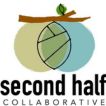
Click on the PDF icon to read or download the article.
This is an article from the March-April 2024 issue: Seeking Movements among Frontier Peoples
March 01, 2024 by PAUL DZUBINSKI
Entrepreneurship at the Frontiers of Faith

Click on the PDF icon to read or download the article.
This is an article from the March-April 2024 issue: Seeking Movements among Frontier Peoples
March 01, 2024 by CHARLOTTE D.
Wholistic Disciple Making: Multiplying Churches and Transforming Communities

Click on PDF icon to read or download the article.
This is an article from the March-April 2024 issue: Seeking Movements among Frontier Peoples
March 01, 2024 by R.W. LEWIS
Needed: A Strategy for the 300 Largest Frontier People Groups

Click on PDF icon to read or download the article.
This is an article from the March-April 2024 issue: Seeking Movements among Frontier Peoples
March 01, 2024 by CINDY ANDERSON
Mobilizing Near-Culture Movements to Reach Frontier Peoples

Click on the PDF icon to read or download the article.
This is an article from the March-April 2024 issue: Seeking Movements among Frontier Peoples
March 01, 2024 by YASHWANT KOLI
The Final Frontier: India’s Other Backward Castes

Click on the PDF icon to read or download the article.
This is an article from the March-April 2024 issue: Seeking Movements among Frontier Peoples
March 01, 2024 by WILLIAM CAREY PUBLISHING
Book Recommendations

Click on the PDF icon to view book recommendations from William Carey Publishing (WCP).
This is an article from the March-April 2024 issue: Seeking Movements among Frontier Peoples
March 01, 2024 by JOSHUA PROJECT
Unreached of the Day Prayer Calendar

Click on the PDF icon to read or download the latest copy of the UOTD two-month daily prayer guide.
This is an article from the March-April 2024 issue: Seeking Movements among Frontier Peoples
March 01, 2024 by GREG H. PARSONS
Strategy Questions: The Meaning of Christian and Using the Qur’an

Click on the PDF icon to read or download the article.
This is an article from the March-April 2024 issue: Seeking Movements among Frontier Peoples
March 01, 2024 by ROBBY BUTLER
Strategic Prayer Fuels Pioneer Mission Work!

This is an article from the March-April 2024 issue: Seeking Movements among Frontier Peoples
March 01, 2024 by JOHN ROBB
Adopt a People Movement: Bringing Back the King of Kings!

Click on PDF icon to read or download the article.
This is an article from the March-April 2024 issue: Seeking Movements among Frontier Peoples
March 01, 2024 by SUE PATT
Editorial

Click on the PDF icon to read or download the article.
This is an article from the March-April 2024 issue: Seeking Movements among Frontier Peoples
March 01, 2024 by H.L. RICHARD
Devout Hindus: Anti-Church but Not Necessarily Anti-Christ

Click on PDF icon to read or download the article.
This is an article from the March-April 2024 issue: Seeking Movements among Frontier Peoples
March 01, 2024 by R. REKEDAL SMITH
Testimony of a Viable, Indigenous Church Planting Movement
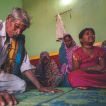
Click on PDF icon to read or download the article.
This is an article from the March-April 2024 issue: Seeking Movements among Frontier Peoples
February 29, 2024 by STAN PARKS
The Best Hope for Reaching Frontier People Groups

Click on the PDF icon to read or download the article.
This is an article from the January-February 2024 issue: On the Move with Nomadic Peoples
January 01, 2024 by As told to JON BANKE
The Testimony of Tambaya Ibrahim

Article is used with permission from AfriGo.
Click on the PDF icon to open and read the article.
This is an article from the January-February 2024 issue: On the Move with Nomadic Peoples
January 01, 2024 by RICK WOOD
My Final Word to the Church
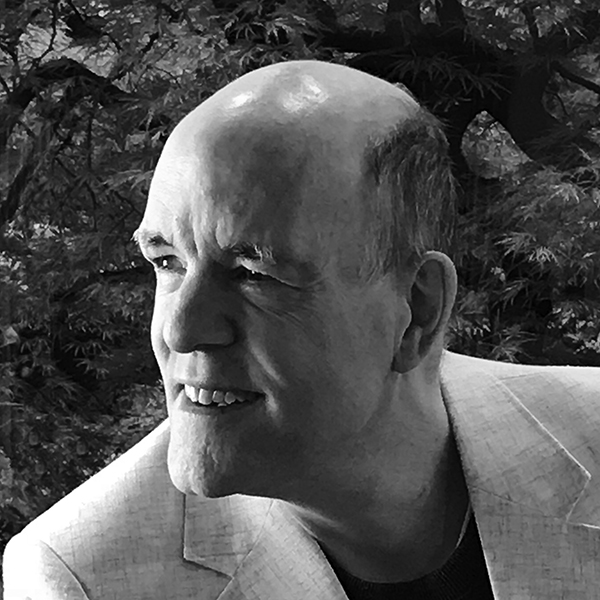
Click on PDF icon to read the article.
This is an article from the January-February 2024 issue: On the Move with Nomadic Peoples
January 01, 2024 by JULIA WOODS
Who Will Go?
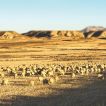
Click on the PDF icon to open and read article.
This is an article from the January-February 2024 issue: On the Move with Nomadic Peoples
January 01, 2024 by RON AHLBRECHT
Let Nomads Move You!

Click on the PDF icon to open and read the article.
This is an article from the January-February 2024 issue: On the Move with Nomadic Peoples
January 01, 2024 by DANIEL SAMBO & KATHARINE NORTON
Herders and Their Amazing Economic Impact
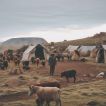
Click on the PDF icon to open and read the article.
This is an article from the January-February 2024 issue: On the Move with Nomadic Peoples
January 01, 2024 by RON & KIRSTEN AHLBRECHT
The Nomadic Peoples Network (NPN) A New Breed

Click on the PDF icon to open and read the article.
This is an article from the January-February 2024 issue: On the Move with Nomadic Peoples
January 01, 2024 by SAMIRA OFFEREIGNS
Nomad Connect
A Learning Journey
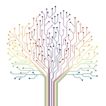
Click on the PDF icon to open and read the article.
This is an article from the January-February 2024 issue: On the Move with Nomadic Peoples
January 01, 2024 by
Unreached of the Day JAN/FEB 2024
Click on the PDF icon to view the UTOD prayer calendar.
This is an article from the January-February 2024 issue: On the Move with Nomadic Peoples
January 01, 2024 by PAUL DZUBINSKI
Innovation Among the Unreached
A Journey with Nomads

Click on the PDF icon to open and read the article.
This is an article from the January-February 2024 issue: On the Move with Nomadic Peoples
January 01, 2024 by JAMESON HARTIN
Changes in Central Asian Nomadic Life

Click on the PDF icon to open and read article.
This is an article from the January-February 2024 issue: On the Move with Nomadic Peoples
January 01, 2024 by YUSUF HABU NA'ANGO AND KATHARINE NORTON
The Tale of Two “Brothers” A True-Life Story

Click on the PDF icon to open and read the article.
This is an article from the January-February 2024 issue: On the Move with Nomadic Peoples
January 01, 2024 by ROGER CHARLES
M4M: Local Media, Bibles, and Worship for the Next Billion Believers
24:14 Goal: Movement Engagements in Every Unreached People and Place by 2025 (24 Months)

Click on the PDF icon to open and read the article.
This is an article from the January-February 2024 issue: On the Move with Nomadic Peoples
January 01, 2024 by EVELYN HIBBERT, LANCE AND BARBARA WILLIAMS
Elastic Church
Developing a Different Paradigm of Church for Nomads

Click on the pdf icon to open and read the article.
This is an article from the January-February 2024 issue: On the Move with Nomadic Peoples
January 01, 2024 by JOY MARLOWE
Searching for New Pastures

Click on the PDF icon to open and read the article.
This is an article from the January-February 2024 issue: On the Move with Nomadic Peoples
January 01, 2024 by CYNTHIA ANDERSON
Mobilizing Every Believer to Make Disciples
A Call for a New Paradigm
Click on the PDF icon to open and read the article.
This is an article from the January-February 2024 issue: On the Move with Nomadic Peoples
January 01, 2024 by REV. AGABI E. ODE
Redeeming the Starving Shepherds

Click on the PDF icon to open and read the article.
This is an article from the January-February 2024 issue: On the Move with Nomadic Peoples
January 01, 2024 by LAURA ANNE MICHAELIS
Desert Births

Click on PDF icon to open and read the article.
This is an article from the January-February 2024 issue: On the Move with Nomadic Peoples
January 01, 2024 by JON BANKE
Beautiful Feet Bringing Sweet News

Click on the PDF icon to open and read the article.
This is an article from the January-February 2024 issue: On the Move with Nomadic Peoples
January 01, 2024 by JAMESON HARTIN
Disappearing Kyrgyz Villages in the Pamirs
Three years after COVID-19, what has changed?

Click on the PDF icon to open and read the article.
This is an article from the January-February 2024 issue: On the Move with Nomadic Peoples
December 18, 2023 by GREG H. PARSONS
When Bible Training Falls Flat
October 20, 2023, on a flight from CNX to BKK

Click on the PDF icon to open and read the article.
This is an article from the November-December 2023 issue: Movements Accelerating through Crisis Response
November 01, 2023 by Rick Wood
The Power of a Decentralized Gospel

In our world today, we are used to hearing about big bureaucratic organizations: Big Tech, Big Pharma, Big Agriculture, Big Government and Big Churches. We tend to think that big problems require big organizations to solve them. But big organizations also come with big negatives as well. Big organizations tend to be impersonal with one-size-fits-all solutions to the needs of people. Big organizations want people to adapt to their policies and procedures rather than adapting to meet the needs of individuals. They tend to be inflexible and slow to adapt in rapidly changing circumstances. When interacting with these big organizations, people often feel like they are not being heard and that they are getting “the run around.” Is there a better way to solve problems, make disciples, plant churches, and deal with crises when they occur?
The Power of Small Groups
For 13 years now, I have talked about the power of Disciple Making Movements to reach the unreached peoples as disciples make disciples and churches plant new churches one generation after another. These churches start out as small “discovery groups” where people are introduced to the Gospel and the Bible. They begin to follow Jesus and learn how to make disciples who will disciple others and start new churches. These discovery groups become churches as they begin to perform all the functions of a healthy church. One of those functions is ministering to the needs of those in the church.
If one member of the group has a need, another member may be able to meet that need or help provide the funds needed. Or someone in the group may know someone who can help. Instead of looking to a big organization to meet this need, they are looking to the Lord and each other. It is a very personal way to meet needs without the top-down control or bureaucracy of a big organization. If the need is more widespread, as in the case of a crisis or disaster, many groups or churches in a network can come together to help meet the needs within the wider community. These groups possess the love of Christ, a wide range of skills, and a dynamic flexibility that can be employed when disaster strikes.
As seen in our lead article starting on page 8, these small groups are transforming the way people respond to crises. In the process, Jesus is being exalted and lives are being saved, both physically and spiritually. The crises that are occurring around the world, among the unreached peoples, are providing fertile soil for a viral response to the Gospel as these small churches meet the needs of their neighbors during a crisis. In some cases, former persecutors of the Church come to faith in Jesus when they see the loving response of believers to their needs during a crisis. Small churches filled with trained disciples of Jesus are the most effective responders in a crisis, because their response is personally tailored to each person or family. This does not mean there is not a need for a response from larger organizations. It does mean that there is no substitute for trained disciples who are the neighbors and friends of those in need during a crisis. It is more likely that a person who is of the same culture will be able to reach their neighbor with the Gospel than someone from the outside.
This issue is all about how God is using crises of many kinds to soften the hearts of the unreached peoples while using small groups/churches to meet the needs of those who are suffering. In the process, God is causing movements of discipleship and church-planting to grow among the unreached. We wish that crises would not occur, but they are a sad reality of living in a fallen world. But God is using these crises to bring people to Himself through the power of multiplying movements of discipleship and church-planting.
The Amazing Progress of the Gospel
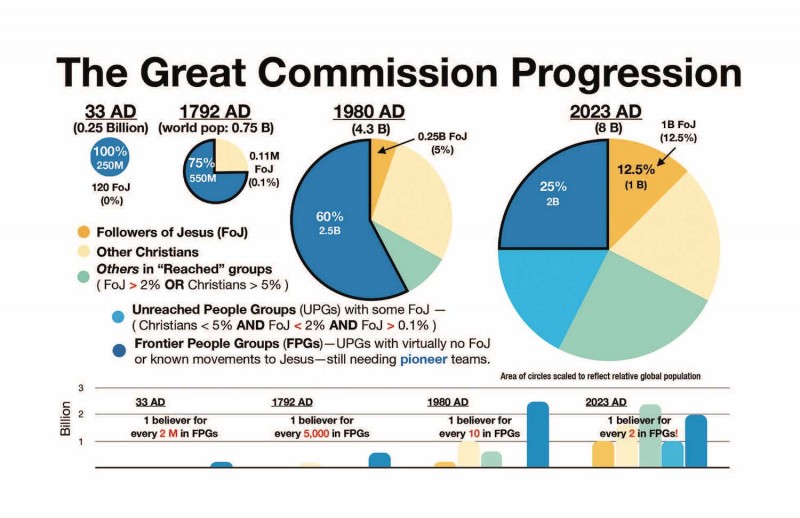
With all the bad news that floods the airways each day, it’s easy to think that we are losing the struggle to reach every people with the Gospel. The enemies of God seem to be gaining strength and power all over the world. It is easy to lose hope and become discouraged. But if we step back and look at the span of history and not just the last few years, the statistics portray a much brighter picture—one of progress and hope. Carefully study the graphic above from Robby Butler and be encouraged. We still have a lot of work to do, but we know from the Scriptures that God’s promise to Abraham, that all peoples on earth would be blessed through Abraham’s seed (Jesus), must be fulfilled. He is in the process of doing just that through movements.
Take note on the graphic that between 1980 and today, the number of Frontier Peoples has gone from 60% of the world population to just 25%. In 1980, there was one believer for every 10 who lived in a Frontier People Group. Now, there is one believer for every two people who live in a Frontier People Group. The remaining task of pioneer work in every Frontier People is easier than ever before.
One of the reasons for this wonderful progress is the revolutionary new focus over the last 20+ years on fostering Disciple Making Movements within every people. The tremendous power of disciples making disciples and churches planting churches one generation after another is key to helping people deal with crises, as well as providing access to the Gospel to every person living within every people group. Movements always have been the way that peoples have been reached and they still are today. If we continue to pursue movements within every people, I believe we will continue to make great progress toward reaching all peoples and fulfilling God’s promise to Abraham.
This is an article from the November-December 2023 issue: Movements Accelerating through Crisis Response
November 01, 2023 by DR. MARY ROBERTS, LIZ ADLETA, and DR. JASON HUBBARD
Partnering with God: Prayer as a Crisis Response

God invites all of us to join in crisis response through prayer. In recent years, prayers for unreached and unengaged peoples have increased, along with crises and disasters in many of the same places. We don’t pray for crises to happen, yet the increase in man-made and natural disasters has caused millions from unreached peoples to become refugees in places with Gospel access and openness.1
We don’t presume a direct cause-effect relationship in the following story, which has been peer-checked and cross- checked by trained local researchers. Yet, we can say that the prayers of the righteous do have a mighty impact.
Hakeem, a Syrian carpenter, was working 16 hours a day to feed his family and maintain the property built by his father. He shared, “The earthquake destroyed our house and killed my wife and four of my five children. We lost everything.”
With tears in his eyes, Hakeem continued: “One night, I was sitting over my destroyed home, looking up to the sky and talking with Allah. I said, ‘Why did this happen to me and thousands of people here?’ Inside, my heart was screaming. For the next hour, I stared into the night sky and kept asking this question.
“Suddenly, I heard a voice say, ‘Hakeem.’ I turned around but did not see anyone. The voice spoke again, ‘Hakeem, I am Jesus.’ Then I saw a face as bright as lightning talking to me. He said, ‘Your house is in heaven, not here on this earth; don’t be sad.’ As He said this, I felt like a child being hugged by his father. My body felt at peace for the first time in a long while. Then He left. I thought, ‘It was a dream.’ My soul said, ‘No, it’s true.’
“Two days later, some people came to help us. They were feeding children and caring for us in the pain, and I felt the same feeling of a hug from these people! So I shared with them what I had seen. The team said, ‘Tonight come to where we are gathering and we will tell you more about what you have seen!’
“I waited eagerly for the night to come, and I took my only remaining son with me. They showed us the Jesus Film. In the middle of the film, I shouted, ‘Stop the film!’ and asked how to accept Jesus. The face in the film was the same one who had spoken to me two days previously.
“This is how the Lord Jesus accepted me into His kingdom. Now, my son and I are meeting with all my tribe and my wife’s tribe. We are spreading the news of what happened to me and encouraging everyone to watch the film and follow Jesus. Please pray for us.”
Through prayer and Kingdom-Movement efforts uniting globally, more than 100 million believers have come together to pray for people in the Buddhist, Muslim, Jewish, and Hindu worlds to turn to Jesus. Following the earthquake last February in Turkey and Syria, many felt disillusioned, discouraged, and without hope. Yet through this tragic event, many thousands have come to Christ, and healthy, reproducing churches have been planted. Hakeem’s story is not an isolated example. Numerous similar accounts have come from new believers among Unreached People Groups after they have experienced disasters.
Walking the streets of Lebanon after the blast in 2020, I (Mary) felt like I was walking along the shore of an ocean of miracles every day, as people’s prayers were being answered 24/7 in unexplainable ways. Local people closest to the blast recounted how they had mysteriously survived, thanks to a God they did not know. John Robb, a disaster-response intercessory leader with World Vision for many years, shared that through reconciliation prayer, he and his teams have seen at least nine civil wars cease among people previously far from God. People have testified how miraculous powers of intercession have led to peace, through repentance and people turning back to God during crises. During several crises, prayer has literally changed the front page of national news headlines overnight!
As disasters continue to occur, prayer can play several strategic roles. From stories like Noah, Joseph, and the church in Jerusalem, we see that prayer can lead us prophetically in how to prepare for things to come. Genesis 6 describes God’s order to Noah to prepare for a coming disaster. So make yourself an ark… (Gen. 6:9-22). Jesus referred to that event in warning His followers to be ready for His return as well. As the days of Noah were (Luke 17:26). After a long journey of highs and lows, Joseph began preparing for a disaster because of a dream God gave to the leader of a nation. Joseph spent seven years preparing an entire nation, then seven years leading the nation through the disaster response, which also led to reconciliation with his family.
God uses disasters and crises to build His Church. The church at Antioch was birthed from believers who fled because of persecution in Jerusalem. Then, when the church at Antioch became aware of an impending disaster, they sent money to other churches to prepare before the crisis happened. They led a regional disaster response from Antioch (Acts 11:27-30). Many more accounts in Scripture instruct us about preparation. Consider Proverbs 6:6-8; Isaiah 40:3; Matthew 24:42-44; Mark 13:32-33; Luke 21:36; 2 Timothy 4:2; and Hebrews 11:7.
Whether or not people are prepared, disasters strike and many are left with an overwhelming number of decisions to make in a short period of time. A useful response strategy can be birthed from prayer, as prayer bathes the entire effort. We see in 2 Chronicles 20 an occasion when multiple nations waged war against King Jehoshaphat. Alarmed, Jehoshaphat resolved to inquire of the Lord, and he proclaimed a fast for all Judah. All of Judah came together, with entire families, including the children and little ones, to pray. In response to their prayer, the Lord prophetically gave them a unique strategy: to put worshipers at the front of the army. As they praised God on the frontlines, God caused the armies of the enemies to turn on one another and for the news to spread to all the surrounding nations. Such victories continue to happen today! Prayer leads to strategic insights into how to respond, as nation [rises] against nation, and kingdom against kingdom, with famines and earthquakes in various places (Matt. 24:7)—which happen to be taking place 24/7 and in need of 24/7 prayer.
We currently have a kairos moment, as we witness an acceleration of wars, rumors of wars, plagues, famines, and earthquakes in various places as Jesus predicted. Could this acceleration be one of the ways God answers our prayers for the last remaining least-reached peoples? As snapshots of disasters appear on the news, specific prayers can be increased for the nations. Many local Kingdom Movement leaders said the increased attention on the Middle East after 9/11 led to increased prayer, which fueled breakthroughs among Muslims across the region. Global media attention can spotlight those the Lord wishes to reach and showcase His wonderworking power.
How then shall we pray for those who are suffering? God can use suffering to shape individuals and also to bless, contingent on their response. Praying through Scriptures on suffering can change the world. As Isaiah describes it, The Sovereign Lord has given me a well-instructed tongue, to know the word that sustains the weary (Isa. 50:4). A helpful guide is the Prayer Cycle on Suffering that facilitates one hour of prayer in 5-minute increments. This can be used to pray for others in suffering, crisis, or disaster, or when you are in that season yourself. Several other resources are listed below. Equipping God’s children to pray for those in crisis, disaster, or suffering simultaneously disciples them for their own response to suffering when it comes.
Whether we pray as one affected in the middle of a crisis, as a prayer strategist on a crisis response team, or from afar, we know that The Lord is close to the brokenhearted and saves those who are crushed in spirit (Ps. 34:18). Brokenness is often felt most acutely during disasters. Those may be some of the greatest moments to experience God at work, as He comes close to the brokenhearted. Paul wrote to Titus, Our people must learn to devote themselves to doing what is good in order to respond to urgent needs and not live unfruitful lives (Titus 3:14). May this ring true of all we do, including our prayer, that we may effectively respond to urgent needs, and not live unfruitful lives.
Further resources:
Pray using live maps of disasters taking place globally: GodinCrisis.vision/m247 (click around the map for more details to inform prayers for the disciples and churches that live in or near the crises).
Suffering Blog Series by Curtis Sergeant, with Scriptures on suffering to use in prayer.
www.prayerstrategists.net—for prayer strategists embedded in crisis-response teams.
www.110cities.com and www.10days.net are some of the global prayer movements that include prompts for interceding on crises, disasters, and Kingdom Movements.
www.prayer.global—a website and app that is interactive with location-specific prayer fuel for all 4,770 states in the world, including Scripture prompts to pray for disciples’ response to suffering.
Endnotes
See “Movements Responding to Crises” article.
This is an article from the November-December 2023 issue: Movements Accelerating through Crisis Response
November 01, 2023 by DR. MARY ROBERTS
Organizations Shifting: Crisis Response and Movements

From interviews by Dr. Mary Roberts with: John Heerema (BigLife, CEO), Forrest Head (BigLife, COO), David Palusky (Renew World Outreach, Founder), Larisa Edmond (Renew World Outreach, Director of Partnerships), Linda Epeards (Team Expansion, Project Fulfillment Specialist), Doug Lucas (Team Expansion, President)
“The Torch stopped the bullet!” exclaimed a Ukrainian chaplain from the frontlines of the war. One of the soldiers had found a Torch (solar-powered audio Bible with light features and phone charging capabilities) lying in the rubble after bombs had been dropped on a small town. It was scorched and burned from the explosion, but lodged in the front was a bullet. Later the chaplains confirmed that the device belonged to a woman who had found herself caught in the crossfire and miraculously survived. After Renew World Outreach was urgently prompted by the Lord to not forget their calling to engage in disaster response, they sent thousands of Torches to Ukraine, not knowing what to expect. Soldiers and civilians were receiving hope through audio Scriptures and local music, while also being able to charge their cell phones. As a ministry that makes technological tools to take the Gospel and Bibles to remote places, little did they know that decades after their founding, God would call them to equip others with these tools for disaster response.
This call from the Lord to include disaster and crisis response in their disciple-making and church-planting efforts has happened among many ministries in the last few years, including BigLife, Team Expansion, and Renew World Outreach. BigLife watched God redeem dire situations to fuel movements—among Pakistani day laborers starving from food shortages and among persecuted believers sharing the little food they received with their Muslim neighbors. Hundreds of thousands of newly baptized believers joined the kingdom, multiplying churches and transforming communities, with hundreds of locally- led schools, medical camps, and micro businesses.
In a similar vein, Team Expansion has pursued loving people well by responding to crises in several nations. They have built bridges for churches in the U.S. to partner with special projects in disaster-response efforts—led by local partners with long- term visions to multiply disciples and churches. Linda Epeards, coordinator of Team Expansion’s responses, shared: “The call to make disciples is the call to love, not just through the immediate need but through recovery and rebuilding, as we respond to needs and make disciples as we go.”
I interviewed leaders from these three organizations concerning their journeys to rapidly respond to disasters and crises with a long-term movement vision. Here are some of their responses:
Why have you shifted as an organization to rapidly respond to disasters with a long-term movement vision?
BigLife: For us, it’s a matter of loving God, loving people, and making disciples. As we looked in the mirror, we thought: “We love God and make disciples, but are we really loving people?” We were buying a lie that if we made disciples, the quality of life would rise for everybody. However, the harder part is to love people concretely when crises abound. There is no bait and switch; it’s all one package.
We would never consider ourselves a humanitarian organization; our focus is always disciples making disciples. Historically, we saw humanitarian relief open doors in various parts of the world. However, the pandemic taught us that chaos opens opportunities. The last few years have been the greatest opportunity in our lifetime to reach Afghans—who have been through the chaos. Evacuating and relocating 53,000+ Afghans, we saw God’s movement break out during the follow-up, with Afghans helping Afghans and Pakistanis helping Pakistanis. We were able to serve the movements responding to disasters, with no Westerners involved on the ground.
Team Expansion: We are called, first of all, to love. Loving, as disciples and churches, means meeting the immediate relief needs of people who have lost their homes and families and are looking for shelter and community after disasters. By partnering with local workers in or near disaster zones, we have become a bridge for prayers and funds from U.S. churches to neighbors in need around the world. We have seen churches multiply along the way.
By helping people recognize and leverage their own resources during recovery and rebuilding, we have enabled people to rebuild communities in God’s redemptive ways of restoring it better than it was before. In the Philippines, a cyclone recently wiped out entire communities. By coming alongside local disciples, we invested in micro-loans to help fishermen get new boats. Repayments of the loans became a community fund that helped others get their local businesses back up and running.
Renew: The Holy Spirit made it really clear to our team that we needed to be able to engage. We saw the unprecedented openness in times of crisis and the redemptive opportunity for rebuilding from a kingdom perspective. Coming alongside the provision of clean water, mental health, medical clinics, and other humanitarian aid with the tech tools has led to miraculous stories of breakthroughs!
Gospel advancement involves serving physical and emotional needs as well. We are seeing multiple uses for our tools and the variety of content that can go on them for different response phases. In responding to the war in Ukraine, the earthquake in Turkey, and the Afghan refugee crisis, we have seen this more fully than we had first realized. We discovered ways to serve inside those challenges and how that aligns with our calling.
Have you experienced pushback on humanitarian work? Or concerns about mission drift?
Team Expansion: We are first and foremost a disciple-making organization. However, before we are even that, we are Christians called to love others. We see it not as either/or, but rather as both/and. When Jesus engaged communities, He met concrete needs. By loving people through physical, emotional, and spiritual care, we have seen many of those impacted become disciples. Equipping local believers in trauma care that pairs with spiritual tools has led to new believers in trauma-healing groups that are multiplying.
BigLife: We were concerned at first that too much crisis response might negatively impact multiplication. We have seen the very opposite. Responding to crises has given movement practitioners much greater opportunities to respond in love. Seeing lives transformed by God through disciple-making is addictive. We have been able to also pass that on to other disaster-response organizations, training them to multiply disciples and churches, who transform communities together.
Renew: Some people’s natural pushback is: “We need to wait for the Word of God.” Yet we have repeatedly seen and heard of the power of engaging in disaster response together with giving access to hear the Word of God. If we don’t wrestle with everything God says, as messy as it is, we have a lopsided solution. Jesus called us to make disciples. The discipleship process is both spiritual and practical, not one or the other. A crisis situation always involves spiritual elements: knowing “Who is God in the midst of this?” Partnering with local churches also can help provide part of the solution. One challenge is that there never seem to be enough resources to sustain all the phases of a crisis. Yet Renew’s mission is not just to make tools but to provide strategies that harness tools.
What have you learned since starting to engage in disaster response with movement vision and principles?
Team Expansion: We are always asking the Lord, “Where is the need?” and asking for wisdom on how to respond. We’ve been blessed with people who consistently pray, listen to God, and obey. Those impacted by the disaster see who God is through their experience with us, and many have come to Jesus. We focus on getting into communities where relief has not yet reached. Over time, as people recover, baptisms have occurred, and new churches have formed after all the disasters we have engaged in thus far. We are honored to partner with disciples who have become frontline workers.
BigLife: Chaos brings ministries together to collaborate. We want to be prepared moving forward, helping others learn to collaborate and including crisis response opportunities in our budget ahead of time. Anything we do is temporary, but disciples on the ground can continue walking with people along the entire way. For example, persecution in many areas has escalated; we’ve lost a lot of our leaders. Yet local leaders have asked, “Please don’t pray for persecution to stop. Pray we have the endurance to get through it because it always leads to opportunity.”
Some of the barriers we have to overcome:
ï Persecution killing leaders
ï Moving money around
ï Tariffs on materials coming from nearby areas
ï Doubt: “Why haven’t we heard of it?” or “Is this a funding ploy?”
ï Pride (which we combat by not having our name on anything, consistent with Psalm 115:1)
ï Spiritual warfare
Renew: Every crisis provides a unique opportunity to work together. It also allows ways to innovate: not just in the moment but in long-term community. We all have so much to learn. The biggest challenge is to discover how to do it together—knowing we will all see things we haven’t seen before. For example, Renew has been connected to humanitarian networks for years, and areas such as clean water often seemed separate from evangelism and discipleship in tangible ways. Yet, as ministries like Crisis Response International (CRI) used our tools, we saw the learning multiply through sharing stories and ideas with others. By facilitating across relationships, we became more intentional in reaching out to our partners concerning crisis opportunities. This raised our excitement about what God is doing on Earth around crises and how we can be a part of it.
Conclusion
In addition to the groups interviewed, several others have begun rapidly responding to crises with a long-term vision for Kingdom Movements. Beyond and e3 Partners have been serving alongside local partners in Ukraine, India, and other places—pairing disaster response with making disciples and planting churches. Jeff and Angie Sundell, who serve with refugees across Europe, often have mentioned, “Where there is smoke and fire, God is at work,” as they mobilize disciples to respond. As a network of church-planting churches, Antioch Movement-Waco has reignited its Acts of Mercy disaster and humanitarian response arm in recent years. Mobilizing various professionals from within their churches, they pursue disaster response with a vision for movements.
More examples could be shared of this pattern. God has shifted several groups, in the last few years, to combine responding to needs during crisis and disaster with long-term movement efforts. Should we perhaps give more attention to this pattern? Might there be some reading this whom God is prompting to explore joining what He is doing through this approach?
In each of the above examples, the goal is not traditional relief work. It is caring—physically, emotionally, and spiritually— for those affected by the disaster. Loving, equipping, and walking alongside them with the long-term vision of multiplying disciples and churches who transform their communities. God is displaying His grace and mercy by advancing the light of His kingdom through the loving deeds and Good News carried by His children in times of crisis. Let’s join God in crisis!
If you are interested in learning how to respond to disasters toward movement as a church, network, or organization, you can contact [email protected] to get connected with others who are making the shift.
This is an article from the November-December 2023 issue: Movements Accelerating through Crisis Response
November 01, 2023 by DR. STAN PARKS
Insights from Movements for Effective Crisis Response

When I am with those who are weak, I share their weakness, for I want to bring the weak to Christ.
Yes, I try to find common ground with everyone, doing everything I can to save some.
I do everything to spread the Good News and share in its blessings. (1 Corinthians 9:22–23 NLT)
Trials and tribulations, including natural and man-made disasters, are part of our earthly reality. Our world has been broken by sin, and as a result, nature has been distorted. Our response to crises needs to combine compassion for hurting people with an awareness that those without Christ desperately need the Gospel.
The following are some insights I have gained from many movement disciples in their crisis responses—ranging from the 2004 Aceh tsunami to the recent COVID-19 pandemic.
1. Embrace a Kingdom Perspective. Understand that the kingdom of God can expand during a crisis. Uncertainty and turmoil often create a willingness for people to consider the Gospel. Approach disaster response with faith and hope, seeking God’s guidance and trusting in His provision (James 1:12).
2. Be Prepared. The question is not if but when crises will happen. Disciples in a movement have the right DNA of loving God and loving their neighbor. In a crisis, they rise to the occasion. But we can do a better job of preparing to be like the five wisely prepared virgins of Matthew 25. This includes equipping more disciples with practical training, such as how to “shelter in place” and provide basic first aid.
3. Be Strategic. We need to integrate crisis response with discipleship. Maximizing strategy and coordination between first, second, and long-term responders can make the most of relationships and opportunities at each stage. Crisis response must become a long-term opportunity to plant and multiply congregations.
4. Prioritize Prayer. Recognize that God is the ultimate healer and provider. Organize concerted efforts of prayer within the community and from the global Church. Ask God to be the designer and leader in the response efforts.
5. Fight the Real Battle. Ultimately, crises are a symptom of a broken world. The crises of wars, disasters, and pandemics only intensify the difficulties and tragedies of life. Amid the stress and trauma faced by responders, they need to remember their true enemies are the spiritual powers of darkness (Eph. 6:12) and use the weapons God has put at their disposal for pulling down strongholds of resistance to the Gospel (2 Cor. 10:3-5).
6. Demonstrate Compassion and Love. God is close to the brokenhearted (Psalm 34:18). We must be God’s sheep that help the hurting (Matt. 25:35-36). Many times, as our family was part of the Aceh tsunami response, we found the most helpful and welcome things we could do for people were to listen to them, grieve alongside them, and pray for them.
7. Be Wise and Patient. In a crisis, people will often say and do anything they feel will help them. We must be very careful not to manipulate them into “professing faith” because they think we will give them more help. Often, the seeds we sow in the immediate aftermath of the disaster will not be harvested until months later, when survivors can begin to respond with a clearer mind and without any feeling of coercion.
8. Be Committed for the Long Term. Most crisis responses are highly concentrated in the first few months, and then outsider helpers return to their lives or move on to the next crisis. While you might personally be involved only for a period, it is important to be part of a larger network that has a long-term plan. If your network continues to help when others leave, you will have far greater influence moving forward.
9. Partner with the Local Body of Christ. The greatest resource in these crises is the local and/or nearby body of believers. Many times, they are already responding, so we need to ask, “How can we empower, equip, and resource them, as they are the long-term hands and feet of Christ in their locality?”
10. Partner with the Global Body of Christ. We need to collaborate well, to identify and communicate with first, second, and long-term responders—both locally and globally. (Some are doing this, such as IDRN1 and RUN.2) We also need to work on preparing and caching supplies ahead of time.
11. Partner with Other Responders.
ï Collaborate with existing Christian networks and organizations who may have a different plan.
ï Collaborate with secular networks and organizations when possible.3
12. Conserve Your Resources. Many organizations will spend a lot of money early in the crisis. You can help direct those funds and make use of their other resources—such as information, transportation, and supplies. By “surfing” on these resources, you can preserve your funds and resources to use for long-term impact when most others have moved on.
13. Maintain Integrity and Accountability. Act with integrity and maintain financial transparency. Ensure that resources are being used wisely, honoring both the givers and the recipients.
14. Be Impartial. This can be controversial. Some Christians feel we should prioritize helping Christians. I would agree this is the case when their Christian identity is being used against them—such as in persecution or when a government blocks aid to Christian families and communities. However, except for anti-Christian situations, it is important to give aid with no distinction for a person’s faith.
15. Serve the Responders. Often those responding do not realize the toll that they are paying. They are driven to respond to the great need around them and often internalize the trauma. Since they are helping those with greater need, they may feel they cannot take time or attention for themselves. As a larger team, we have to be aware of the cost and impact on responders and help them receive the care and support they need, lest they become casualties themselves.
16. Prioritize Sustainability. Focus on long-term solutions that empower local communities to recover and thrive. Invest in discipleship training and leadership development that builds resilience and fosters spiritual growth.
17. Celebrate God’s Sovereignty. Recognize and proclaim the goodness and sovereignty of God even in the midst of chaos. Allow the response to disaster to be a testimony to God’s grace, mercy, and love.
In embracing these principles, we must remember the words of the Apostle Paul in Romans 8:28: And we know that in all things God works for the good of those who love him, who have been called according to his purpose. That purpose is to conform both responders and survivors into the image of Jesus (Rom. 8:29).
Endnotes
International Disaster Response Network, idrn.info.
Reaching Unreached Nations, http://www.runministries.org
This would include the United Nations and national governments, when possible.
This is an article from the November-December 2023 issue: Movements Accelerating through Crisis Response
November 01, 2023 by DR. MARY ROBERTS and TRICIA STRINGER
Trauma Healing in Crisis Response
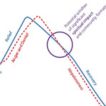
“Trauma is perhaps the greatest mission field of the 21st century.” —Diane Langberg, Suffering and the Heart of God
The word trauma has a variety of connotations in the West. However, much of the world does not have a word for it in their language, though they are not strangers to the concept and its effects. Trauma is “an emotional response to a stressful event or series of events that cause(s) a variety of negative consequences, including mental and emotional difficulties, and sometimes physical symptoms.”1 A single event or a series of events can have the same physical, emotional, and mental impact.
According to the Trauma Healing Institute, trauma creates a barrier between people and their understanding of the Gospel. The physiological impact of trauma can hinder a person’s physical ability to hear and understand the Gospel unless a way is made for them to understand. But listening to their story can open up a way for the Gospel to travel in. However, trauma psychologist Diane Langberg notes that if people have been living with ongoing trauma, they need community before they can tell their individual stories.2
A crisis or disaster, whether man-made or natural, shakes up people’s existing community or exposes their lack of community. A crisis also becomes a season where people hunger for community in ways they never have before. That hunger can be met at the deepest levels through healthy community. We define healthy community as small groups of ordinary disciples who love God, love others, and make disciples, pointing them to Jesus.
Many psychologists have observed3 that the majority of people who have experienced trauma do not need professional counseling but rather need a healthy community. Christian trauma-healing practitioners would say that community needs to be centered around God’s Word and listening well. Though professional counseling can help for a season, it does not replace the lifelong need for community, for which God created us.
Ironically, a crisis can harm community at the very time when community is most needed. From Bible times to the present, we have seen God at work during times of crisis in and through healthy community. For example, as the Muslim call to prayer sounded through the window last month, several ladies in the Middle East sat on the floor, sharing about communities that had been created during a past disaster response, and how, years later, the groups still continue to multiply. After beginning with trauma healing a few years ago, the discipleship groups are now spreading into surrounding countries. Their husbands, who are unbelievers and actively involved in Islamic leadership, have told them they will not allow their families to change locations because of the transformation they have seen in their wives as they participate in these healing communities.
How can we foster an environment of healthy community from the very moment a crisis occurs? Awareness of the average trauma-healing journey enables believers to more effectively love and disciple those impacted by trauma. As we disciple those impacted by trauma, they learn to walk alongside others who are hurting. Learning this skill also builds resilience in their own lives. Ultimately, this kind of discipleship plants emotionally healthy seeds in new disciples, ensuring that good things multiply (like healing) rather than bad things (like the effects of unresolved trauma).
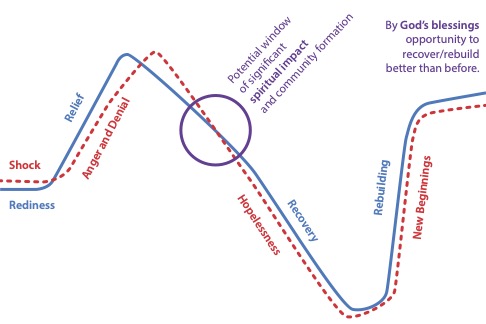
More information on application of this graph can be found in the P.R.E.P.A.R.E. article.
In the phase of acute or event-based disaster response, we can layer the average physical and emotional timelines with potential spiritual windows. Keep in mind that every person follows this sequence at their own pace. Timelines and rate of healing are often highly influenced by the existing community (or lack thereof), past trauma, and physical environment.
Physical relief often parallels the average timeline of the first emotional phase of anger and denial. As physical relief dissipates, emotional processing frequently shifts to hopelessness. Eventually, over time, people begin to rebuild both physically and emotionally. They experience “new beginnings.” As people impacted by disaster experience the overlap of these two timelines, we see perhaps one of the greatest windows God has given us to love and build community among people receptive to Bible stories, leading them to Jesus. This window occurs as people slide into the stage of hopelessness, as relief efforts wane and non-profits leave the site. If we reach people in this window and facilitate healthy community, the “new beginnings” they experience as they rebuild physically and emotionally tend to be stronger than even before the disaster.
As people slide into the stage of hopelessness, they crave the community we’ve described. If we, during that season, give them an opportunity to experience community that facilitates physical, emotional, and spiritual healing (in a context centered around God’s Word), we also have facilitated a contagious environment. We see this described in Acts 2:42–47, as disciples met together during the difficult circumstances of their lives. Their activities of helping each other physically, teaching, and fellowshipping together created a community to which each day the Lord added to their fellowship those who were being saved.
If we read Scripture through the lens of crisis and trauma,4 we note that in Acts 4, Peter and John experienced a crisis of getting thrown in jail. As soon as they were free, they went back to their community and shared their experience.
The community listened, was strengthened, and spoke God’s Word with boldness and love. We, as ordinary disciples and churches, can respond to crises as the Church in Acts did.
How do we facilitate the kind of community that responds well to crisis? By facilitating the essential foundations for any healing: community, faith, and purpose. These are needed in the journey of walking people through the stages of healing as outlined above.
The first step in healing is creating a loving and healthy community through listening. We can listen by asking three significant questions to help people process, either one-on-one or in small groups:
1. What happened?
2. How did you feel?
3. What was the hardest part? [or the best part?]
The second step in healing is establishing faith, based on a relationship with God and His Word. These same listening questions can be used to guide healthy lamenting with the Lord, sharing with Him, as the ultimate listener, the responses to the questions. We can then close with a statement of who God is in the midst, “I believe [or I want to believe] that you are [insert truth from Scripture].” Examples of lament in the Bible include Psalms 6, 22, 38, 44, 60, and 130. Stories from God’s Word provide the foundation for lament and learning. Because trauma impacts the brain in ways that make it difficult for people to interact with written text, oral stories, and activities centered on the truth and healing of God’s Word play a critical role in healing.
The third step, purpose, is foundational for creating a “contagious” environment. People find purpose when they understand that they also can share the healing and truth they have found through God’s Word.
As they experience healing through listening and loving each other (healing community), deepening their faith in God (faith), and intentionally sharing God’s Word with others (purpose), they form a strong, multiplying group. Such a group can sustain itself through the joys of “new beginnings,” and weather the next crisis that comes their way.
As the Middle Eastern women previously mentioned sat on the floor eating together, they reminded each other of the storms they had weathered together. One member of their group had died. Another woman’s family had experienced kidnapping in their home country. Another had experienced abuse. But the community remained strong. The women talked about how they had seen God’s grace and faithfulness through the way the community remained united through every hardship. This community, which began out of a momentary crisis, has remained strong three years later, consistently growing in number and in depth of relationship with Jesus.
These ladies remember well the vision of simple trauma-healing groups. Could we come to see things the way Joseph did, who said to those who had hurt him: Do not be afraid. You meant to harm me, but God used what has happened for good–not just for me–but so that many other people could be saved (from Gen. 50:20)?
Resources: www.GodinCrisis.vision/articles www.MultiplyingHope.org
This is an article from the November-December 2023 issue: Movements Accelerating through Crisis Response
November 01, 2023 by Compiled by Dr. Mary Roberts and Dr. Curtis Sergeant, with contributions from numerous local movement leaders across the globe.
50 Examples of Movements in Crisis Response
Compiled by Dr. Mary Roberts and Dr. Curtis Sergeant, with contributions from numerous local movement leaders across the globe.

Crises create opportunities for access, collaboration, creative problem-solving, and new initiatives. They provide opportunities to love people well in their deepest moments of need—by joining the Lord, who is close to the brokenhearted (Ps. 34:18), in the midst of the crisis.
Sometimes just hearing a few ideas can help someone get started. While engaging in crisis and disaster response as ordinary disciples and churches may be a daunting task, we can share many examples from Kingdom Movements. These span diverse experiences in loving God, loving people, and making disciples during the limited window of opportunity following a crisis. The Apostle Paul wrote to Titus, Our people must learn to devote themselves to doing what is good, in order to respond to urgent needs and not live unfruitful lives. As disciples and churches around the world have lived Titus 3:14, we can glean from these recent examples to kick-start the brainstorming of possibilities:
Wars and Conflicts
1. The Taliban conflicts in Afghanistan created the opportunity for a ministry serving Kingdom Movements to handle evacuation of nationals paid for by the U.S. government. That, in turn, allowed the ministry to evacuate believers in imminent danger and provided a deep level of access to many Afghans over time, resulting in many coming to faith.
2. Refugees in areas surrounding conflicts in Sudan were engaged through collaboration by a coalition of partners who would not have connected previously.
3. In an ongoing war in Sudan, the inability to have brick-and-mortar schools led to the creative development of an entirely oral-based seminary program. This paved the way for multiplication of mobile Bible storytellers, creating a growing edge for the multiplication of churches.
4. Conflicts in Myanmar led believers to find creative ways of getting supplies into high-risk areas. By working mostly underground, they were able to respond with physical, emotional, and spiritual care. After seeing the believers willing to take major risks to love people, many turned to Jesus, got baptized, and began to share with others.
5. War in Ukraine led to equipping disciples with awareness of what to watch out for in human trafficking, how to be prepared to leave as refugees, and use of preexisting sports networks to provide aid in Jesus’ name and see many thousands become disciples.
6. War in Ukraine created opportunities for believers to equip churches in surrounding countries to respond. They set up basecamps to receive the refugees, to care for them physically, emotionally, and spiritually. As refugees turned to Jesus, they multiplied new disciples while continuing their journey to find asylum.
7. Civil war in West Africa led believers to have open doors to share with “hard-soil” people, who became believers when faced with their own brokenness. Over time, a movement was launched out of the crisis.
8. Civil unrest in the Middle East created a bond between former persecutors and persecuted people from two neighboring people groups. Due to governmental conflicts, the underground churches multiplied quickly. Many of the same people who formerly opposed the believers and persecuted them became believers.
9. Terrorist attacks in the U.S. led to increased attention and prayer for the Middle East, which brought movement breakthroughs, such as had not been seen before. These movements continue to multiply to this day.
10. Refugees sharing about Jesus with their friends and relatives back home led practitioners to connect with existing movement leaders near the refugees’ home culture. They sent disciples to follow up with relational connections in the home country of the newly believing refugees. As the refugees shared with their families and nearby disciples within the country followed up, hundreds came to faith and were baptized, and disciples continued to multiply.
11. The scattering of North African refugees led believers to open doors to care in crisis. They formed migrating churches among the families of the refugees so the church would migrate together as the peoples moved around, multiplying as both harvest and harvest force were dispersed.
12. As disciples in Europe cared, physically and emotionally, for refugees from unreached peoples and places, the refugees eagerly asked spiritual questions. This led to Gospel conversations and discipleship breakthroughs.
13. Eritrean refugees in the Horn of Africa prompted believers to equip others in how to listen well to people, to care for their trauma. This led to new teams forming and equipping others in developing trauma healing that multiplied, producing new disciples and churches.
Earthquakes
14. An earthquake in Turkey created an opportunity for collaboration between some above-ground and underground workers, which in normal circumstances had been uncomfortable.
15. Earthquakes in Nepal led to the use of relief to bring reconciliation among persecuted believers as they brought help to those who had beaten and exiled them. Persecutors repented and the believers forgave, leading to multiplying churches during the recovery.
16. After earthquakes in Nepal, believers began to create go-bags to store on their roofs. Then, when the next disaster hit, they could get the go-bags with extra supplies after homes collapsed and help their families and others through the chaos and relief.
17. Large earthquakes in Southeast Asia led disciples to create a phased approach, seeing thousands in medical clinics and helping with immediate food, water, tents, and portable toilets. The team followed up with trauma-healing conversations and Discovery Bible Studies, leading to house fellowships of baptized believers in previously closed communities.
18. An earthquake in Indonesia created opportunities to form small groups. Each group helped others make bricks to rebuild their homes, using supplies and skills they shared as a group. Several of these groups clustered together to be coached by a professional construction worker. By working in groups, the supplies and supervision extended further than if each family had needed their own professional help.
Lockdowns and restrictions during the COVID-19 pandemic
19. Lockdowns in Myanmar moved more disciples to connect online using Zúme. This led to multiplying disciples and groups online while people could not leave their homes.
20. Limited market times led to an increased willingness of believers in Myanmar to exercise their priesthood in Christ and remove their own idols because other believers could not come to their homes due to the restrictions. They shared these testimonies in the markets as they went, leading many new believers to do the same.
21. Lockdowns in India led to believers discovering creative ways to distribute rupees for relief supplies in small portions, with trackable accountability. This led to breakthroughs, with several Kingdom Movements multiplying significantly.
22. Lockdowns globally led to many disciples learning and using previously resisted technology. This opened creative and catalytic ways to train, coach, and communicate, such as Zoom and WhatsApp. Zúme also increased by tens of thousands of users during the lockdowns. Believers used various technologies to advance movements, expanding relationships and launching new streams of multiplication worldwide.
23. Government restrictions led to connecting with others in new ways. For example, many pre-existing churches asked for training in house-church models, increased media ministry, and Bible studies accessible via phone.
|
Pandemic and epidemics
24. Aila, a leader stewarding a network of movements, testified: “I looked at what has happened in the last 15 years of our movement in East Africa, and 2020 was the peak,” as churches that met in buildings could no longer meet, so they met in homes and the groups in homes began to multiply.
25. COVID-19 response in Pakistan resulted in the opportunity to provide job training for indentured slaves, many of whom came to faith and began to labor for God’s kingdom.
26. During COVID-19 in Southeast Asia, movement leaders asked, “Not what can we do but what needs to be done?” While suffering, they worked toward their end vision by equipping believers in basic medical care and trauma healing. These opened doors to find households of peace that were searching for Jesus, leading to baptisms and multiplication.
27. An epidemic in North Africa led disciples to volunteer in hazardous places with many losing their lives to serve Muslims. A village chief watched the Christians love, to the point of giving up their lives, and prayed for God to spare his family. When this happened, he became a believer, sharing from the Scripture in mosques, and started churches, going from village to village after the crisis.
28. An Ebola outbreak in West Africa led to believers learning trauma response using movement principles. They took a strategic long view in their short-term response to the crisis. Discipleship groups then cared for people’s practical and emotional needs, leading to an even greater harvest in the long run.
Floods and tsunamis
29. Floods in India led to believers’ homes being relocated. As they started over, they shared with new neighbors, and the ministry multiplied through their relocation.
30. Flood response in Pakistan allowed for aid and access to people in poverty, who turned to Jesus as the source of their help in times of need. This Good News then spread to others.
31. Floods in Laos led to the use of motorcycles to access hard-to-reach places with food. This opened doors to care for people who had little access to supplies. Many became new believers, establishing simple churches among unreached peoples.
32. Floods after a drought in East Africa led to many leaders and families losing all their income. After prayer, they called one another to encourage each other and shared the very little they had. This led to a multiplication of sacrificial kindness towards one another.
33. A tsunami in Southeast Asia opened up places that had been entirely closed off to access. This answered prayers people had been praying for years and led to making new disciples and multiplying churches.
34. The same tsunami in Southeast Asia led to an outpouring of finances that were stewarded across relief, recovery, and rebuilding for several years to come. This will sustain catalysts who were led, through the response, to a long- term vision of disciples who make disciples.
35. Floods in Bangladesh led to chronic unemployment. This opened opportunities for microenterprise development, equipping believers to work as rickshaw drivers and allowing them to access people with the Gospel and provide income for their families. This enabled a movement in a large urban area to continue growing significantly.
Famines and food shortages
36. Famines in East Africa created opportunities for food relief and equipping people with sustainable farming. This led to groups working together, resulting in multiplying discipleship groups.
37. In Nepal, believers provided personal assistance in the fields to farmers having trouble during planting and harvest seasons. This opened those farmers to the Gospel and helped identify Persons of Peace, thus providing a foothold in resistant areas.
38. During food shortages in India, some disciples sacrificed one meal a day to give that food to someone in need. They then shared the food and asked people if they also wanted spiritual food. This catalyzed ministry among unengaged and unreached peoples to whom they previously had had no access.
39. After a locust swarm in East Africa, believers were encouraged by the reminder that crises create opportunities for the kingdom to advance. They shared food in portions that allowed for frequent follow-up to check on people. This demonstration of love shown in a difficult time opened people up to hear the Good News and led to increased fruitfulness.
Economic hardship and persecution
40. In many countries, economic hardship has made it challenging to take care of children. As a result, some disciples have engaged children with games that introduced kingdom principles to them and their families. This has often provided a foothold for kingdom multiplication in new communities.
41. Economic hardship and labor-avoidance issues have opened many opportunities for cross-cultural tentmakers to gain employment in unreached locations where they are called to catalyze Kingdom Movements. This has led to new movements on a large scale in regions such as the Middle East and China.
42. Extreme poverty, coupled with under-developed financial structures, has opened up opportunities for microenterprise development, ASCAs (Accumulating Savings and Credit Association), ROSCAs (Rotating Savings and Credit Association), and CHE (Community Health Education) in many nations around the world. The training aspects of these tools can be used in conjunction with Gospel truth and disciple-making tools and principles. These approaches have been particularly helpful in Africa, Bangladesh, and much of Southeast Asia.
43. In Pakistan, unemployed day laborers created opportunities to distribute food and the Gospel as they shared with the people around them. When people asked why they shared, when they had next to nothing, they shared about Jesus. As a result, the kingdom grew by hundreds of thousands of new disciples and churches.
44. Compassionate ministry among persecuted Muslim minorities in India resulted in many coming to faith and being equipped to multiply disciples. These disciples have continued to minister among other Muslims, and the community of Jesus’ followers has grown steadily.
45. When believing leaders were martyred in the Middle East, hundreds of disciples stepped up to take on leadership roles, fueling exponential movement growth in the wake of persecution unto death.
Other natural disasters
46. Mudslides in India led believers to work across movement networks to find creative solutions. They learned to build shelters faster and rebuild homes stronger, opening doors that previously had been closed to Gospel access.
47. Wildfires in Central Asia led ordinary believers to respond because they loved God and wanted to love others who were hurting. This led to new relationships and skills, building a crisis-response network in the movement that continues to grow after each disaster.
48. A plethora of natural disasters in Indonesia led believers to shift to a Luke 10 mindset in their disaster response. This enabled them to find Persons of Peace among unreached peoples. Walking alongside them through physical, emotional, and spiritual transitions brought multiplication at a faster rate than normal.
49. Cyclones in Southern Africa led to disciples from a nearby movement working with neighbors to rebuild homes out of compassion for those hit by the disaster. This led to new relationships and finding Persons of Peace, which resulted over time in a multiplication of disciples and churches.
50. A volcanic eruption in Central Africa spurred disciples to learn trauma-healing tools via WhatsApp. This enabled them to listen well to people as they arrived at relief camps. This, in turn, led to new networks of relationships and follow-up, forming discipleship groups that multiplied through the camps.
This is not an exhaustive list! To connect, communicate, and collaborate in strengthening Kingdom Movements in disaster and crisis response, please email [email protected].
This is an article from the November-December 2023 issue: Movements Accelerating through Crisis Response
November 01, 2023 by GREG H. PARSONS
Welcome to the Ralph D. Winter Research Center Website

The Ralph D. Winter Research Center has just launched a new website! Check it out at: rdwrc.wciu.edu. The website is specifically designed for two things:
First, we will be a source of current missiological reflection to serve both the newest globally interested believers, as well as mission leaders and engaged practitioners around the world.
We are working hard to find or create cutting-edge, frontier-focused reflections to advance the Gospel globally. We also are curating materials posted or published by others. We are excited to point to great resources deemed helpful for mission at the edges of the Gospel. We are encouraging others to write for our blog or post book briefs, or full book reviews. You can sign up at the website to be notified when we add new posts.
In the process of exploring and seeing how God is working today, we also want to:
Second, keep in sight the lessons the mission movement learned in the past.
One way the new website does this is through posting a range of ideas and reflections from key mission leaders in the past, such as those by Ralph D. Winter and Donald A. McGavran.
This is an outgrowth of my own experience. I was interested in missions and was helping mobilize at my church while in college back in the 1970s. I had a copy of Operation World from 1976 when it was only 208 pages (it is almost 1,000 now!). Later that year, I first heard Ralph Winter speak at a student mobilization event and I was shocked by the information he shared about peoples and places without any Gospel witness!
A few years later, after seminary, I joined the USCWM (now Frontier Ventures). That was 41 years ago. Until his death in 2009, Ralph was part of my daily routine. Most of us on staff saw, and usually heard from him, Monday through Friday in our Bible study and prayer times. When he asked me to become the Director in March 1990, my time with him increased.
But the thing that most staff remember were our weekly meetings, especially the ones each Thursday evening, when Winter would “wrap-up” after missionary speakers would share from a certain part of the world or a particular kind of ministry. His sharing usually did not last more than 10 minutes, but was very insightful. Over the coming months, we are planning on posting as many of those as we can. Right now, you can listen to one of those “wrap-ups,” an audio recording of Ralph’s now-famous plenary address from the Lausanne Congress in 1974 or a video recording of his reflections on Isaiah 49…just to mention a few.
Ralph carefully kept records of his writings, letters, events he attended, and organizations he was tracking. After his death, we found additional materials from the time he and Roberta served in Guatemala. This includes audio recordings from the 1960s. We also were given Donald A. McGavran’s library and the archives from later in his life.
In 2009, with all this information in hand, it was only natural to establish the Ralph D. Winter Research Center. It was started to encourage a creative approach to solving problems with the global spread of the whole Gospel. That was his focus.
The Research Center includes materials that illustrate and document the thinking that captured a generation of mission leaders. We are regularly adding digitized documents and audio and video recordings to the new website. We have a trea- sure trove of materials, including:
ï Ralph Winter’s archives (165 Bankers Boxes) and 8,500 volume library.
ï A portion of Donald A McGavran’s archives (58 Bankers Boxes) and library—about 2,000 books.1
ï A unique, focused South Asian collection (8,000 volumes) on Christianity and other faiths in that region.
ï A specialized missions collection (10,000 volumes).
ï Already, we have had researchers visit from the University of Notre Dame, Cambridge University, Southern Baptist Theological Seminary, and from India, Korea, and the U.S.
Ways you can get involved:
ï Visit the site at: rdwrc.wciu.edu
ï Sign up so you can download materials and engage in the discussion on new posts.
ï You can search all four book collections here: https://latourette.on.worldcat.org/discovery.
ï Researchers can come to see specific books and archives at the Research Center. Write to us through the website to see if your research focus is a fit for us.
ï Volunteer—in Pasadena or virtually. We have digital work that can be done anywhere.
Endnotes
The earlier McGavran materials are at the Wheaton College Archives.
This is an article from the November-December 2023 issue: Movements Accelerating through Crisis Response
November 01, 2023 by CAROL DAVIS
Rapid Response in Seasons of Receptivity

When a news flash interrupts your feed with the latest catastrophe, it’s not just information, it’s kingdom “intelligence.” Invisible to most, it’s God raising His voice for those paying attention. He’s pointing to a new front line—waiting for us to follow Him into the fourth-soil chaos.
On Christmas night in 2004, my young grandson Mike and I were on the way to our family Christmas celebration. Suddenly, the radio interrupted the Christmas music with news of the tsunami in Banda Aceh with potentially tens of thousands dead. I blurted out: “Something just shifted in the heavenlies,” to which Mike responded—“Huh?” Prayer for that region of the world had been intense—prayer that God would break down the spiritual resistance. God was answering our prayers for open hearts and access.
Compassion and aid flowed quickly from every corner of the earth, and rebuilding lasted for years. Questions linger as to how prepared Christ’s Church was to capture that season for more than the crisis-relief phase.
Since then, Lebanon has experienced a devastating explosion, Myanmar has seen ethnic cleansing, and the COVID-19 pandemic has killed millions. Ukraine has been invaded, an earthquake has destroyed Turkish towns, and tomorrow will bring a fresh calamity of some sort.
As we track human tragedies, most can be overlaid with a map showing where prayer and/or years of sowing have been focused on peoples in need of the Gospel. Unaware, they still wait in darkness for the Light.
RECEPTIVITY
When normal life for people and places has been suddenly and brutally disrupted, a high density of new receptivity usually arises—for a short season. Any event that forever alters a person’s future leaves them in immediate shock: traumatized, in a state of disequilibrium, and often short of personal agency to bring stability to the coming days, weeks, months, and sometimes, years. In the new season, victims face fresh vulnerabilities to hunger, weather, abuse, violence, corruption, and/or injustice. While they process their forever-loss of friends and family, jobs, homes, and way of life, they often are severed from their physical and emotional anchors, and they experience aloneness like never before.
For some, their religious belief systems are shattered, and they find formerly rock-solid answers insufficient for the new questions and circumstances. They become open to re-processing their life, its meaning, and their future.
SEASONS
Seasons of receptivity do not last long. They can come for a few moments or last a few months, until something or someone fills the vacuum. This is especially true regarding the limited window of receptivity at the heart level. In this state of disequilibrium, sufferers feel driven to find answers and stability as quickly as possible. It is both a brain and a heart issue. Humans need cognitive closure to the new questions and their heart aches for a return to peace. They become receptive, not just to the Gospel but to anything or anyone that will quickly fill the void. For cognitive closure, wrong answers can be tolerated better than the vacuum they experience.
We know that the best filler of that vacuum is the Lord, who longs to be with them in their suffering and speak to their pain. At a gathering in Lebanon during the Syrian crisis in 2018, Miriam Adeney helped answer the question: “Where is God in the Crisis? Making Sense of Crisis and Suffering.” Among other things, she reminded us that:
a) Humans are more than sinners; we are created in the image of God. We are never just sinners or even victims. In God’s image we are gifted, resilient, and creative.
b) God enters our/their pain. A wounded God can speak to our/their pain.
RAPID RESPONSE WITH SENSITIVE HEARTS
That is why we must quickly be about our Father’s business. From a kingdom perspective, it seems to make sense that the crisis and disruption of others would challenge us to consider disrupting our own lives as we follow our Savior. The good Samaritan comes to mind. In urgent seasons, we need to be open to adjust our budget and calendar—even our policies and processes—in light of the sudden arrival of short-lived, high-density receptivity that we’ve prayed for. There is no time for business as usual when the harvest is fully ripe.
When the epicenter of the Arab Spring demonstrations landed in Syria, it displaced more than half her citizens, both internally and to many nations in Europe. In the midst of that turmoil, many ordinary European believers responded quickly and powerfully to the flood of refugees. They rearranged their lives to rapidly respond, bringing practical aid, healing, hope, and the Gospel. We now know of movements to Christ among some of those who fled war and tyranny in that season.
Katy was one of the go-ers. She had no special mission credentials—but she had her church behind her, and she had ears to listen and a story to tell. One afternoon, Katy glanced at something—a someone. The glance became a gaze because something was not right. Under a shady tree on a green hillside, in an almost deserted park, on a hot summer afternoon in Frankfurt, Germany, sat a distraught woman, all alone. She was across the street from a refugee intake center where new refugees were processed. Katy felt prompted to talk with this obviously displaced woman, even though she felt terrified, not knowing what to say. What she heard coming out of her mouth in English was, “I want to hear your story.”
It didn’t take long before the two pain-filled eyes met a stranger’s two eyes—and sensed compassion. Nadira was a recent arrival. She had started running the night ISIS fighters broke into the apartment where she lived with her brother, demanding money they didn’t have. Angry, they beheaded her brother in front of her. Soon they pulled her newborn twins from her arms and threw them out the window to their death below. “I started running, because that’s all I had had—my brother and my babies.”
Katy and Nadira wept together. Slowly, Katy was able to share that just months before, she also had lost a child, though not as tragically. In her case, it was a miscarriage that led to the most painful experience of her life. She shared a story of where and how she had found hope to move forward with Jesus. As Katy shared, Nadira sobbed. Katy asked if she could give her a hug. Nadira immediately grabbed her and held her—long and tight. Katy says she will never, as long as she lives, forget that hug.
The two strangers shared their human condition, including indescribable pain and increased hope. Because of the pain, although in differing degrees, each had something to give as well as receive. A glance. A gaze. A step. A story. A connection. A hug. A knowing. And HOPE!
POSITIONING FOR ACTION
Might we adopt the athletic, army, and agricultural model of 2 Timothy 2:4-6? Those holding each of these jobs prepare themselves long before the game, the battle, or the harvest. Then, at the right time, they rapidly deploy to the stadium, the front lines, and the ripe fields.
In human crises, early response usually includes medical and trauma healers; specialists in search, rescue, and logistics; compassionate listeners; and connectors. Christians also add intercessors, evangelists, and those apostolically gifted. Many agencies specialize, but Church communities around the world constitute a large latent workforce with the specialties needed, just waiting for activation into the chaos. And any believer going in the power and authority of
Christ our Lord can be used. To get ready, here’s what I recommend:
1. Position now for the fourth-soil seasons—at home and abroad.
ï Activate prayer teams to intercede, prophetic see-ers to spot, early on, God’s openings, and mobilizers to mobilize other mobilizers throughout your church community.
ï Identify all possible assets—visible and invisible.
◊ Visible are the specialists already equipped, funds already designated, current partners and language capability you know about, etc.
◊ Invisible are the resources you will need to discover among your people and within their connections. Go find the hidden treasure. Look for distinctive life experiences and unique connections. Encourage additional equipping opportunities in skills like trauma healing, search and rescue, crisis logistics, intercession, setting up refugee resettlement centers, meal stations, children’s programs, appropriate cultural engagement, cross- cultural listening skills, and peace-making (often needing application within the team itself in the midst of battle).
2. Run interference when necessary. Make sure your systems and processes do not unnecessarily block your kingdom-advancer types from running quickly to the fourth-soil places and spaces.
3. When the news flashes come:
ï Listen for the “kingdom intelligence” behind the details. Ask the Lord what He has in mind and explore the kingdom possibilities now that could not have been conceived of a few hours ago.
ï Then, respond with the speed worthy of our King, who at that very moment will be opening hearts in the chaos to be with Him forever.
This is an article from the November-December 2023 issue: Movements Accelerating through Crisis Response
November 01, 2023 by NATHAN SHANK
Displaced and Redeemed: The Story of God’s People According to Stephen

“… you reside in my land as foreigners and strangers.” (Leviticus 25:23)
Unless otherwise noted, all Scripture references in this article are from the NIV version.
How would you describe Stephen in the book of Acts? As a servant waiting on tables (Acts 6:3–6)? As an evangelist preaching to those responsible for Jesus’ crucifixion (Acts 7:2–53)? Or (perhaps the most vivid picture) as a martyr seeing a vision of the glorified Christ (Acts 7:54-60)?
In this article, we will consider Stephen the historian.
Did you know that Stephen’s speech constitutes the longest monologue in the book of Acts? Acts 7 is certainly apologetic. In fact, Stephen’s account of Israel’s history hit so close to home for its audience they chose to execute him.
Stephen’s summary is simultaneously the history of redemption and that of a displaced people. Stephen begins in Mesopotamia (Acts 7:2) and proceeds through God’s calling from the land of the Chaldeans via Harran to the vision for a promised land for Abram. Yet, the Lord gave him no inheritance there, not even enough ground to set his foot (Acts 7:5). Even while having neither land nor heir, Abram was somehow comforted by God’s promise, For four hundred years your descendants will be strangers in a country not their own, they will be enslaved and mistreated (Acts 7:6). Besides a promised land, God led Abram to accept the promise of slavery and suffering.
In the story of redemption, we don’t assume opposition came from outside. It was the “patriarchs” of Israel who sold Joseph into slavery (Acts 7:9). Because God was with Joseph, opposition resulted in deliverance. As famine drove the sons of Israel to Egypt, Joseph was ready as God’s provision (Acts 7:8–16). As we read from Joseph’s own lips, the evil intended by Joseph’s brothers God intended for good to accomplish…the saving of many lives (Gen. 50:20).
For many generations Israel multiplied; so did the Pharaohs' oppression. Stephen used words like “treacherous,” “oppression,” and “forced labor” to describe the plight of God’s people (Acts 7:7–19). In all this, God was not absent. He told Moses, I have indeed seen the oppression of my people in Egypt. I have heard their groaning and have come down to set them free (Acts 7:34). Yet the mighty deeds God enabled Moses to perform were accompanied by 40 years of wandering in a wilderness (Acts 7:36). Israel was homeless, aimless, rebellious, yet guided by the “living words” received by Moses and passed to the people (Acts 7:38–39).
Even though Israel settled in the promised land, Stephen reminds those who inherited the tabernacle and the temple system, the Most High does not live in houses made by human hands. For Heaven is my throne, and the earth my footstool. Though God’s own hand had made all these things, the Holy Spirit led Stephen to rebuke those clinging to a house prepared for God. Like Joseph, the prophets, even the law of Moses, the Righteous One was rejected and betrayed (Acts 7:48–53).
Israel possessed the promises of God, yet they were often treated as strangers and foreigners. Israel’s history was marked by oppression, slavery, and groaning. They were “resident aliens” displaced by famine and warfare. According to Stephen, each generation played its part—whether Jacob digging another well, un-named Israelites baking bricks made with or without straw, or Moses stretching his staff over the Red Sea. Each generation, willingly or unwillingly, had a role in accomplishing God’s purposes within His mission. And throughout its history, Israel was plagued by rebellion from within the camp. At the appointed time, Israel mistook the redemption wrought by God’s own hand.
They crucified the very Redeemer sent to fulfill the promises of God.
As you read Stephen’s account of Israel’s history, are you struck by the intense irony?
Having recounted the history of his own people—displaced, mistreated, sold, and even murdered—Stephen took his place among the oppressed and the redeemed. Full of the Holy Spirit, Stephen fell beneath the stones hurled at him. Yet as he looked to heaven, he saw his Savior standing at the right hand of God (Acts 7:55–60).
You know what happens in the following chapters of Acts. God’s purposes are revealed again and again amidst suffering and injustice. Saul the persecutor, after approving the murder of Stephen, becomes the catalyst for a scattering of the disciples (Acts 8:1–3). As Saul sought to destroy the Church house to house…those who had been scattered preached the word wherever they went (Acts 8:3–4). God’s orchestration was again demonstrated as men from Cyprus and Cyrene, went to Antioch and began to speak to Greeks also, telling them the Good News about the Lord Jesus. The Lord’s hand was with them, and a great number of people believed and turned to the Lord (Acts Acts 11:20– 21). Within the providence of God, both Stephen’s suffering and Saul’s evil intent served to establish the very Church which later sent the same Saul on mission (Acts 13:1–4). Do you see irony? I see God’s purposes made perfect in the faith of His followers across history.
According to Stephen, the story of Israel is the story of pilgrimage. Stephen’s speech is the story of God choosing and leveraging Israel for redemption. This history is a pathway of suffering, oppression, and groaning (Acts 7:34). Yet, such circumstances are perfectly in step with God’s providence and promises. In the midst of mission, one might anticipate a reward for leaving everything to follow the Lord’s calling. Yet, the biblical precedent remains. We should not be surprised that injustice and the mistreatment of God’s people continue today. We should not be surprised by the stirring and displacement of nations in keeping with the plan of redemption. Even now, such circumstances propel the Great Commission to the ends of the earth.
As it was with the story of redemption, so it is in the ongoing unfolding drama of the Great Commission. We have the promised Spirit of God, complete with His power compelling us to witness. As we accept and embrace the promises of Acts 1:8, let us be prepared to accept the precedent of scattering established in Acts 8:1.
This is an article from the November-December 2023 issue: Movements Accelerating through Crisis Response
November 01, 2023 by LAUNCH LAB
RALPH D WINTER LAUNCH LAB
A Catalyst for Mission Innovation

What’s In a Name?
Despite what its name may suggest, the Winter Launch Lab (WLL) is not a center for win- ter sports. Named in honor of Dr. Ralph D. Winter, this dynamic team operates within Frontier Ventures and serves as a dedicated laboratory for mission innovation.
Who We Are
Comprised of a diverse group of innovators, each member contributes their own specialized expertise towards a singular goal: bringing the Gospel to the least-reached communities around the world. The WLL unites people with varying backgrounds and passions, allowing for a broad spectrum of innovation that can’t be found elsewhere.
Our Areas of Focus
Our projects range widely but are deeply rooted in the concept of frontier missions. Key areas include:
· Health: Catalyzing solutions to complex global health challenges where they’re most needed.
· Bitcoin in Missions: Exploring how cryptocurrency can serve global missions.
· The Spirituality of Innovation: Understanding how innovation and innovators intersect with Jesus-following communities, spiritual life, and spiritual practices.
· Nomadic Outreach: Developing approaches to share the Gospel with mobile and isolated communities.
· Midwifery: Uniting frontline midwifery workers in the art and science of midwifery.
· Entrepreneurial Businesses: Supporting business startups in regions where Frontier Peoples (sometimes called UUPGs and FPGs) are to sustain long-term outreach as well as being successful midsize businesses.
How We Help Others
The WLL doesn’t just innovate in-house; we provide several platforms to assist other mission workers, agencies, and networks in overcoming their challenges:
1. Unstuck Peer Consultation: This service is aimed at providing new perspectives to tackle leadership and mission-related is- sues, helping participants feel “unstuck.”
2. Jumpstart Workshops: These sessions help teams define challenges, encourage prayerful reflection, and design fresh strategies for impact.
3. Transformational Collaborative: This is a longer-term commitment, typically 1-3 years, focused on using innovation and spiritual discernment to break through significant barriers to the Gospel. Participants find themselves, as well as their ministry paradigms, transformed through this intensive process.
Our Community
Our core team collaborates with an extensive network of partners, expanding our reach and impact. This network brings our total team size to around 40 people, all of whom share the conviction that more indi- viduals and groups should be involved in this vital work.
The Unique Spirit of the WLL
The need to deliver the whole Gospel to the whole world isn’t just a chal- lenge—it’s a sacred calling. And it’s one we approach with relentless dedication and joy. We deeply value your prayers as we continue to press forward in this exhilarating, and at times challenging, landscape of global missions.
If you’re interested in mission innovation, the WLL stands as a strong, creative and strategic team. It’s not just an exciting place to work; it’s a transformative community to be part of.
This is an article from the November-December 2023 issue: Movements Accelerating through Crisis Response
November 01, 2023 by DR. MARY ROBERTS
P.R.E.P.A.R.E. to Respond to Crisis

“What we do is not because there is a need, but because there is a God.”
—Dr. Alicia Britt Chole
When walking the streets after disasters in several nations, including my own, I often asked people: “Was there a time when you cried out to God?” Time and time again, they would say “Yes.” In their darkest, scariest moments, people are often shaken to realize there may be more to life than what they have been living. When we share stories about God and the Gospel, it answers their desperate prayers with Good News—from the God to whom their inmost being had cried out.
How can we position ourselves to be ready for the opportunities God gives us? How can we join Him in caring for people through the phases of disaster response, for the long-term advancement of His kingdom through multiplying disciples and churches who transform communities?
One way is to P.R.E.P.A.R.E. to recover God’s designs out of disasters: knowing Him, making Him known, and living by kingdom principles according to Scripture. Whether our focus is across an ocean or across the street, we can prepare locally, regionally, and/or globally to increase effectiveness to be able to love others well in Jesus’ name.
Posture | Research | Equipping | Processes |
Assessment | Response |
Establishing multiplying disciples & churches
Walking through Scriptures, stories, and scenarios as we P.R.E.P.A.R.E. can make a significant difference. It may be as simple as changing the questions we ask, as phases, information, and circumstances change. From micro (individual) to macro (network) levels, it is important to get the basics in place in order to lead to the long-term vision of movement efforts. Caring for an individual experiencing a crisis is then multiplied to caring for entire communities, nations, and regions experiencing crises. While large-scale responses contain added dynamics of complexities, the same basics exist at the smallest fractal level.
We must be led by Scripture and the Spirit, not the demands of urgent needs or the deception of feeling better if we help just one more person. Scriptures sustain us through suffering when strategies or stories alone fall short. Our response to suffering should be formed before we experience it, in order to effectively see and join God in crisis. Action is crucial, but so also is heart response, and the way we do what we do.
One of the greatest gifts we can bring to those suffering and afflicted is a sense of, “Peace, be still.” Into the pain of those searching desperately, we have the privilege of offering the peace that only Jesus can bring—while we do whatever we do.
What if we read Scripture through the lens of crisis and disaster? God consistently transforms the most destructive moments into the most redemptive stories. In the New Testament, the movement of God thrived in the context of multiple crises, such as persecution (Acts 8:1), famines (Acts 11:28-30), urgent needs (Titus 3:14), death (Luke 8:49-56), sickness (Luke 8:43-48), riots (2 Cor. 6:4-5), and storms (Luke 8:22-25). The accounts of responses to disasters and crises were written to all the followers of Jesus. Still today, engaging in trauma healing and spiritual receptivity with reproducible tools is transferable across all cultures at the baseline level.
P.R.E.P.A.R.E
Posture—How can you build a scriptural foundation to stand on in the face of suffering? What Scriptures do you need to write on your mind and engrave in your heart, to have on your lips in the midst of a crisis (Deut. 11:18-19)?
Research—What types of disasters is your area vulnerable to? What skills and resources do the disciples, churches, and communities around you have? What supplies and skills do you all need to develop?
Equipping—What are the trauma-healing and physical-response skills that can be multiplied alongside the spiritual tools? In what ways can you equip small groups of people to hear, obey, and pass on these tools—for their own resilience and strengthening one another?
Processes—From individual to network-wide, what principles will shape how groups of disciples and churches will make decisions? Communicate? Problem-solve? What processes can you put in place ahead of time?
Assessment—What are a few simple questions that can help people assess the surrounding physical, emotional, and spiritual states? In what ways can continuous (formal and informal) assessment help?
Response—In what ways can ordinary people in churches join God at work in each phase of disaster response: readiness, relief, recovery, and rebuilding? How can you connect, communicate, and collaborate with various professional skills and resources, with the main resource being ordinary people?
Establishing multiplying disciples & churches What will be your plan to respond rapidly with a long-term vision? How will the disciples and churches sustain the response through the four phases?
What could your families of disciples and churches put into action and pass on to others to P.R.E.P.A.R.E.?
If you read the P.R.E.P.A.R.E. template with “you” as singular, go back through and read with “you” in the plural form: “we.” How does it change your response?
Understanding the response phases is foundational to any strategic-planning and decision-making processes. The more you can access real-time information on the ground, asking questions appropriate to the phases, the more helpful your response efforts can be.

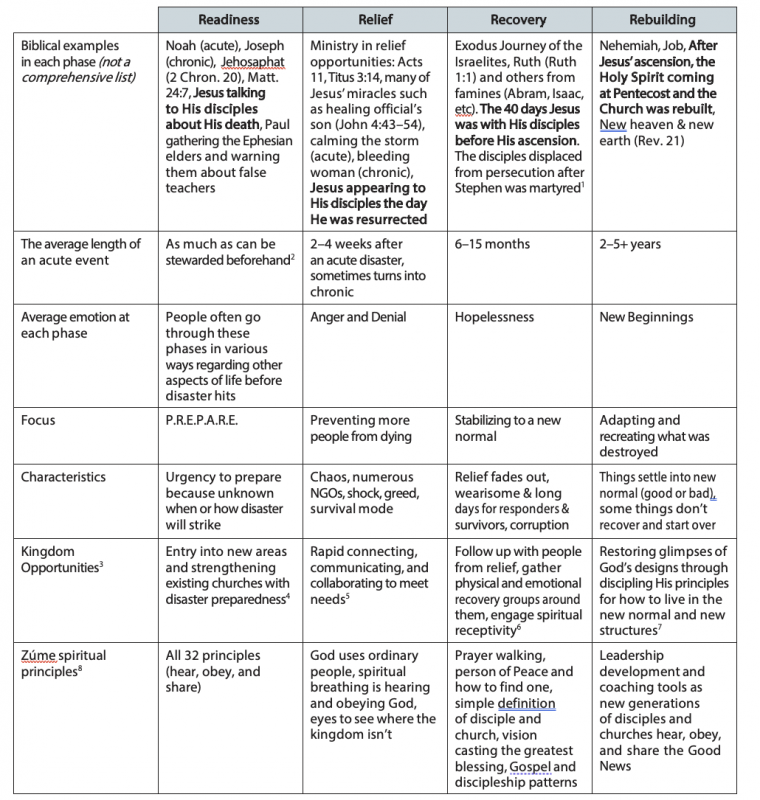
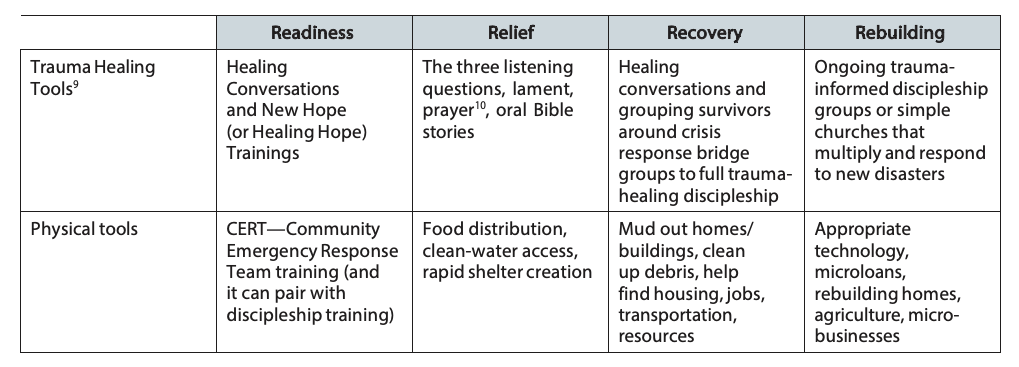
More resources, including examples of P.R.E.P.A.R.E., can be found at: www.GodinCrisis.vision
To learn how to partner with Kingdom Movements serving in crisis/disasters, you can write to [email protected]
Endnotes
See “Displaced and Redeemed” on page 24.
See “Insights from Movements for Effective Crisis Response” on page 16.
See “Movements Responding to Crises” on page 8.
See “APEST: Roles for Equipping Everyone in Disaster Response” on page 29.
See “50 Examples of Movements in Crisis Response” on page 32.
See “Rapid Response in Seasons of Receptivity” on page 13.
See “Organizations Shifting: Crisis Response and Movements” on page 21.
See “When Crisis Rings: Digital Strategies Using Zúme” on page 38.
See “Trauma Healing in Crisis Response” on page 18.
See “Partnering with God: Prayer as a Crisis Response” on page 26.
This is an article from the November-December 2023 issue: Movements Accelerating through Crisis Response
November 01, 2023 by CYNTHIA ANDERSON
Disciple-making Skills Without Mindset Shifts Won’t Produce Lasting Fruit

Simon Sinek, motivational speaker and thought leader, is famous for coining the phrase “Start with why.” Indeed, our why is extremely important as we seek to expand God’s kingdom across the globe. Motivation comes before processes and methods. Agreed? As I look at Scripture, however, I see Jesus starting not with why, but with who. Who He is and who we are.
I am the vine, you are the branches. Abide in me and you will bear much fruit, Jesus said in John 15. He starts with identity. Who we are. He then tells us what to do. Finally, He shares a promised outcome. John 15:5 is perhaps one of the most important verses in the Bible for any missionary, church-planter, disciple-maker, or DMM/CPM practitioner to regularly reflect on.
We want to see greater fruit. We long for multiplication. It begins with who.
Start with Identity before Activity
A few weeks ago, I was reviewing some online training material created by another organization. I have a lot of respect for this group. They have done a great job of catalyzing many new movements and training people to multiply disciples. As I watched their videos, I deeply appreciated many things about their training content. I recognized numerous principles that I’ve also used to train disciple-makers.
One thing was notably missing, however. The who. They challenged people with the need to plant Gospel seeds and gather new people into groups. They talked about training leaders. But they started with the why and what and completely skipped the issue of who.
“Hmm.” I thought to myself. “If people don’t first know who they are, I’m not sure how fruitful this will be.”
It is common to skip the who and jump straight to the why or the what of making and multiplying disciples. Jesus spoke a lot about the who. He reshaped the identity of His followers. As they understood and began to believe who they were, and then spent time with Him, watching Him express who He was through what He did, they were transformed. Soon, they were acting like Him and doing the works of the kingdom.
Here are a few examples of times the Bible speaks to a disciple’s identity.
· Chosen & Appointed to Be Fruitful—You did not choose me, but I chose you and appointed you so that you might go and bear fruit—fruit that will last… (John 15:16)
· An Extension of Jesus—I am the vine, you are the branches. (John 15:5)
· Royal Priests—But you are a chosen people, a royal priesthood, a holy nation, God’s special possession. (1 Pet. 2:9)
· Children of God—See what great love the Father has lavished on us, that we should be called children of God! And that is what we are! (1 John 3:1)
When we are training people to multiply disciples, it is good to teach them new skills and to challenge them with the Great Commission. No debate there!
If we want to see lasting change and transformation, however, there are a few important steps we need to take before jumping into skills and methodology. The trainee’s thinking needs to change about who God is and who they are.
In my new book, The Multiplier’s Mindset: Thinking Differently About Discipleship (released September 7th on Amazon.com) the first part of the book addresses mindset shifts about God and ourselves. We start with who. Throughout the book, the thread of identity surfaces often. This is because, without significant mindset shifts about our identity, multiplication may begin, but it will not be sustained.
Change Mindsets to See Changed Behavior
Have you ever trained a group of people and seen great enthusiasm at first, but the lasting impact seems minimal? I love just-in-time training and believe it is a key to catalyzing movements. We train people in skills they need now, then send them out to practice. This is fruitful. Much missionary training is too knowledge-based and has little skill training. We need to train people not only what to do but show them how to do it.
Having said this, if we train only in skills but don’t address mindset shifts, we still won’t see lasting results. Why is that? It is because our actions flow out of our beliefs. If our core beliefs about discipleship remain unchanged, even with skill training, we will continually default to old behaviors.
Let me give an example to illustrate.
Imagine you are training a group of people on how to share their testimony in three minutes. They learn the skill, practice it in the classroom, and even do fairly well with it when you send them out to share with people in the community. As long as you are there as the trainer and mentor, they are obedient learners. Everyone gets excited about the initial results.
A few weeks later, however, none of them have continued to share their testimony with others. What started out looking like a blazing fire that promised to bring much fruit has dwindled to a mere ember. The core reason could be the lack of a mindset shift regarding either openness (the harvest is ripe), or regarding enough (they don’t think they have the resources needed to share the Gospel). Without you there to help them, provide inspiration, and perhaps transportation costs to go out to a new location to share, they discontinue their efforts. Their core belief is that they need outside assistance to continue and that they don’t have enough money, people, training, or time to do what you’ve trained them in.
After years of working with thousands of DMM/CPM practitioners, I’ve come to firmly believe that alongside of skill development (which is very important), we also must work on mindset shifts related to core multiplication values and principles in Scripture. Once our thinking becomes aligned with God’s Word, actions become natural and automatic.
Let me unpack this a bit further. Return to consider the mindset I call “Open.” If we believe that Tibetan Buddhists are closed to the Gospel, no matter how many skills we learn about how to have spiritual conversations, share testimony, or do Bible storying, we won’t share frequently with new people. Why? We believe they are not open to hearing our message.
I see the same thing taking place in the West. We assume that people around us don’t want to hear about Jesus and will resist our attempts to engage in conversation related to our walk with Christ. There may be people around us who are open and even hungry to know more about Jesus, but we do not open our mouths to share because our core belief is that they are not open. Our thinking must be realigned with God’s Word and what Jesus said about the harvest being ripe. Only then, will we begin to share and share often with those around us, no matter how many skills we have learned or read about.
Keep Injecting Vision for the Transformation of Individuals and Communities
Another missing element in our efforts is the continual injection of vision into those we are training. Again, we so often focus on the what and how, but together with the who, we must continue to regularly remind people of the why. Cast a vision for what will happen one day if we are faithful to make disciples and train them to make more disciples. Talk about that dream often. Pray for it. Gossip about it. Imagine together what it will be like when it comes to pass.
My husband and I are training for a half marathon. The coach on the runner’s app we use often tells us to imagine ourselves crossing the finish line. What will it look like? Will we high-five each other? Will we do a dance? Lift our hands in the air? Imagining the finish line helps us keep running today. Keeping the vision in front of us gives the courage to persevere through the tough moments on the journey to the release of a rapidly multiplying movement.
Hebrews 12:2 says, for the joy set before Him, He endured the cross, disregarding its shame. It was the vision of the future, of the joy before Him, that helped our Lord endure and press on through suffering. Those we disciple need help to do the same. Remind them continually of the joy that lies before them.
What will it be like when you see Jesus, face to face? When He says to you, “Well done my good and faithful servant. You invested what I gave you. You were faithful. You obeyed my Word.”
· What will it be like when you are in heaven and you look around and there are thousands with you from the tribe and people you devoted your life to reach?
· What will it be like when one day tens of thousands of Jesus followers have joined together to pray for their nation? When instead of corruption and violence, godly men and women are honoring God and serving their communities with truth and integrity? This is why we continue to serve and to do the hard and messy work of making disciples.
Look for ways to remind people of their why and to cast a vision for the transformation of individuals and communities.
This issue of Mission Frontiers is about crisis response in fostering movements. God works through times of crisis and often releases new wine and new wineskins. When a crisis is happening in our lives or our nation, we are more open to changing our mindsets and beliefs. The crisis demands it. It forces us to consider new ways of working and new ways of thinking about our work. We are forced to change and innovate.
When the crisis subsides, it is easy to shift back to old methods and means. We see this with the pandemic. Many churches were unable to meet in buildings or sanctuaries. The church became a church without walls. People met in small groups or online. A major pivot took place for many. After the pandemic, have we retained the lessons learned or continued to utilize the new wineskins? The pull to return to the old is strong within us, especially if only our methods changed but our mindsets remained the same.
Identity and beliefs must change to release and sustain movements.
Interested to consider these mindsets further? I’d love to share a copy of my new book with you. Grab a copy at www. multipliersmindset.com today, or download a free sample chapter at www.dmmsfrontiermissions.com/multipliers- mindset-sample-chapter.
God has great things ahead for us as we continue to allow His Spirit to shift our thinking. Our identity in Christ comes into alignment and then our actions and outcomes will shift as well.
This is an article from the November-December 2023 issue: Movements Accelerating through Crisis Response
November 01, 2023 by Dr. Trevor Larsen and the Focus on the Fruit Team
Movement Leadership in Crises: Applying Principles from Great by Choice

“10Xers distinguish themselves by an ability to recognize defining moments that call for disrupting their plans, changing the focus of their intensity, and/or rearranging their agenda, because of opportunity or peril, or both.”
― James C. Collins, Author of Great By Choice—
Written for leaders of leaders, Great By Choice by Jim Collins is perhaps one of the strongest books on leadership that can be applied to the subfield of leading change needed after disasters. The book puts forward the question: “During turmoil and change, how do an organization’s leaders help them survive and thrive?” Using the illustration of two teams racing to the South Pole, one team did better in really harsh conditions with turbulent times, where uncertainty was permanent and chaos was normal. Change was accelerating and instability characterized the area for quite some time, yet the team thrived. In similar contexts, how do we develop kingdom movement leadership so we thrive with the greatest gains possible for God’s kingdom—in the midst of uncertainty, chaos, and change, as consistently experienced in post-disaster areas?
After researching numerous companies that were 10 times more effective than their competitors, Collins defines five main principles:
1. Fanatical Discipline
2. Empirical Creativity
3. Productive Paranoia
4. Consistent Operating Principles
5. Harnessing Returns on Luck (which we would describe as divinely orchestrated moments)
Leaders who excelled 10 times beyond their peers were more disciplined in preparing for crises and changed less in reaction to the changing world experienced within a crisis. It was not merely a matter of the response, but rather the kind of leadership set up beforehand. Principle-based discipline allows a team or organization to go into an area where they don’t yet have work going, while it’s still in turmoil, then apply the same consistent principles that were already in place, and find good results. This is often missed in crisis or leadership articles, yet these principles and illustrations have deeply shaped the kingdom movement God has entrusted us to steward.
Fanatical discipline involves doing what is needed during down times and resisting the temptation to grow wildly during good times. Measurable growth can occur after crises, but it comes through doing the same disciplined things. The practice of discipline involves focusing on performance markers or milestones that show the way through self-imposed principles, or boundaries, that constrain us in good times to do the things that are best to do. For example, within our kingdom movements, a couple of our chosen boundaries in budgets include avoiding one-off gifts for ‘special’ projects that may pull us away from good leadership principles, and not accepting more than 16% from a single funding source, to avoid being put into crisis mode should a funding source diminish. We keep our focus on targeting what we have some ability to control, within intermediate timeframes of one to two years. We can predict that crises will occur at some point without having to jump to do anything wildly different.
Collins illustrates empirical creativity through the concept of firing bullets and then cannonballs. When two ships were in a war in the 1800s, they would first fire a bullet to calibrate their trajectory, range, and target before firing the costly cannon balls. In our kingdom movement application, our equivalent to firing bullets is facilitating creative experiments that are low in cost, time, risk, and distraction. We tell our leaders these criteria as we fund their low-cost experiments for a three-month period. They must provide a good rationale for their hypothesis and a plan for how they will pursue the outcomes, then report on the positives and negatives after the trial period. If they decide to continue for another three months, they must revise their plan based on what they learned in the first quarter. This can increase effectiveness for the next round of effort, after which we assess again, and then potentially invest more money, priority, and risk. Creative problem solving is very, very important in crises, but problem solving is more effective when built into leadership before, as well as during, crises.
Acting with productive paranoia to avoid the death line, the team that succeeded in the march to the South Pole had put buffers in place, with resources stocked at different mile markers – to get back to them if they had trouble. In our work, we try to have large amounts of cash buffers funded from within the kingdom movement. In a recent Zoom call, we had four people on the run from persecution, who had to be relocated to other islands and needed start-up money for new businesses. We need these kinds of resources and buffers in place in our kind of ministry, which is subject to many difficulties from evil people and the unseen demonic realm. Dark forces are unleashed as we break into unreached peoples and places that previously had no light in the darkness. This huge spiritual battle requires buffers, anticipating that bad things will inevitably happen.
However, we do frequent evaluations and make changes needed every quarter instead of waiting for the death indicators that have caused large organizations to fall, because they waited too long to make changes. During COVID-19, we had 3,000 leaders die and thousands lose their income. While we have tried several interventions, we are still experimenting to see what we can influence in the recovery. Shifting from being an entrepreneur startup to leading a movement of many thousands to thrive long-term, is a very difficult change. Making that shift requires a lot of leaders in coaching circles doing problem-solving to help reduce obstacles and turn them into opportunities.
Collins explores the fourth principle – consistent operating principles – with the example of Southwest Airlines. They have all the same airplanes and therefore all the same parts. They have simplified processes, such as a boarding procedure consisting of three groups without seat assignments. This reduces the hassle and work required for profit, while people get what they want for the money they want to spend.
In our kingdom movement, we have a standard operating principle of 30/3. When believers move to different areas and start new groups, the leaders can go visit when the group grows to 30 believers and three generations. They mentor online until the 30/3 mark and then don’t need permission to spend the money to visit because they know they can go, in accordance with the decentralized power structure. Our operating principles give a network of leaders’ teams a framework for making their decisions.
In similar ways, leaders from the kingdom movement know they have strategically planned for crises in their budget, with principles that anchor their actions in the core values. Collins describes the importance of specific, measurable, and consistent operations leading to the expectation of standard operating principles. We expect that a new endeavor, such as disaster response, needs to have a time frame, funding plan, initial phase plan, reassessment after the phase, and outcomes that are clear, even if revised after phase one.
Also, we only discuss the budget once a year so it doesn’t dominate relationships but rather includes lower-level leaders in a deep dive. We see this as consistent with the New Testament, which describes a plurality of leaders from the earliest points. Quick decisions made by higher-level leaders tend to centralize power, whereas movements seek to distribute and decentralize power. For that reason, we create frameworks for decisions to be made before crises happen, through a process that serves the core values. Although they are ambitious, highly effective leaders are also humble, not seeking a name for themselves, but rather creating greenhouses that facilitate growth in the direction they want to go.
Harnessing the wave of the unexpected good fortune God brings is part of recognizing unique opportunities, which Collins describes as engaging good luck when it comes. We see this several times in the Bible, such as Peter preaching on the day of Pentecost, and 3,000 people coming to the Lord. They didn’t know that would happen, but they were prepared for it. Ananias and Sapphira being killed by the Spirit led to the advance of the Gospel. That was unexpected, but they had to be prepared for it. When Paul was put in prison, it seemed tragic but became an all-expense-paid mission trip to Rome. A shipwreck and snakebite were not expected, but because Paul survived, he received an opportunity to share the Gospel.
Collins asked: How are we preparing to harness good and bad “luck”? Do we recognize opportunities? Seeing people moving away has now, for us, become adding new areas rather than losing key leaders. We don’t want good things to disrupt our disciplined decisions and our plans, but we also want to evaluate and understand what is happening, as God might be telling us something through the blessings.
We also want to be prepared to endure problems and obstacles, so I’ve asked myself many times, “What would be the worst things that Satan could do to our kingdom movement?” He could have all the foreigners kicked out of the country, have several of our leaders die, cause internal conflict, a sexual fall, and/or one of our leaders become a false teacher — because there are warnings about that in Scripture. I review how we would harness the good and bad “luck,” when it does come, for a greater return on our investment. That's the bottom-line nature of disaster response and what happens after it. These are a few of our applications of principles from Collins’ Great by Choice.
For further articles and resources by Trevor and the Focus on the Fruit team on crisis and disaster response: click here
This is an article from the November-December 2023 issue: Movements Accelerating through Crisis Response
November 01, 2023 by Joshua Project
Strategic Prayer for the Largest Frontier People Groups

Click on the pdf icon to learn more about how you can join others in praying for the 31 largest frontier people groups.
This is an article from the November-December 2023 issue: Movements Accelerating through Crisis Response
November 01, 2023 by DR. MARY ROBERTS and GUY CASKEY
APEST: Roles for Equipping Everyone in Disaster Response

God designed the equipping of His Church to enable His people to not only endure but also to be fruitful in times of crisis, disaster, and suffering. What are some ways God sets up His Church for success in response to suffering? While in prison in Rome, Paul writes to the church of Ephesus and shares how the giftings of the apostle, prophet, evangelist, shepherd, and teacher were given for the equipping of the Church (Eph. 4:10-11). We can easily forget that this was written in the context of years of persecution, natural disasters, and political upheaval.
In a recent article in Mission Frontiers, “Equipping Disciples for Ministry as Kingdom Priests,”1 Curtis Sergeant described these five equipping roles:
1. Apostles equip God’s people by empowering them to advance the kingdom.
2. Prophets equip God’s people to hear and see God’s Word and work by the Holy Spirit and Scripture.
3. Evangelists equip God’s people to show compassion by demonstrating and proclaiming the Good News in word and deed.
4. Shepherds equip God’s people to build unity, and encourage and care for one another.
5. Teachers equip God’s people to establish lifelong patterns of learning and teaching others.
The equipping of everyday, ordinary believers and simple churches in these abilities prepares them for crisis response. Before Paul went on his first missionary journey, while he and Barnabas were teaching the disciples in Antioch, a prophet came from Jerusalem. Through the Spirit [he] predicted that a severe famine would spread over the entire Roman world. The disciples, as each one was able, decided to provide help for the brothers and sisters living in Judea (Acts 11:28-29). The disciples helped prepare the churches across Judea in advance of the disaster, with the help of a prophet (Agabus), an apostle (Paul), and a shepherd (Barnabas), at the same time persecution was happening: the martyring of other leaders Stephen and James the brother of John, and the imprisonment of an evangelist—Peter (Acts 11-12).
Years later, after living through several crises himself, Paul writes an equipping reminder in his apostolic letter to Titus: Our people must learn to devote themselves to doing what is good in order to respond to urgent needs and not live unproductive lives (Titus 3:14). From Paul (1st generation) to Titus (2nd generation), to the people Titus was caring for (3rd generation), to those who would be reached through their response to urgent needs (4th generation), the preparation to respond to the urgent needs of others multiplied in the fruitfulness of generations.
To facilitate effective disaster/crisis response by God’s people, the five-fold APEST gifts need to be fully functioning. Together, these gifts build up the Church in many ways: releasing the priesthood of the believers, facilitating decentralized structure, and discipling biblical responses to suffering. God has provided these gifts to equip His children to reflect the image of Christ amid the brokenness of this world.
For example, the Horn of Africa has experienced persecution, famine, war, tribal conflicts, and terrorism across many regions where the Church is multiplying rapidly. As people come to Jesus in this context, they are discipled, discovering their identity in Christ and their gifts, as they obey Jesus. As each person does their part, they are making an impact together. This has created a culture of honor and collaboration across the different giftings as APEST teams advance Kingdom Movements amid the crises.
Paul writes in 2 Timothy 3:12, Those who try to live a godly life because they believe in Christ Jesus will be persecuted. Suffering is the norm, not something unusual. Each of the APEST gifts are intended to equip the Church for getting into new places while suffering, hearing the Lord while suffering, sharing the Good News while suffering (1 Thess. 1:6-7), caring for others while suffering, and teaching the Word of the Lord while suffering (Isa. 50:4). Building up the Church toward unity and maturity doesn’t happen only in the absence of suffering or after suffering but also as we go through suffering.
Most believers around the world do not have the option to obey the Scriptures apart from suffering. Nearly all of today’s Kingdom Movements exist in contexts full of chronic and/or acute crises. We see the giftings of the Church to equip one another happen as Matthew 24:7 is fulfilled, with kingdom against kingdom, nation against nation, earthquakes, and famine. The Bible provides abundant examples of crises presenting opportunities to respond in ways that glorify God. Consider just a few: Noah’s flood, Joseph during Egypt’s famine, Jehosaphat heading into battle, many of Jesus’ miracles, and Paul in prison.
As APEST roles equip [God’s] people for works of service, so that the body of Christ may be built up (Eph. 4:11), every disciple can get prepared during the readiness phase with physical, trauma-healing, and spiritual tools. Before a disaster hits, it is helpful to have a broad framework of the disaster phases to better understand the potential APEST roles. When an acute disaster hits, the relief phase aims initially at rapidly preventing more people from dying and stabilizing people and places in the first few weeks. It is incredibly fast-paced, with the most urgent needs and opportunities to collaborate. In follow up to relief, the recovery phase runs through the months following— processing the trauma, physically healing, getting things running in the new normal, and spiritually often searching for community. Rebuilding lasts through the years that follow—restoring what was damaged, preferably in redemptive ways with Jesus. As ordinary disciples and churches respond to crises, it impacts the reputation of Jesus and His followers in the affected communities, amid some of the most memorable and formative moments in people’s lives.
The issue of when to transition to the next response phase is critical to loving others well in Jesus’ name.
Transitioning well also helps to avoid common mistakes such as functioning too long in relief or not long enough in trauma recovery. The leadership of the APEST roles working together is crucial to identifying where the people and community are in the process, in order to love well in response.
In disaster contexts, APEST gifts can help in various ways:
Apostle
ï Going to the unreached: gaps of people or places, through strategies adjusted to fit the phases of crisis readiness, relief, recovery, and rebuilding.
ï Helping others identify where the gaps are and equipping them to care in trauma-informed ways to strengthen the Church’s response to suffering.
ï Getting in first, together with the prophet, giving direction and laying the foundation for longer-term outcomes of disaster response (physically, emotionally, and spiritually), in the fast-paced urgency of the limited window of opportunity.
Prophet
ï Discerning receptivity, spiritual warfare, and listening to the Lord on spiritual dynamics at work during disaster-response phases, to inform strategic intercession and direction.
ï Helping others to hear God, to whom they cried out during the worst of the disaster.
ï Warning of upcoming disasters such as Acts 11:27-28 where prophetic intelligence led to apostolic action.
Evangelist
ï Offering compassion by sharing the Gospel with every person through word and action; helping them do the same with people around them to meet their needs in a trauma-informed, loving way.
ï Sharing, and equipping others to share, in the window of receptivity with reproducibility before the situation renormalizes. (This is a shorter window than most think. However, trauma affects the body and mind, not just emotions. Often, sharing the Gospel—after the basic relief and emotional shock needs are met—can physiologically help people truly hear the Good News.)
ï Rallying and mobilizing people to help both financially and in person to respond to the crisis.
Shepherd
ï Caring for people and equipping them to care for others in the physical, emotional, and spiritual changes through the different response phases.
ï Walking alongside people in trauma healing that multiplies into disciples and simple churches who care for the community.
ï Providing hands-on help for people who have no place to go by finding homes and basic resources.
Teacher
ï Teaching relief, recovery, and rebuilding skills—physically, emotionally, and spiritually—and helping others to teach those skills.
ï Along with shepherds, caring by walking alongside people in the long journey to recovery and rebuilding; equipping the hurting to walk alongside others who are hurting.
ï Helping analyze the damages and survey the needs to communicate to others in the response efforts.
It is important to note the ripple effect that happens or unintentional harm that can be caused, when the APEST roles function poorly in disaster readiness and response (such as going too fast or slow through the various physical, emotional, and spiritual needs). If APEST-gifted leaders don’t use their gifts to equip others, they will centralize disciples around their leadership, intentionally or unintentionally, as new communities form out of the disasters. Multiplying through equipping others in their gifting is a part of our obedience and purpose, which can help bring healing from the trauma. In fact, the APEST gifts don’t only equip disciples to respond to suffering. They also equip new disciples and churches from the disasters to grow in their giftings, as the Church locally, nationally, and globally.
The APEST equipping gifts, alongside all the other spiritual gifts listed in Scripture, work together through the phases of readiness, relief, recovery, and rebuilding—to recover God’s designs of redemption out of destruction as described in Isaiah 61. Equipping ordinary believers to respond to urgent needs with long-term efforts can establish new, multiplying, and sustaining churches out of disasters. The ability to equip disciples to respond can lead to some of the greatest opportunities to join God in crisis and the advancement of His kingdom.
This is an article from the November-December 2023 issue: Movements Accelerating through Crisis Response
November 01, 2023 by Joshua Project
Unreached of the Day
This is the new Global Prayer Digest which merged with Unreached of the Day in 2021

Click on the pdf icon to view or download the Unreached of the Day Prayer Calendar for November and December 2023.
This is an article from the November-December 2023 issue: Movements Accelerating through Crisis Response
November 01, 2023 by DR. MARY ROBERTS and DR. CURTIS SERGEANT
When Crisis Rings: Digital Strategies Using Zúme
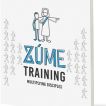
According to the World Economic Forum, as of 2023, “there are more mobile phones in the world than people,” 1 and over 90% of the world’s population owns one. In the life of a mobile phone, very few moments are comparable to the desperation of its owner clinging to the device when a crisis or disaster hits. Disasters burst open the digital doors of caring for people’s hearts and lives through the phones held tightly in their hands.
Spiritual receptivity and openness are frequently encountered on the ground while meeting physical and emotional needs. The same is true in the virtual space and can be reproduced rapidly through the phases of readiness, relief, recovery, and rebuilding. Readiness is the phase we live in before disaster strikes. Sometimes, we can anticipate an event such as a hurricane or monsoon season or conflicts stirring towards war; other times, disaster comes by surprise, such as an earthquake or insurgence. The readiness phase allows us to multiply disciples and churches, who can be prepared to steward the harvest in response to disasters and crises. We can follow the pattern Paul gave to Titus: Our people must learn to devote themselves to doing what is good in order to respond to urgent needs and not live unfruitful lives (Titus 3:14).
In the relief phase (first few weeks) after a disaster, a person might make dozens of calls for help, mark themself safe on social sites, or incessantly check for updates to find out if others are okay. Phones serve as a lifeline in efforts to collaborate and get resources to the right places. They also can function as a way to set up connections for the relief, recovery, and rebuilding phases, when emotional, physical, and spiritual needs are immense. In the transition from relief to recovery, as relief organizations phase out, people often are looking for spiritual community, and they wrestle with the hopelessness of the physical and emotional devastation.
Whether people have a phone that survived the disaster or they get one again as recovery becomes possible, digital strategies can be utilized significantly to love others and make disciples—through all the phases of disaster response. Parallel to boots-on-the-ground ministry in the wake of crises, digital doors briefly open much wider as communications and coping efforts reach their peak. In times of extreme distress, coping mechanisms of all kinds can emerge, such as excessive use of social media and pornography. Yet simultaneously, hearts also often turn, for a limited time, to searching for answers to life’s bigger questions. Spiritual hunger naturally surfaces when people are faced with events that give them a fresh perspective on life. At such times, many people cry out to God—who they may not know but who created them to have a relationship with Himself.
Genuinely loving people well involves addressing their physical, emotional, and spiritual needs—caring holistically, especially in times of crisis, since The LORD is near to the brokenhearted and saves the crushed in spirit (Ps. 34:18).
When Hurricane Ian hit southwest Florida in the fall of 2022, a few of us rallied several on-the-ground collaborations and made a simple graphic entitled, “Looking for hope in the aftermath of the hurricane?” Through a quick social media ad, it reached 22,000+ people, yielding several hundred engagements in the blink of an eye. This enabled us to connect respondents with local disciple-making communities. Digital media-to-movements strategies like this not only find interested people but also facilitate connections with on-the-ground disciples and churches ready to minister to them. As part of the redemptive outcomes after a tragedy, many, who previously would not have been open, start actively searching for prayer after a disaster. Those seekers represent a host of untapped possibilities for multiplying disciples and churches digitally during times of crisis or disaster.
One great resource for facilitating the transition from online to in-person discipleship is Zúme, a digital training that aims to saturate the world with multiplying disciples in our generation. It presents 32 biblical principles, such as eyes to see where God’s kingdom is not yet and finding a Person of Peace. Ordinary people can apply these principles, through the different disaster-response phases, to reach people at their point of felt need.
During recent lockdowns due to civil conflicts in Myanmar, when travel was forbidden in or around the villages, disciples used Zúme over Zoom to grow in loving God, loving others, and making disciples through the chronic crisis. Several removed the idols in their homes, and shared the Gospel while in the markets during the government- restricted window. They also began discipling others over WhatsApp because they realized they couldn’t wait for other leaders to do it for them. God used the crisis to change how the local church engaged in discipleship follow-up after relief distributions. They encouraged ordinary believers to obey the Scriptures as disciples, applying verses that previously had been overlooked or viewed as just for professionals. This paradigm shift multiplied breakthroughs as disciples applied and passed on what they had learned through Zúme.
Because disasters will certainly continue to come, Jesus’ disciples need to be ready. Therefore, training in the readiness phase, as with Zúme, equips people to make disciples in every season of life.
During the relief phase (first few weeks), disciples need to be ready to respond to prayer needs. In the recovery phase (next several months), disciples need to be prepared to share the Gospel and disciple in trauma-informed ways. During the rebuilding phase (the years after), disciples should be ready to serve and coach those affected by the disaster to become leaders who disciple others in ongoing relationships. As we walk with people through these phases, we can share with them a vision for being a disciple who makes disciples and a disciple worth multiplying. Utilizing foundational Zúme principles such as these during disaster response can help lead to long-term fruit, as the Lord wills. We can multiply disciples who transform communities through the recovery of God’s designs.
Digital strategies can be used in both event-based and ongoing responses to crises. For disaster-response organizations, churches, and ordinary disciples, digital strategies facilitate the spiritual feeding of the countless crowds hungry for God. At any given time, refugees speaking dozens of different languages are pouring into several nations—many of them coming with physical, emotional, and spiritual hunger. Because Zúme is available in 43 languages, disciple- makers are utilizing it effectively as a part of loving and caring in person for refugees who have come to their hometowns. Beyond our own backyards, those ministering to the diaspora have placed Google ads, quoting pieces of Zúme in various languages, to find people searching for God, and to connect, using Zúme over Zoom. This approach can reach both those nearby and those in other nations as part of digital strategies in the wake of acute disasters.
Across the globe, when the COVID-19 pandemic disrupted the world, tens of thousands of people added to the numbers of those making disciples who make disciples using Zúme on Zoom. Small groups went through Zúme’s 32 biblical principles as a pattern and paradigm for spiritual expression. This was especially valuable for those who had lost familiar spiritual patterns because of the loss of buildings or disruption of broader church relationships.
Gathering in small groups and going through Zúme during the recovery phase of a disaster or crisis event can provide much-needed relational connections with others, facilitate sharing resources together, and help meet the needs of those experiencing trauma. The 3-part discipleship pattern that Zúme trains can intentionally build community, faith, and purpose, which are necessary for recovering from trauma. Whether the disaster is acute or chronic, it’s important to lean into new ways to meet together and spur each other on in pursuing Christ and teaching others to do so.
With the vast majority of the world holding internet-enabled mobile phones, it’s important to know that Zúme is free and can be accessed online (http://www.Zume.training). But the content also can be utilized in numerous other ways, including in remote areas without internet or situations that arise during crises and disasters. Renew World Outreach provides Zúme content pre-downloaded on solar-powered projectors, micro SD cards, solar-powered audio Bible players, and Lightstream file-sharing hotspots. The Zúme book can be distributed and apps can be used on Apple and Android phones to download the content so it is accessible without the internet. All these ways and more can be found on http://www.Zume.vision/articles These. can provide access in areas where infrastructure has been destroyed and give the ability to distribute content to strengthen disciples and churches with ongoing multiplicative use.
Believers need to equip themselves to respond quickly to opportunities that crises bring. This also builds their own resiliency with a biblical response to suffering. Live training and Zúme coaches also are available across the globe to walk alongside people who have internet access. When crisis rings, Zúme disciple-making training can help disciples respond to the call, with digital strategies and on-the-ground principles that are rapidly multiplying around the world.
This is an article from the November-December 2023 issue: Movements Accelerating through Crisis Response
October 31, 2023 by Dr. Mary Roberts and Dr. Curtis Sergeant
Movements Responding to Crises
24:14 Goal: Movement Engagements in Every Unreached People and Place by 2025 (26 Months)

Screenshot of live map from October 1, 2023. Even more crises are being responded to live that are not shown on the map (due to politics) including in India, China, and others.
http://www.acaps.org/en/countries/
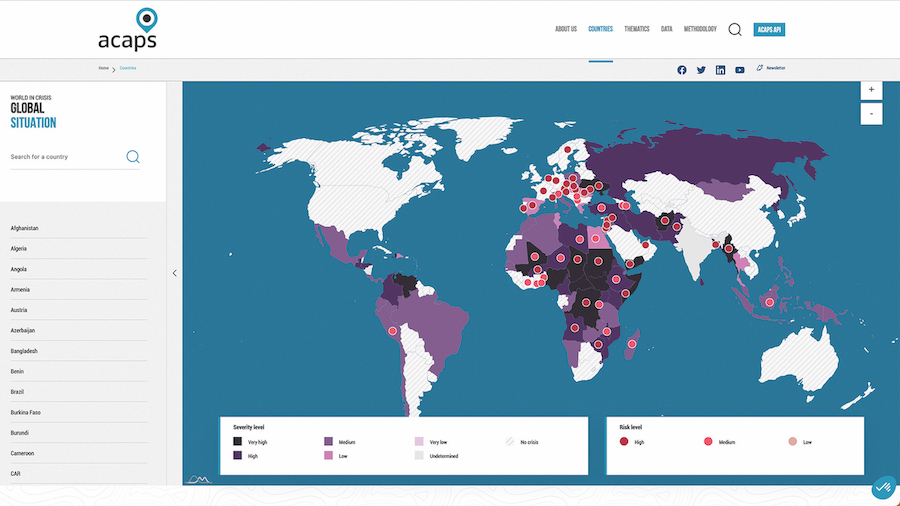
As you read this article, disasters and crises are pounding the unreached world, with people crying out. Even if you read this article days, months, or even years after the publication date, this is undoubtedly still true. Right now, dozens of significant crises are occurring—both chronic and acute, often with the greatest amount of destruction occurring in places with the least Gospel saturation.
Yet, ironically, many of these same places are experiencing accelerated kingdom multiplication. Overlaying live disaster response on a map with current locations of Kingdom Movements and remaining unreached peoples often highlights the same areas of the world. Kingdom Movements are beginning and increasing amid disasters. Disciples and churches are responding rapidly and lovingly with a long-term vision to care—not just through relief but also through recovery and rebuilding to sustainability.
Crises and disasters have increased significantly in the last few decades, just as movements have multiplied exponentially. A recent article in Forbes1 cites a United Nations statistic that five times as many natural disasters are occurring now as were occurring 50 years ago. U.N. peacekeepers on active missions for civil unrest and peace pursuits have increased nearly 10 times in the last 50 years.2 At the same time, Kingdom Movements have gone from a few known movements in the 1990s to 1,965 today, reaching more than 1.4% of the world’s population and still growing, according to the 24:14 collaborative research team. One researcher commented, “Movements are sometimes doubling out of crisis response efforts,” with the disciples and churches multiplying. As urgent needs have increased, so has kingdom fruitfulness. As Paul wrote to Titus, Our people must learn to devote themselves to doing what is good in order to respond to urgent needs and not live unproductive lives (Titus 3:14, NIV).
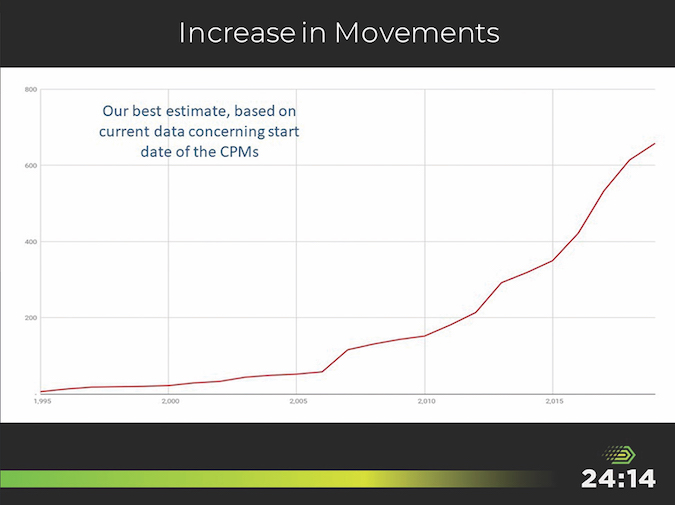
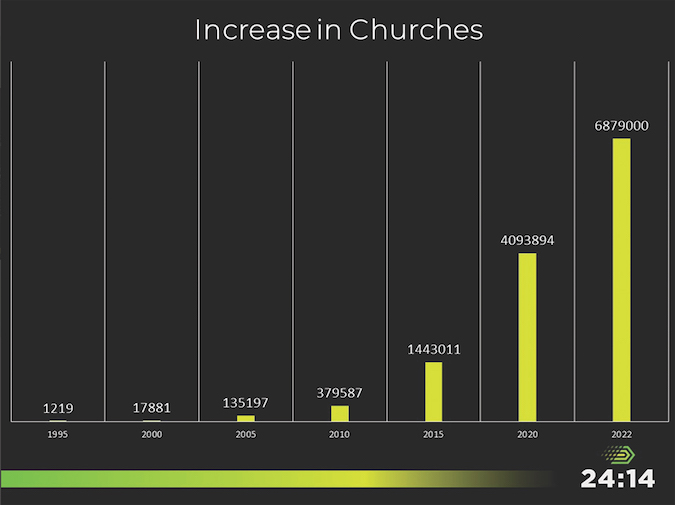
www.2414now.net/resources (View the Dashboard Update or email [email protected] to connect.)
As we anticipate the fulfillment of Matthew 24:14, and this gospel of the kingdom will be preached in the whole world… (NIV), several verses lead up to the “and.” One of those is Matthew 24:7 which describes major challenges preceding the fulfillment of verse 14: Nation will rise against nation, and kingdom against kingdom. There will be famines and earthquakes in various places. The 24/7 reality of disasters and crises currently being responded to can prompt us to pray 24/7 toward Matthew 24:14.
From Genesis to Revelation, we see that God frequently uses crises like the man-made and natural disasters mentioned in Matthew 24:7 to advance His kingdom, move His people around, and turn people back to Him. For example, the Exodus saga of God’s people journeying through man-made and natural disasters towards the promised land. Then the series of kings and prophets, as the wars they fought and the disasters they faced turned people back to God and gave Him glory. Similarly, Jesus’ miracles often took place in response to chronic or acute crisis moments in the lives of the disciples or community. This brings us to the Church in Acts and its responses to persecution, prison, famine, storms, and more as the Church grew and the movement Jesus started continues today. Crisis response has been an evident part of the Church historically since Acts. In our time, disciples have responded compassionately to urgent needs during wars, epidemics, and natural disasters.
As disciples in Kingdom Movements love one another, the biblical principles guiding their lives can easily be applied in a disaster context. As a result, in the wake of a disaster, they are finding receptivity paired with reproducibility. The movements are thriving even as man-made and natural disasters rise, with more than 115 million disciples in such movements globally, according to the current 24:14 Dashboard. During the recent COVID-19 pandemic, most (if not all) movements engaged in reaching out to the least, the last, and the lost in creative ways. Through follow-up during relief and recovery, out of love for God and people, disciples across the globe saw significant multiplication of fruitfulness. During the pandemic, Stan Parks (Church Planting Movements coach) wrote: “God is not surprised by this crisis. But we may be surprised by how He will use it.” Accelerated multiplication in the recovery and rebuilding phases did not happen immediately, but rather as a result over time of loving God and expressing love for others through concrete action. The pandemic sparked many to realize the potential and tangible impact when we have eyes to see God opening doors through a crisis, and we are willing to join in His work.
Examples of crisis response by disciples in movements
Currently, disciples in Kingdom Movements are responding to disasters in various parts of the world—disasters that may be in the news for just a short time at the start or never make the news at all, including in their own countries. For example, Turkish and Syrian disciples continue to care for believers and those from other faiths, as the acute earthquake of February 2023 turns into a chronic crisis. Sudanese refugees flooding surrounding nations are being met by collaborative groups of disciples and churches seeking to help. They create within the camps small communities that care for one another physically, emotionally, and spiritually. Ukrainian and Russian disciples are caring for the wounded on both sides of the border, equipping would-be refugees for the journey before they flee. They are educating people on how to identify and avoid human trafficking as it sweeps their land and strengthening one another as the war rages on.
Pakistanis are coming to one another’s aid, and Indians around Manipur are visiting fellow believers after painful persecution. Nigerians are hosting in their homes fellow believers who have fled terrorism. Ethiopian and Somali believers are bringing food to one another during the famine. Burmese and Thai believers are finding creative ways to get aid to the least of society in the midst of devastating conflicts and cyclone damage.
These are just a few examples of ministry happening right now around the globe. As we eat, sleep, go to work, and come home, these crises and disasters are the “normal life” of a vast number of believers across the world, with acute crises consistently compounding the chronic crises and complexities. Practically the whole 10/40 window experiences perpetual natural and man-made disasters and crises.
Hebrews 13:3 (NLT) exhorts: Remember those in prison, as if you were there yourself. Remember also those being mistreated, as if you felt their pain in your own bodies. How often does the empathy instructed in Scripture inform our strategies and responses? One local movement leader in Central Asia shared that they began responding to disasters because the people he was discipling came to him saying, “We need to go help those affected by the wildfires because they are hurting and we have been called to love and help one another.”
In Nepal, a movement leader echoed the reaction of Joseph in the Bible, who led a nation in disaster response during a chronic seven-year famine, telling his brothers, You intended to harm me, but God intended it for good to accomplish what is now being done, the saving of many lives (Gen. 50:20). This Nepali movement leader shared that through the 2022 earthquake, they saw the reconciliation of disciples with those who had persecuted and ostracized them. As they shared the little relief supplies they had, to help those who had hurt them, God used forgiveness and acts of kindness to touch the hearts of their former persecutors. As the stories of the disciples’ kindness spread, many others in the community began to follow Jesus. The local networks of these leaders now make go-bags with extra supplies from the means they have, in order to increase their resilience to be able to quickly help others. Shifting from reactive crisis response to a proactive approach, several Kingdom Movements are preparing to make the most of the next opportunities to come. In similar ways, many also have created basecamps (self-sustaining community areas) that serve as homes of refuge in times of disaster.
Kingdom Movements are engaging in relief that guards against dependency, in part due to sensitivity concerning when to shift from relief to recovery. Across the phases of disaster response, observation and timing are crucial. The relief phase typically lasts two to four weeks, focused on preventing more people from dying. Then the recovery phase lasts an average of six to 15 months, focused on putting resources and structures in place to function again in a new normal. Finally, the rebuilding phase can last for years or decades. (See graph in P.R.E.P.A.R.E. article).
From a disciple’s point of view, the goal is to recover glimpses of God’s design by applying kingdom principles to restore a community to a situation better than it was before. Examples of this might include multiplying cooperative businesses to sustain community transformation, and applying improved farming techniques, clean water, or hygiene into regular practice in the post-disaster community. These happen in tandem with multiplying disciples and churches who love God and love others.
Unique features of movement disciples’ response to crises
Kingdom Movements pursue not only multiplication of disciples but also being disciples worth multiplying. The depth of discipleship in life and community transformation cultivates quality in the character of the leaders being multiplied. In disaster and crisis response, this has been evidenced by the disciples as they have responded to hardship in ways contrasting with the world’s reactions to suffering. As a result, many have been drawn to the light of Jesus, as disciples have brought peace in the midst of chaos, given sacrificially while others hoarded, upheld integrity in the midst of corruption, shared hope amid devastation, and followed God’s redemptive ways.
A traditional approach to crisis management is no longer sufficient for today’s problems.3 Since Kingdom Movements are decentralized, they don’t respond to disasters in traditional, centralized ways. Multiplicative kingdom approaches address humanitarian response challenges in several ways. Their decentralized movement structure allows for a quicker response to disasters. As leaders and small groups respond, it also draws less attention than the large centralized groups. Research has found both a need and a challenge to increase community engagement in the system of responses.4 Kingdom Movements’ response consistently mobilizes a mass of volunteers, often from among those affected by the disaster. This becomes one of their major resources for building capacity, while maintaining a decentralized structure. Rather than a widespread individual focus, Kingdom Movements quickly form small groups and mobilize those affected as one of the greatest resources. This puts them ahead of the curve, according to some humanitarian-response research that shows a significant gap in research on mobilization from within a crisis context.5
Tackling crisis response through collaborative effort is not new. However, forming new small groups, networks, and collaborative tools such as leadership development during crisis response is now seen as a phenomenon for further study according to the research.6 The small groups formed out of one disaster response become the response team for the next disaster in or near where they live. They are then able to serve and equip across a network of regional leaders, creating a nationwide response force.
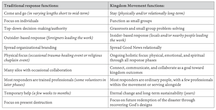
A disciple is someone who hears, acts on what they have heard, and shares it with others. Kingdom Movements mobilize ordinary people to respond to disasters and crises. They equip disciples, both from within the disaster area and from nearby, to join God in responding to a crisis in some useful way. While existing-church resources such as buildings, budgets, and paid staff can be helpful in crisis response, they are not required for responding to disasters in love, humility, and wisdom.
Disaster response calls for “all hands on deck,” including both centralized and decentralized structures that can partner together in various ways. For example, many times large organizations with supplies have partnered with a Kingdom Movement as the local distribution network on the ground. The context of a crisis intensifies the need to connect, communicate, and collaborate across structures, societal boundaries, and diverse experiences. Collaboration can accelerate and increase effectiveness through working together, and many movement leaders have learned that collaboration can happen at varying degrees with different groups. Not all groups are equally compatible and helpful as partners in the same ways.
Brothers and sisters in non-Western cultures often grasp well the biblical twin foundations of Great Commandment and Great Commission. In many unreached nations, following these two together constitutes a normal way of life, with minimal bifurcation between being Jesus’ hands and feet and proclaiming the Good News of God’s kingdom.
We need to note that disaster response is not neutral ground. Corruption advances rapidly, with some people wanting to take advantage of those who are vulnerable, isolated, and desperate. As Jesus said in John 10:10 (NIV), The thief comes only to steal and kill and destroy; I have come that they may have life, and have it to the full. This compels us all the more to bring God’s kingdom through multiplying disciples and churches that build community, faith, and redemptive purpose among those affected by the disaster.
Kingdom Movements respond to crises on the foundations of God’s Word and His Spirit, with a biblical perspective on suffering. No story or idea in the world can sustain people through the trials and temptations of disasters as effectively as knowing the word that sustains the weary (Isa. 50:4). In the metanarrative of the movement of God, disciples continue to respond to crises and disasters readily today, as seen throughout Scripture. We praise God for the many ways disciples in today’s Kingdom Movements are responding biblically by recognizing crises as door openers for demonstrating and proclaiming the kingdom of God. As brothers and sisters in other countries learn to devote themselves to doing what is good in order to respond to urgent needs (Titus 3:14), how ready are we to partner with them in their strategic work? And how ready are we to prepare ourselves for responding to unique opportunities, as crises happen in our own local contexts?
Endnotes
Hart, Robert. “Weather-Related Disasters Skyrocketed Fivefold Over Past 50 Years, Says U.N. Weather Agency.” http://www.forbes.com/sites/ roberthart/2021/09/01/weather-related-disasters-skyrocketed-fivefold-over-past-50-years-says-un-weather-agency/?sh=2c9d895358e9.
“Our World In Data,” United Nations peacekeepers on active missions graph, https://ourworldindata.org/war-and-peace
Mitroff, I., “From Crisis Management to Crisis Leadership” in Business: The Mixed Methods Approaches, ed. J. Law (A&C Black, 2011).
Sufri, S., Dwirahmadi, F., Phung, D., and Rutherford, S. 2020 “Enhancing community engagement in disaster early warning system in Aceh, Indonesia: opportunities and challenges.” Natural Hazards.
Dos Santos, R. A. S., Mello, R. B.-, and Cunha, C. J. C. de A. 2016 “The Leadership Process During an Organizational Crisis.” Journal of Operations and Supply Chain Management.
Aung, T. M., and Lim, S. 2021 “Evolution of Collaborative Governance in the 2015, 2016, and 2018 Myanmar Flood Disaster Responses: A Longitudinal Approach to a Network Analysis.” International Journal of Disaster Risk Science.
This is an article from the SEPT/OCT 2023 issue: Arts, Worship, and Mission in Today’s Church
September 01, 2023 by ROBIN SMITH
Praying through 12 Common Characteristics of Disciple Making Movements
Reprinted with permission from EMQ January–March 2023 | Volume 59 Issue 1

24:14 Goal: Movement engagements in every unreached people and place by 2025 (28 months)
Lord, lead us as we pray!
1. Extraordinary Prayer. In every known movement around the world, prayer plays a vital role. Prayer must be the foundation for any plan to reach a people group. Thus, the health of the messenger’s personal prayer life is crucial. The new church and its leaders will imitate the prayer life they see in the messenger.
ï Pray for God to enable laborers in the harvest fields to walk in intimate conversational relationship with Him, so they bear much fruit that remains, for His glory (John 15:4–8).
ï Pray that God’s people will not grow weary in doing good: in this case, the good work of prayer (Matt. 7:7–11).
ï Pray that God’s people will have His heart for the lost for whom they pray. This is Jesus’ pattern (Matt. 9:36–38).
ï Pray for God’s people to pray boldly, as commanded in Luke 18:1–8.
2. Authority of Scripture. In every known movement around the world, the Bible is the unquestioned authority and guiding force for the disciples—concerning everyday life, doctrine, and policy. This is true even in non-literate cultures, where the Bible is received and shared through oral storytelling.
ï Pray that all who labor in the harvest will base their lives on Jesus and His word, being obedient doers, not forgetful hearers or hearers only (James 1:19–25).
ï Pray for God’s Word to reach every people group in their own heart language. Pray that the Word would spread rapidly and be honored among all, because God’s Word is the source to thoroughly equip disciples for every good work (2 Thess. 3:1; 2 Tim. 3:16–17).
ï Pray for laborers and disciples living and working among least-reached peoples to have their ears and hearts open to the Lord’s Word, so that when He shows them things to change, stop doing, or start doing, they will obey (Heb. 4:12).
3. Abundant Gospel Sowing. In every known movement around the world, messengers and first disciples generously tell others about Jesus. They share boldly about Jesus and His goodness—with their families, neighbors, coworkers, and friends.
ï Pray for God’s children living and working among the world’s least-reached peoples, to not grow weary in generously sowing Gospel seed among the lost (Matt. 13:3–8; 2 Cor. 9:6).
ï Pray for God’s Spirit to enable all who labor in the harvest to boldly witness—in season and out of season (Acts 4:18–20, 29–30; 2 Tim. 4:2).
ï Pray for priority to be given to proclaiming the good news (Luke 15:3–7).
4. Intentional Gathering. In every known movement around the world, lost people are discipled in groups even before the movement begins, usually before they fully respond to the Gospel. Why? It is more effective to gather-then-win than to win-then-gather.
ï Pray for disciples of Jesus to reach out to groups of people, no matter how small, instead of just individuals (Luke 10:5–7). Group decisions fit the common biblical pattern (Acts 10:24, 33, 44, 48;
16:14–15; 31–33) and provide strength (Ecc. 4:12).
ï Thank God that where two or three gather in His name, Jesus is there with them (Matt. 18:19–20).
ï Pray that disciples of Jesus will boldly ask lost people if anyone in their household or community of friends would also like to hear Good News (Acts 16:31–34).
ï Ask God to show His children (including us) who in their lives might like to be discipled as a group, no matter how small.
5. Every Member a Minister. Movements around the world emphasize and encourage the priesthood of all believers. Every follower of Jesus has gifts that he or she is expected to use, to strengthen others and extend the impact of God’s kingdom here on earth.
ï Pray that disciples of Jesus in unreached places will obey His command to make disciples (Matt. 28:18– 20). This task is not just for a select few.
ï Pray that disciples of Jesus in unreached places would boldly exercise the gifts God has given them (1 Peter 4:10; Eph. 4:11–12).
ï Pray for the hundreds of thousands of “Paul-Timothy” relationships currently existing in unreached places, among both men and women. Pray that Timothys would quickly become Pauls, and Pauls would quickly become Barnabases (1 Timothy 1:2; Acts 9:27; 11:25–26).
6. Bivocational Lay Leaders. Movements around the world rely on lay leaders who work “normal” jobs in addition to the work of ministry. This helps to prevent leadership shortages caused by relying on seminary- trained or highly educated leaders. Spiritual leaders are developed through on-the-job training rather than institutional learning.
ï Pray for God to multiply Christ-following leaders in every time zone (1 Thess. 2:4–12).
ï Pray for God to give energy and strength to His children (Ps. 29:11).
ï Pray for God to give wisdom and diligence to His children as they do various kinds of work (Acts 18:3; Col. 3:23).
7. House Churches. Most of the churches in Disciple-Making Movements are small, reproducible fellowships of 10–30 members. They meet in homes, stores, coffee shops, or under trees—the normal gathering places in their societies. Many small fellowships dispersed throughout a city or community have a greater impact than a large, centralized group.
ï Pray for disciple makers to stop inviting lost friends and neighbors to Christian activities, and to instead plant God’s kingdom within households of lost people, as Peter did in Acts 10:22–48.
ï Pray for God to multiply and strengthen house churches (simple churches) throughout UPGs, as we see in Rom. 16:5; Col. 4:15; and Philemon 2.
ï Pray Romans 16:17–20 for house churches all over the world.
8. Disciples Making Disciples. Biologically, shepherds can’t produce sheep. Sheep produce sheep. Disciple- Making Movements apply this biological truth spiritually. In the over 1,900 movements that exist today, local followers of Jesus (simple sheep) actively disciple their lost friends and family, planting new churches. How? When lost people become followers of Jesus, they quickly obey His command to produce more “sheep.” Thus, more laborers are found in the harvest.
ï Pray for God’s people all over the world to follow the Good Shepherd’s example and step out of their comfort zone to pursue lost sheep (Luke 15:3–7).
ï Ask God to forgive us, His Body, for relegating His disciple-making command and promise (Matt. 28:18–20) to trained and/or paid professionals. Pray for disciples of Jesus in both reached and unreached places, that we will all believe His promises and personally obey His command.
ï Pray 1 Pet. 2:24–25 for the world’s UPGs.
9. Sense of Urgency (Rapid Reproduction). In movements, maintaining focus on the task is essential. Jesus said the harvest is plentiful, but the laborers are few (Matt. 9:35–38). He then instructed His disciples to pray for more laborers to bring in the harvest.
ï Ask God to forgive us, His Body, for getting distracted from the harvest. We spend most of our time, energy, and money where the harvest is already being harvested. Meanwhile, Matthew 9:37 remains true for 42.5% of the people groups of the world (joshuaproject.net).
ï Ask God to give His children (both those living in reached places and those living among the unreached) boldness and courage to sow seed broadly, not sparingly (Matt. 13:3–8; 2 Cor. 9:6).
ï Ask God to raise up many disciples in unreached places who will follow the example set in Mark 5:19.
ï Ask God for Matthew 24:14 to finally be fulfilled in our lifetime.
10. Simple Church. In the New Testament, being a church didn’t involve special buildings, seminary-trained leaders, or institutions. The church was (and is intended to still be) a group of Jesus’ followers who base their lives on Jesus and His Word. This involves encouraging each other to live lives of worship to Him, witnessing to the world, baptizing new followers, teaching and encouraging each other to obey all of Jesus’ commands, and sharing to meet needs.
ï Pray for the Spirit to work in every gathering of followers of Jesus around the globe, that Jesus’ light might shine brightly throughout the earth (Luke 11:13).
ï Pray that the house churches in movements would follow the example of the first followers in Acts 2:42.
ï Pray for God’s protection over the churches that have started through movements, that they will continue to find unity in humility (Phil. 2:1–4).
11. Enduring through Suffering. Disciple-Making Movements often emerge in places where following Christ is costly and may lead to suffering or even death. Followers of Christ understand that in the world we will have tribulation, but Jesus has overcome the world. Those who bear fruit are pruned, so they can become more fruitful for God’s glory.
ï Pray that Jesus’ promise in Luke 22:28–30 would ring loudly in the hearts of all disciples suffering persecution today.
ï Pray for God’s children to endure and have courage to persevere through trials (Heb. 12:1–3).
ï Pray James 1:2–18 for all who are currently suffering for the sake of the Name.
12. Signs and Wonders often Accompany Proclamation of God’s Word. All disciples of Jesus are com- manded to proclaim the kingdom in the authority of Jesus (Matt. 28:18–20). In current movements, as followers of Jesus boldly proclaim the Gospel, the Lord very often confirms the message with signs and wonders. This is one way God convicts lost people to believe in Him (Deut. 4:34–35).
ï Ask for followers of Jesus in unreached places to boldly pray for manifestation of God’s kingdom, including signs and wonders accompanying Gospel proclamation (Mark 16:20).
ï Pray for God’s children to be bold enough to ask for the “impossible” so that many will believe (Matt. 17:20; John 14:12).
Endnotes
These characteristics overlap significantly with (but are not identical to) David Garrison’s “Ten Universal Elements” found in every Church Planting Movement. Church Planting Movements, How God Is Redeeming a Lost World (Midlothian, VA: WIGTake Resources, 2004), pp. 171ff.
This is an article from the SEPT/OCT 2023 issue: Arts, Worship, and Mission in Today’s Church
September 01, 2023 by
Unreached of the Day
This is the new Global Prayer Digest which merged with Unreached of the Day in 2021

Click on the .pdf icon to read the Unreached of the Day for September-October 2023.
This is an article from the SEPT/OCT 2023 issue: Arts, Worship, and Mission in Today’s Church
September 01, 2023 by STEVE ADDISON
Acts and the Movement of God:
An Interview with Author Steve Addison

Why did you write Acts and the Movement of God?
There’s a gap between the movement of God described in the pages of Acts and our experience, especially in the Western world. Luke wrote Acts to help us bridge that gap.
When Jesus rose from the dead, He encountered a band of disciples who were defeated and disillusioned. People just like us. Jesus took 40 days to turn them into a missionary movement that would go to the ends of the earth. He wants to do the same for us today.
What is the book of Acts about?
Acts is more than a book about the early Church. Acts is about God—Father, Son, and Holy Spirit. Luke tells us that what Jesus began to do in His Gospel, He continues to do in Acts through His people (Acts 1:1). God is the main character of the story, and His Word and Spirit are the driving force propelling that story forward. Angels appear, prophets speak, prison doors open, houses shake, thousands believe, persecutors fall to the ground, the Scriptures are fulfilled—God directs this mission. He calls His people into what He is doing.
What’s God’s agenda in Acts?
The Father’s plan is centered upon His Son, whose obedience to death brought forgiveness of sins and a restored relationship with Him. Now risen and enthroned, the Lord Jesus rules through the Spirit, who empowers the disciples to proclaim this salvation to every people and every place. At Pentecost, the outpouring of the Spirit reached its climax in the proclamation of the Word to the nations and the formation of the Church in Jerusalem. As the Word goes out, the Spirit forms those who repent and believe into the new people of God who are witnesses to the ends of the earth.
We live in a very different world. Is Acts still relevant?
There’s no other book like Acts. It ties together the coming of Jesus and His continuing mission through His Spirit-empowered disciples. Acts is a book about the unchanging God. Its relevance cannot be confined to the past.
The church in every generation must return to the book of Acts and find renewal in its identity and mission or else risk settling down.
You went looking for examples of the patterns of Acts lived out today. What did you find?
I found examples on every continent.
There’s a movement of disciples and churches in the red-light district of Mumbai, India. Every year, thousands of mostly Nepali women and girls are trafficked and forced to work as prostitutes. In the past four years, 300 women have been rescued from slavery by the Hilltop of Hope ministry. One hundred of them have been baptized and are following Jesus in simple churches. The churches are islands of hope, offering a community that accepts them and opens the door to a new way of life.
In the Middle East, two local workers were out praying for needs in a neighborhood controlled by Islamic militants. A man was healed and turned to Christ. Immediately, he started sharing his faith with friends and relatives. He met fierce persecution and had to flee, but everywhere he goes, he leaves behind small bands of new disciples gathering as churches.
What about in the Western world?
In London’s financial district, teams are heading out during their lunch break offering prayer and engaging people with the Gospel. About 200 people have come to faith. They meet for discipleship over coffee or lunch and workplace churches are forming and spreading from the city to the suburbs and to other global cities.
There are other examples in the book of movements emerging in Britain, Canada, and the United States.
How were you surprised by Acts?
In Acts, I was surprised how simple and concrete the mission of God is. Acts is all about the spread of God’s Word through the disciples, empowered by the Holy Spirit. The messengers are hard pressed, but the Word never takes a backward step. As the Word spreads, grows, and multiplies, the outcome is always new disciples and churches to the glory of God—every people, every place.
You see this on the day of Pentecost. The Spirit comes in power upon every disciple. The Word goes out and the fruit is disciples meeting across the city. Pentecost is not just the birth of a church but the birth of a missionary movement that is headed for the ends of the earth.
Why aren’t we heeding the lessons of Acts?
We all know there’s a gap between the movement of God in Acts and our experience. Facing that gap is uncomfortable; it implies radical change in our behavior. So we tell ourselves Acts doesn’t apply today. Our world is different. The tension is eased. We measure ourselves with ourselves and refuse to look into the mirror of God’s Word.
Acts was written to show us how God fulfills His mission in the world and how we are to play our part. We need to be disturbed about the gap between what we read in Acts and our current experience. Despair is a virtue if it drives us to the suffciency of God. He wants to inspire us to believe that what He did in Acts, He can do today. Around the world, it’s already happening.
Leave A Comment












 The Geographic Center of Unreached People Groups Weighted by Population
The Geographic Center of Unreached People Groups Weighted by Population 












































































comments